ENN591/ENN593 Project Report: Anti-Collision System in Healthcare
VerifiedAdded on 2022/11/26
|44
|11207
|51
Report
AI Summary
This project report, submitted for ENN591 and ENN593, investigates a smart healthcare anti-collision system designed to assist visually impaired individuals. The report explores the application of Radio Frequency Identification (RFID) and the Internet of Things (IoT) within healthcare settings, focusing on an indoor anti-collision alarm system. It delves into the challenges of implementing such a system, including issues related to data privacy, technical limitations, and management complexities. The report incorporates various management concepts, such as SWOT analysis, Pareto charts, and QFD, to analyze the system's effectiveness and identify potential areas for improvement. It also reviews the literature on smart healthcare and the use of RFID technology, discussing RSSI values and phase profiles for obstacle detection. The study proposes solutions to overcome these challenges, including the use of LWLR algorithms and fingerprint system designs. The report concludes with recommendations for enhancing the system's performance and usability, ultimately aiming to improve patient care and safety in healthcare environments. The report also touches on the need for smart healthcare systems through anti-collision alarm systems for the blind or poor eye-sighted patients, including the different management theories which have developed the smart Healthcare system and focused on the loopholes with better resolution.
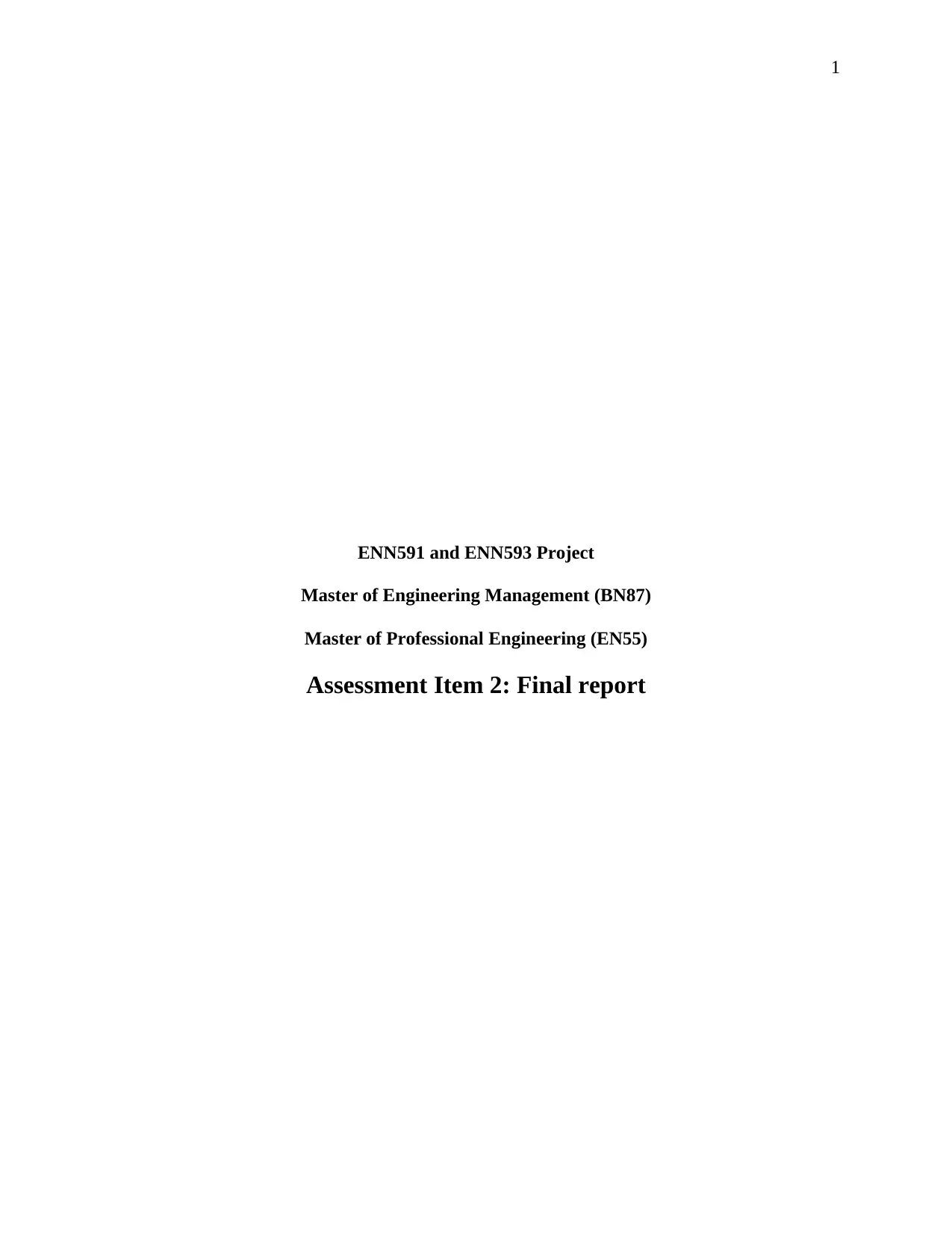
1
ENN591 and ENN593 Project
Master of Engineering Management (BN87)
Master of Professional Engineering (EN55)
Assessment Item 2: Final report
ENN591 and ENN593 Project
Master of Engineering Management (BN87)
Master of Professional Engineering (EN55)
Assessment Item 2: Final report
Secure Best Marks with AI Grader
Need help grading? Try our AI Grader for instant feedback on your assignments.
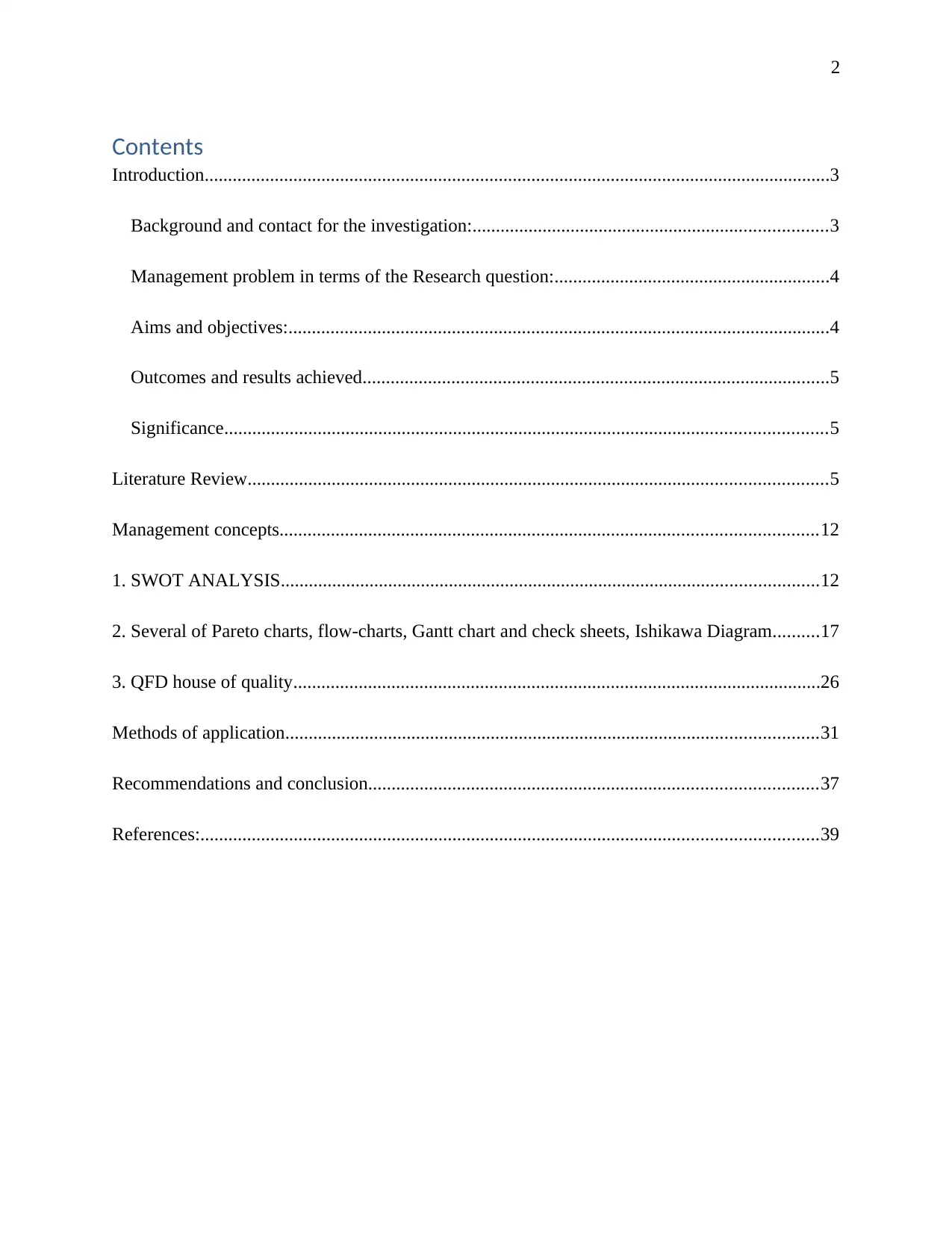
2
Contents
Introduction......................................................................................................................................3
Background and contact for the investigation:............................................................................3
Management problem in terms of the Research question:...........................................................4
Aims and objectives:....................................................................................................................4
Outcomes and results achieved....................................................................................................5
Significance.................................................................................................................................5
Literature Review............................................................................................................................5
Management concepts...................................................................................................................12
1. SWOT ANALYSIS...................................................................................................................12
2. Several of Pareto charts, flow-charts, Gantt chart and check sheets, Ishikawa Diagram..........17
3. QFD house of quality.................................................................................................................26
Methods of application..................................................................................................................31
Recommendations and conclusion................................................................................................37
References:....................................................................................................................................39
Contents
Introduction......................................................................................................................................3
Background and contact for the investigation:............................................................................3
Management problem in terms of the Research question:...........................................................4
Aims and objectives:....................................................................................................................4
Outcomes and results achieved....................................................................................................5
Significance.................................................................................................................................5
Literature Review............................................................................................................................5
Management concepts...................................................................................................................12
1. SWOT ANALYSIS...................................................................................................................12
2. Several of Pareto charts, flow-charts, Gantt chart and check sheets, Ishikawa Diagram..........17
3. QFD house of quality.................................................................................................................26
Methods of application..................................................................................................................31
Recommendations and conclusion................................................................................................37
References:....................................................................................................................................39
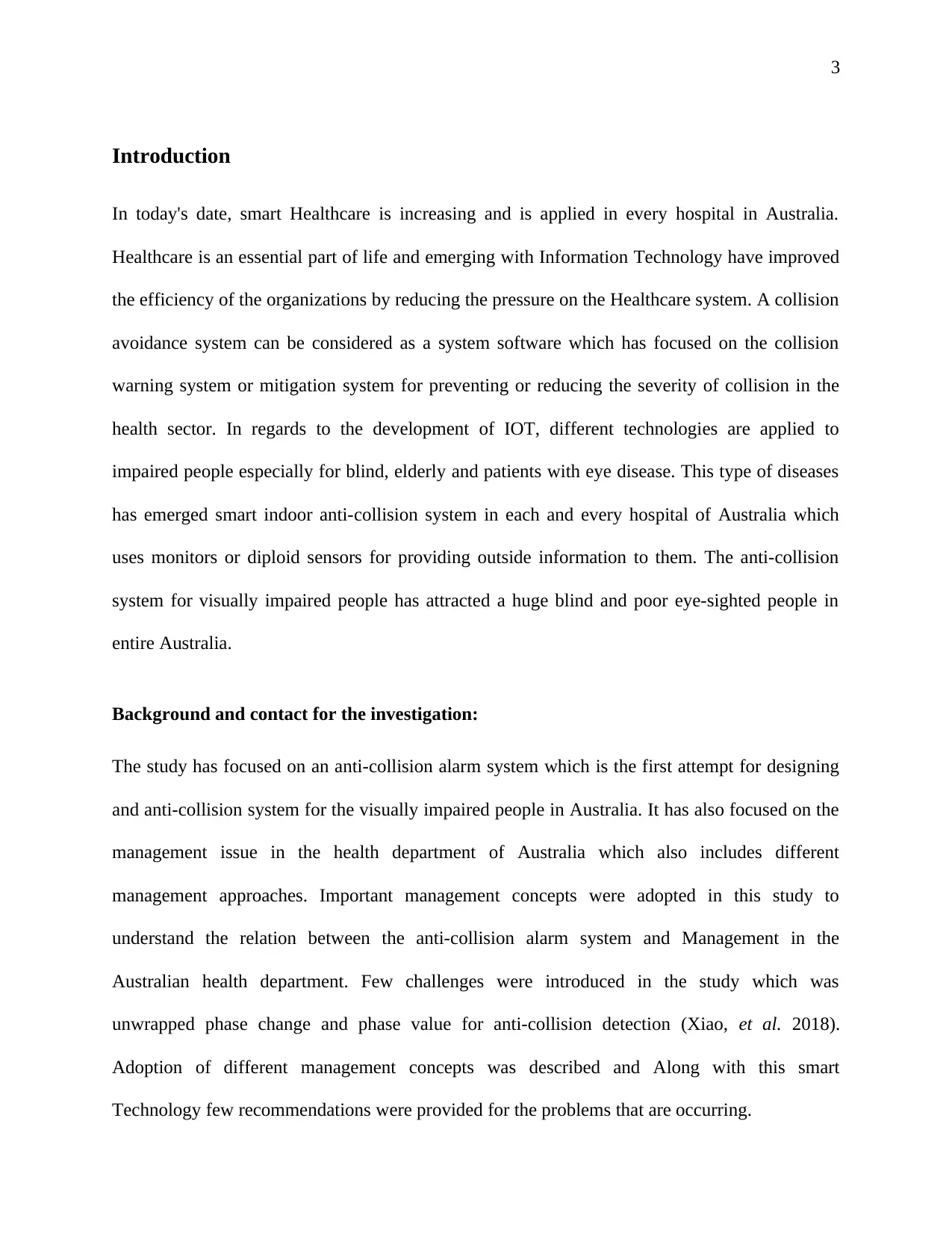
3
Introduction
In today's date, smart Healthcare is increasing and is applied in every hospital in Australia.
Healthcare is an essential part of life and emerging with Information Technology have improved
the efficiency of the organizations by reducing the pressure on the Healthcare system. A collision
avoidance system can be considered as a system software which has focused on the collision
warning system or mitigation system for preventing or reducing the severity of collision in the
health sector. In regards to the development of IOT, different technologies are applied to
impaired people especially for blind, elderly and patients with eye disease. This type of diseases
has emerged smart indoor anti-collision system in each and every hospital of Australia which
uses monitors or diploid sensors for providing outside information to them. The anti-collision
system for visually impaired people has attracted a huge blind and poor eye-sighted people in
entire Australia.
Background and contact for the investigation:
The study has focused on an anti-collision alarm system which is the first attempt for designing
and anti-collision system for the visually impaired people in Australia. It has also focused on the
management issue in the health department of Australia which also includes different
management approaches. Important management concepts were adopted in this study to
understand the relation between the anti-collision alarm system and Management in the
Australian health department. Few challenges were introduced in the study which was
unwrapped phase change and phase value for anti-collision detection (Xiao, et al. 2018).
Adoption of different management concepts was described and Along with this smart
Technology few recommendations were provided for the problems that are occurring.
Introduction
In today's date, smart Healthcare is increasing and is applied in every hospital in Australia.
Healthcare is an essential part of life and emerging with Information Technology have improved
the efficiency of the organizations by reducing the pressure on the Healthcare system. A collision
avoidance system can be considered as a system software which has focused on the collision
warning system or mitigation system for preventing or reducing the severity of collision in the
health sector. In regards to the development of IOT, different technologies are applied to
impaired people especially for blind, elderly and patients with eye disease. This type of diseases
has emerged smart indoor anti-collision system in each and every hospital of Australia which
uses monitors or diploid sensors for providing outside information to them. The anti-collision
system for visually impaired people has attracted a huge blind and poor eye-sighted people in
entire Australia.
Background and contact for the investigation:
The study has focused on an anti-collision alarm system which is the first attempt for designing
and anti-collision system for the visually impaired people in Australia. It has also focused on the
management issue in the health department of Australia which also includes different
management approaches. Important management concepts were adopted in this study to
understand the relation between the anti-collision alarm system and Management in the
Australian health department. Few challenges were introduced in the study which was
unwrapped phase change and phase value for anti-collision detection (Xiao, et al. 2018).
Adoption of different management concepts was described and Along with this smart
Technology few recommendations were provided for the problems that are occurring.
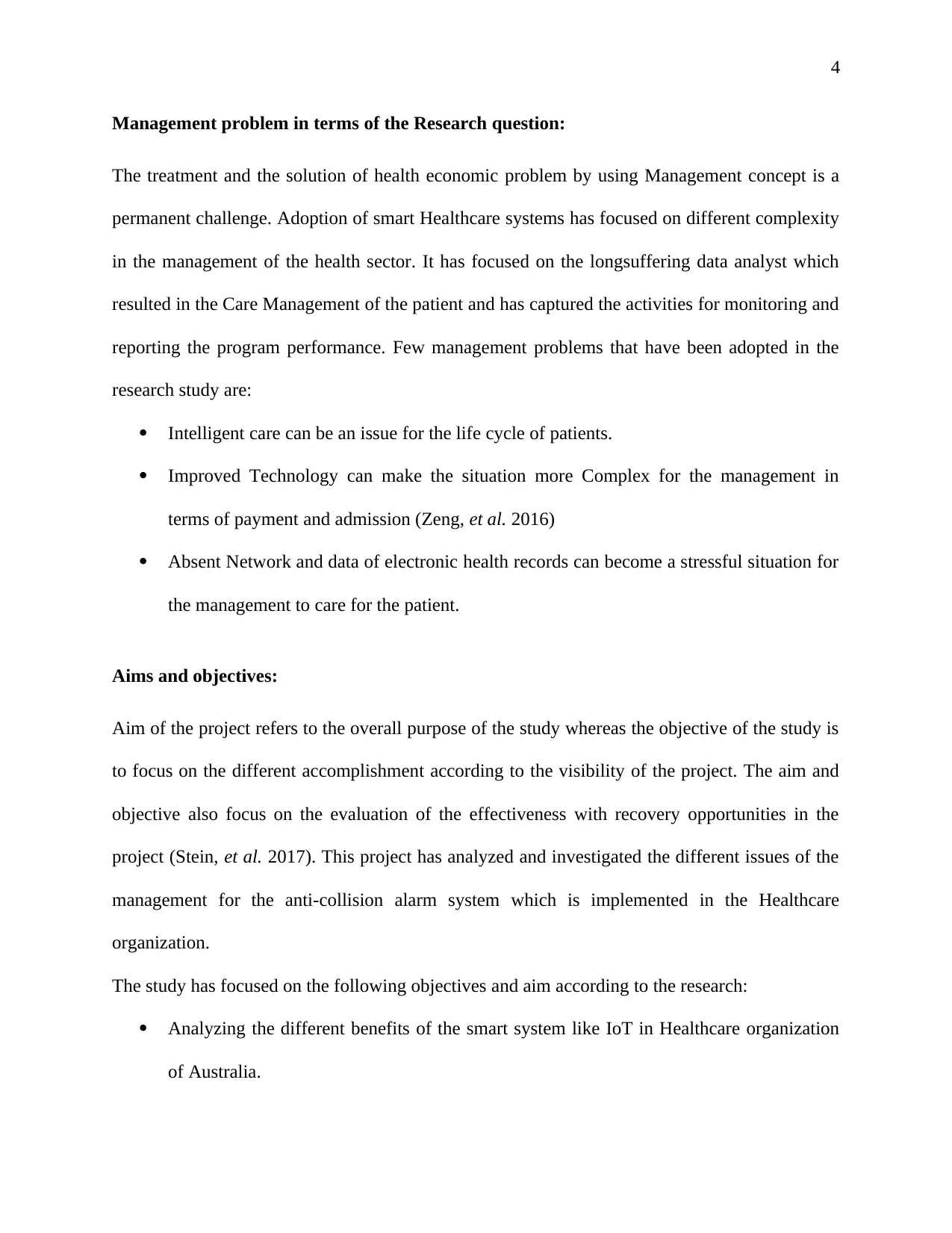
4
Management problem in terms of the Research question:
The treatment and the solution of health economic problem by using Management concept is a
permanent challenge. Adoption of smart Healthcare systems has focused on different complexity
in the management of the health sector. It has focused on the longsuffering data analyst which
resulted in the Care Management of the patient and has captured the activities for monitoring and
reporting the program performance. Few management problems that have been adopted in the
research study are:
Intelligent care can be an issue for the life cycle of patients.
Improved Technology can make the situation more Complex for the management in
terms of payment and admission (Zeng, et al. 2016)
Absent Network and data of electronic health records can become a stressful situation for
the management to care for the patient.
Aims and objectives:
Aim of the project refers to the overall purpose of the study whereas the objective of the study is
to focus on the different accomplishment according to the visibility of the project. The aim and
objective also focus on the evaluation of the effectiveness with recovery opportunities in the
project (Stein, et al. 2017). This project has analyzed and investigated the different issues of the
management for the anti-collision alarm system which is implemented in the Healthcare
organization.
The study has focused on the following objectives and aim according to the research:
Analyzing the different benefits of the smart system like IoT in Healthcare organization
of Australia.
Management problem in terms of the Research question:
The treatment and the solution of health economic problem by using Management concept is a
permanent challenge. Adoption of smart Healthcare systems has focused on different complexity
in the management of the health sector. It has focused on the longsuffering data analyst which
resulted in the Care Management of the patient and has captured the activities for monitoring and
reporting the program performance. Few management problems that have been adopted in the
research study are:
Intelligent care can be an issue for the life cycle of patients.
Improved Technology can make the situation more Complex for the management in
terms of payment and admission (Zeng, et al. 2016)
Absent Network and data of electronic health records can become a stressful situation for
the management to care for the patient.
Aims and objectives:
Aim of the project refers to the overall purpose of the study whereas the objective of the study is
to focus on the different accomplishment according to the visibility of the project. The aim and
objective also focus on the evaluation of the effectiveness with recovery opportunities in the
project (Stein, et al. 2017). This project has analyzed and investigated the different issues of the
management for the anti-collision alarm system which is implemented in the Healthcare
organization.
The study has focused on the following objectives and aim according to the research:
Analyzing the different benefits of the smart system like IoT in Healthcare organization
of Australia.
Secure Best Marks with AI Grader
Need help grading? Try our AI Grader for instant feedback on your assignments.
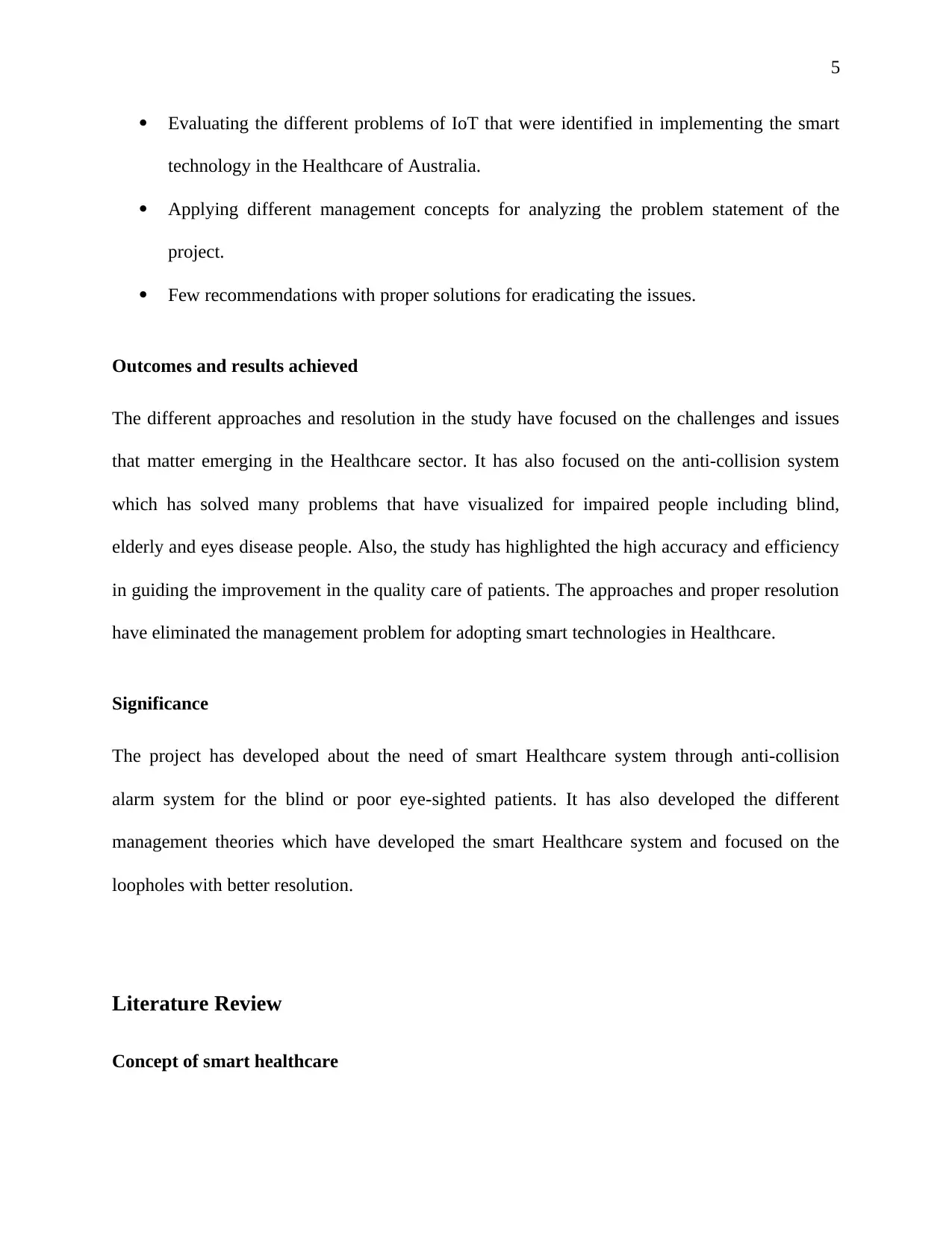
5
Evaluating the different problems of IoT that were identified in implementing the smart
technology in the Healthcare of Australia.
Applying different management concepts for analyzing the problem statement of the
project.
Few recommendations with proper solutions for eradicating the issues.
Outcomes and results achieved
The different approaches and resolution in the study have focused on the challenges and issues
that matter emerging in the Healthcare sector. It has also focused on the anti-collision system
which has solved many problems that have visualized for impaired people including blind,
elderly and eyes disease people. Also, the study has highlighted the high accuracy and efficiency
in guiding the improvement in the quality care of patients. The approaches and proper resolution
have eliminated the management problem for adopting smart technologies in Healthcare.
Significance
The project has developed about the need of smart Healthcare system through anti-collision
alarm system for the blind or poor eye-sighted patients. It has also developed the different
management theories which have developed the smart Healthcare system and focused on the
loopholes with better resolution.
Literature Review
Concept of smart healthcare
Evaluating the different problems of IoT that were identified in implementing the smart
technology in the Healthcare of Australia.
Applying different management concepts for analyzing the problem statement of the
project.
Few recommendations with proper solutions for eradicating the issues.
Outcomes and results achieved
The different approaches and resolution in the study have focused on the challenges and issues
that matter emerging in the Healthcare sector. It has also focused on the anti-collision system
which has solved many problems that have visualized for impaired people including blind,
elderly and eyes disease people. Also, the study has highlighted the high accuracy and efficiency
in guiding the improvement in the quality care of patients. The approaches and proper resolution
have eliminated the management problem for adopting smart technologies in Healthcare.
Significance
The project has developed about the need of smart Healthcare system through anti-collision
alarm system for the blind or poor eye-sighted patients. It has also developed the different
management theories which have developed the smart Healthcare system and focused on the
loopholes with better resolution.
Literature Review
Concept of smart healthcare
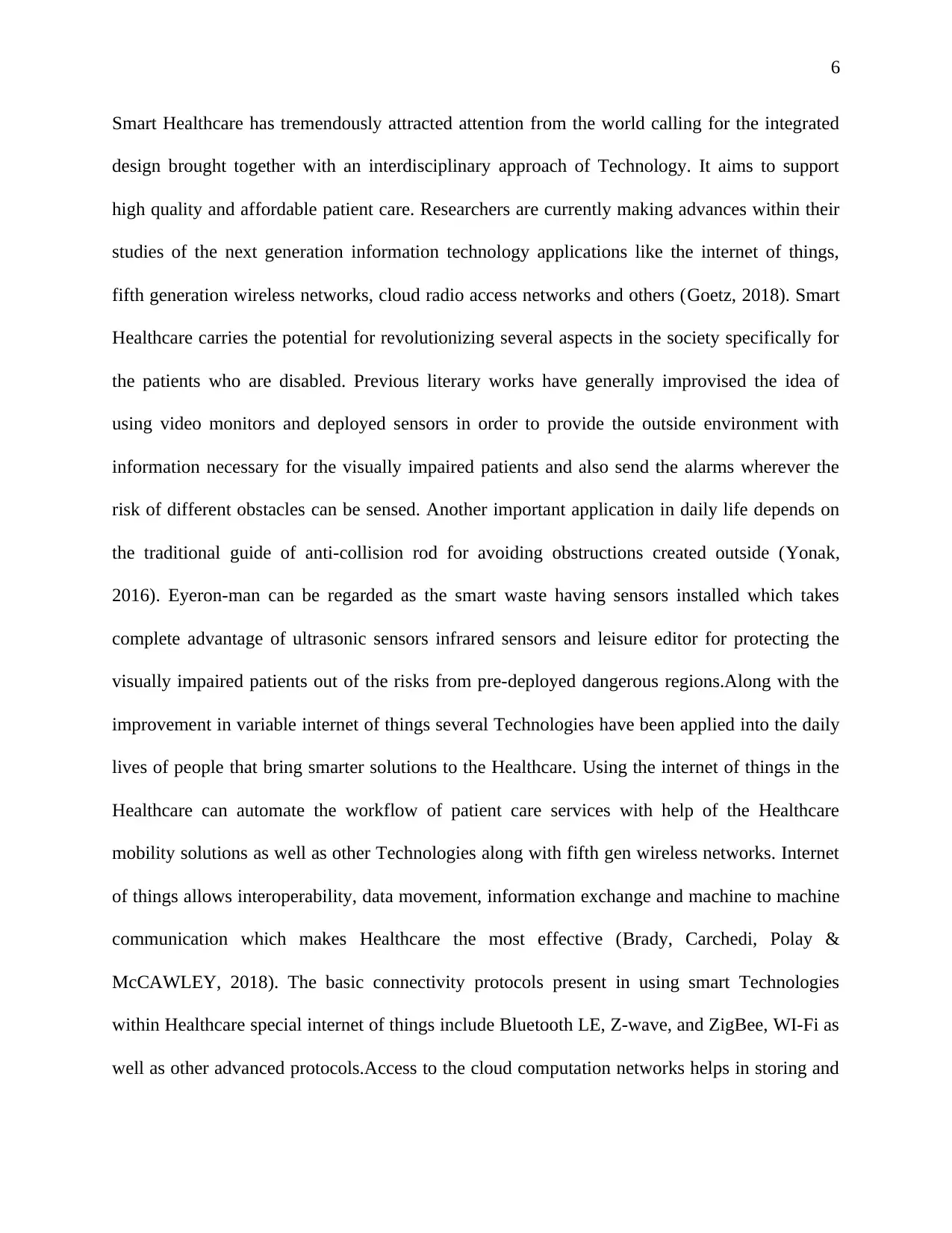
6
Smart Healthcare has tremendously attracted attention from the world calling for the integrated
design brought together with an interdisciplinary approach of Technology. It aims to support
high quality and affordable patient care. Researchers are currently making advances within their
studies of the next generation information technology applications like the internet of things,
fifth generation wireless networks, cloud radio access networks and others (Goetz, 2018). Smart
Healthcare carries the potential for revolutionizing several aspects in the society specifically for
the patients who are disabled. Previous literary works have generally improvised the idea of
using video monitors and deployed sensors in order to provide the outside environment with
information necessary for the visually impaired patients and also send the alarms wherever the
risk of different obstacles can be sensed. Another important application in daily life depends on
the traditional guide of anti-collision rod for avoiding obstructions created outside (Yonak,
2016). Eyeron-man can be regarded as the smart waste having sensors installed which takes
complete advantage of ultrasonic sensors infrared sensors and leisure editor for protecting the
visually impaired patients out of the risks from pre-deployed dangerous regions.Along with the
improvement in variable internet of things several Technologies have been applied into the daily
lives of people that bring smarter solutions to the Healthcare. Using the internet of things in the
Healthcare can automate the workflow of patient care services with help of the Healthcare
mobility solutions as well as other Technologies along with fifth gen wireless networks. Internet
of things allows interoperability, data movement, information exchange and machine to machine
communication which makes Healthcare the most effective (Brady, Carchedi, Polay &
McCAWLEY, 2018). The basic connectivity protocols present in using smart Technologies
within Healthcare special internet of things include Bluetooth LE, Z-wave, and ZigBee, WI-Fi as
well as other advanced protocols.Access to the cloud computation networks helps in storing and
Smart Healthcare has tremendously attracted attention from the world calling for the integrated
design brought together with an interdisciplinary approach of Technology. It aims to support
high quality and affordable patient care. Researchers are currently making advances within their
studies of the next generation information technology applications like the internet of things,
fifth generation wireless networks, cloud radio access networks and others (Goetz, 2018). Smart
Healthcare carries the potential for revolutionizing several aspects in the society specifically for
the patients who are disabled. Previous literary works have generally improvised the idea of
using video monitors and deployed sensors in order to provide the outside environment with
information necessary for the visually impaired patients and also send the alarms wherever the
risk of different obstacles can be sensed. Another important application in daily life depends on
the traditional guide of anti-collision rod for avoiding obstructions created outside (Yonak,
2016). Eyeron-man can be regarded as the smart waste having sensors installed which takes
complete advantage of ultrasonic sensors infrared sensors and leisure editor for protecting the
visually impaired patients out of the risks from pre-deployed dangerous regions.Along with the
improvement in variable internet of things several Technologies have been applied into the daily
lives of people that bring smarter solutions to the Healthcare. Using the internet of things in the
Healthcare can automate the workflow of patient care services with help of the Healthcare
mobility solutions as well as other Technologies along with fifth gen wireless networks. Internet
of things allows interoperability, data movement, information exchange and machine to machine
communication which makes Healthcare the most effective (Brady, Carchedi, Polay &
McCAWLEY, 2018). The basic connectivity protocols present in using smart Technologies
within Healthcare special internet of things include Bluetooth LE, Z-wave, and ZigBee, WI-Fi as
well as other advanced protocols.Access to the cloud computation networks helps in storing and
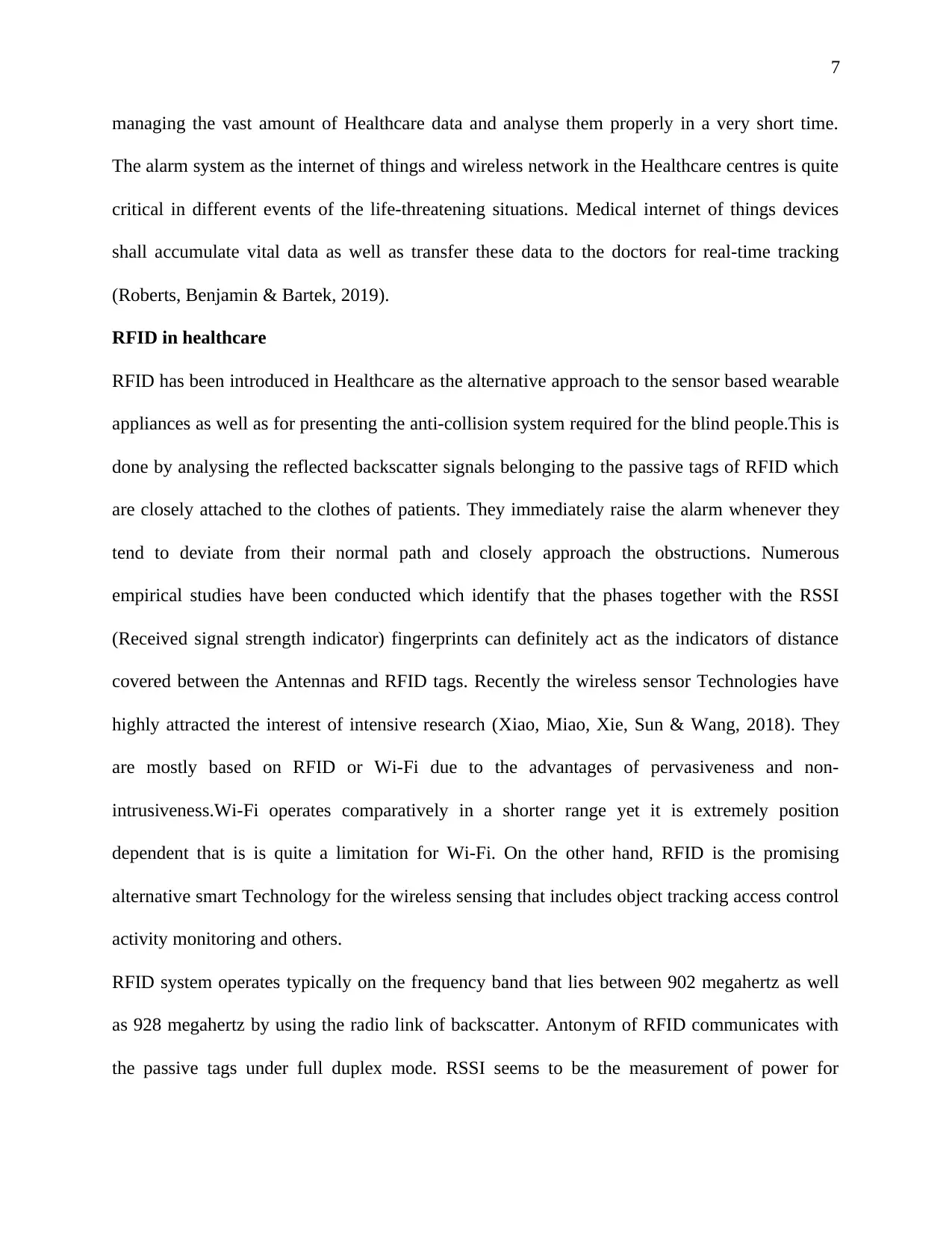
7
managing the vast amount of Healthcare data and analyse them properly in a very short time.
The alarm system as the internet of things and wireless network in the Healthcare centres is quite
critical in different events of the life-threatening situations. Medical internet of things devices
shall accumulate vital data as well as transfer these data to the doctors for real-time tracking
(Roberts, Benjamin & Bartek, 2019).
RFID in healthcare
RFID has been introduced in Healthcare as the alternative approach to the sensor based wearable
appliances as well as for presenting the anti-collision system required for the blind people.This is
done by analysing the reflected backscatter signals belonging to the passive tags of RFID which
are closely attached to the clothes of patients. They immediately raise the alarm whenever they
tend to deviate from their normal path and closely approach the obstructions. Numerous
empirical studies have been conducted which identify that the phases together with the RSSI
(Received signal strength indicator) fingerprints can definitely act as the indicators of distance
covered between the Antennas and RFID tags. Recently the wireless sensor Technologies have
highly attracted the interest of intensive research (Xiao, Miao, Xie, Sun & Wang, 2018). They
are mostly based on RFID or Wi-Fi due to the advantages of pervasiveness and non-
intrusiveness.Wi-Fi operates comparatively in a shorter range yet it is extremely position
dependent that is is quite a limitation for Wi-Fi. On the other hand, RFID is the promising
alternative smart Technology for the wireless sensing that includes object tracking access control
activity monitoring and others.
RFID system operates typically on the frequency band that lies between 902 megahertz as well
as 928 megahertz by using the radio link of backscatter. Antonym of RFID communicates with
the passive tags under full duplex mode. RSSI seems to be the measurement of power for
managing the vast amount of Healthcare data and analyse them properly in a very short time.
The alarm system as the internet of things and wireless network in the Healthcare centres is quite
critical in different events of the life-threatening situations. Medical internet of things devices
shall accumulate vital data as well as transfer these data to the doctors for real-time tracking
(Roberts, Benjamin & Bartek, 2019).
RFID in healthcare
RFID has been introduced in Healthcare as the alternative approach to the sensor based wearable
appliances as well as for presenting the anti-collision system required for the blind people.This is
done by analysing the reflected backscatter signals belonging to the passive tags of RFID which
are closely attached to the clothes of patients. They immediately raise the alarm whenever they
tend to deviate from their normal path and closely approach the obstructions. Numerous
empirical studies have been conducted which identify that the phases together with the RSSI
(Received signal strength indicator) fingerprints can definitely act as the indicators of distance
covered between the Antennas and RFID tags. Recently the wireless sensor Technologies have
highly attracted the interest of intensive research (Xiao, Miao, Xie, Sun & Wang, 2018). They
are mostly based on RFID or Wi-Fi due to the advantages of pervasiveness and non-
intrusiveness.Wi-Fi operates comparatively in a shorter range yet it is extremely position
dependent that is is quite a limitation for Wi-Fi. On the other hand, RFID is the promising
alternative smart Technology for the wireless sensing that includes object tracking access control
activity monitoring and others.
RFID system operates typically on the frequency band that lies between 902 megahertz as well
as 928 megahertz by using the radio link of backscatter. Antonym of RFID communicates with
the passive tags under full duplex mode. RSSI seems to be the measurement of power for
Paraphrase This Document
Need a fresh take? Get an instant paraphrase of this document with our AI Paraphraser
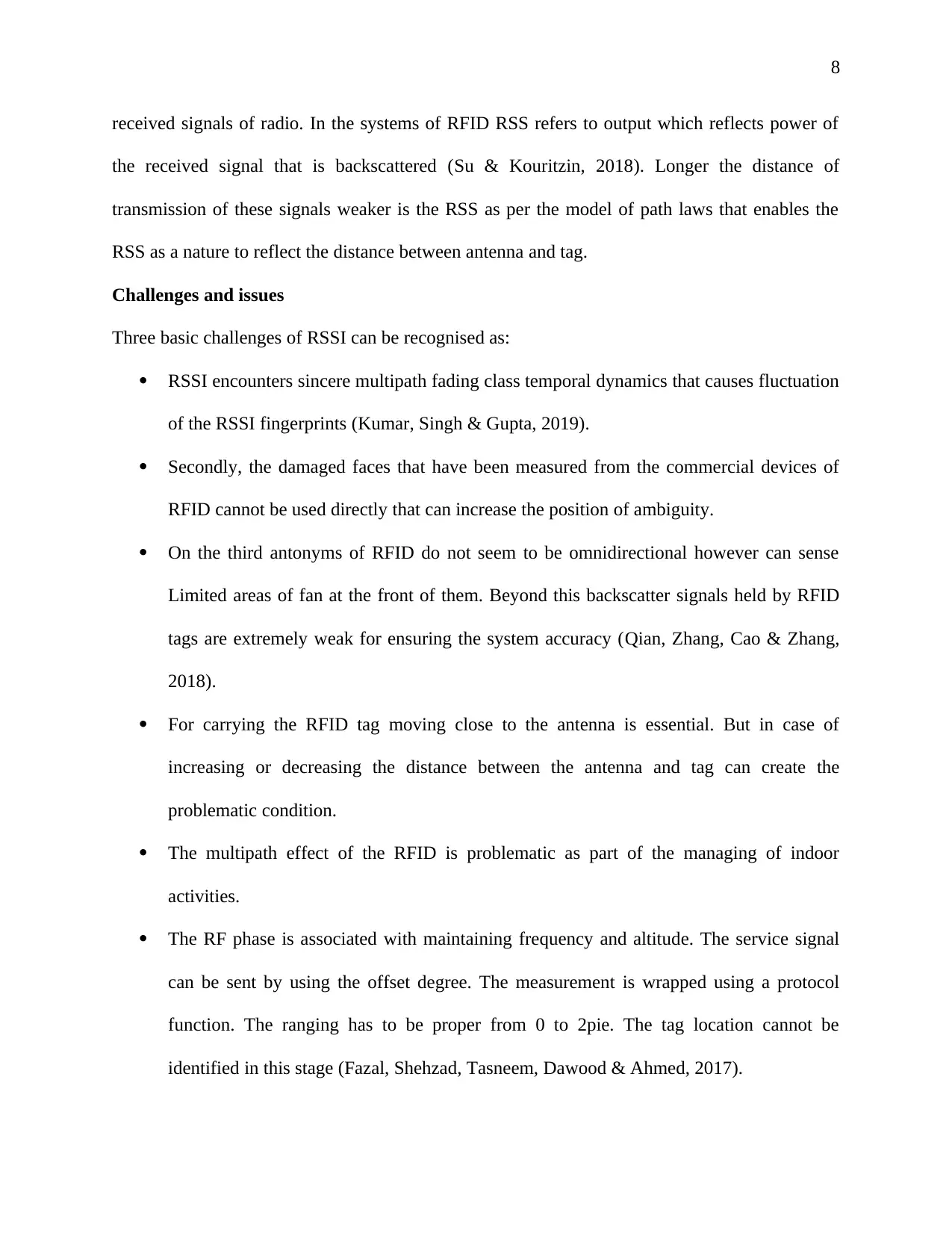
8
received signals of radio. In the systems of RFID RSS refers to output which reflects power of
the received signal that is backscattered (Su & Kouritzin, 2018). Longer the distance of
transmission of these signals weaker is the RSS as per the model of path laws that enables the
RSS as a nature to reflect the distance between antenna and tag.
Challenges and issues
Three basic challenges of RSSI can be recognised as:
RSSI encounters sincere multipath fading class temporal dynamics that causes fluctuation
of the RSSI fingerprints (Kumar, Singh & Gupta, 2019).
Secondly, the damaged faces that have been measured from the commercial devices of
RFID cannot be used directly that can increase the position of ambiguity.
On the third antonyms of RFID do not seem to be omnidirectional however can sense
Limited areas of fan at the front of them. Beyond this backscatter signals held by RFID
tags are extremely weak for ensuring the system accuracy (Qian, Zhang, Cao & Zhang,
2018).
For carrying the RFID tag moving close to the antenna is essential. But in case of
increasing or decreasing the distance between the antenna and tag can create the
problematic condition.
The multipath effect of the RFID is problematic as part of the managing of indoor
activities.
The RF phase is associated with maintaining frequency and altitude. The service signal
can be sent by using the offset degree. The measurement is wrapped using a protocol
function. The ranging has to be proper from 0 to 2pie. The tag location cannot be
identified in this stage (Fazal, Shehzad, Tasneem, Dawood & Ahmed, 2017).
received signals of radio. In the systems of RFID RSS refers to output which reflects power of
the received signal that is backscattered (Su & Kouritzin, 2018). Longer the distance of
transmission of these signals weaker is the RSS as per the model of path laws that enables the
RSS as a nature to reflect the distance between antenna and tag.
Challenges and issues
Three basic challenges of RSSI can be recognised as:
RSSI encounters sincere multipath fading class temporal dynamics that causes fluctuation
of the RSSI fingerprints (Kumar, Singh & Gupta, 2019).
Secondly, the damaged faces that have been measured from the commercial devices of
RFID cannot be used directly that can increase the position of ambiguity.
On the third antonyms of RFID do not seem to be omnidirectional however can sense
Limited areas of fan at the front of them. Beyond this backscatter signals held by RFID
tags are extremely weak for ensuring the system accuracy (Qian, Zhang, Cao & Zhang,
2018).
For carrying the RFID tag moving close to the antenna is essential. But in case of
increasing or decreasing the distance between the antenna and tag can create the
problematic condition.
The multipath effect of the RFID is problematic as part of the managing of indoor
activities.
The RF phase is associated with maintaining frequency and altitude. The service signal
can be sent by using the offset degree. The measurement is wrapped using a protocol
function. The ranging has to be proper from 0 to 2pie. The tag location cannot be
identified in this stage (Fazal, Shehzad, Tasneem, Dawood & Ahmed, 2017).
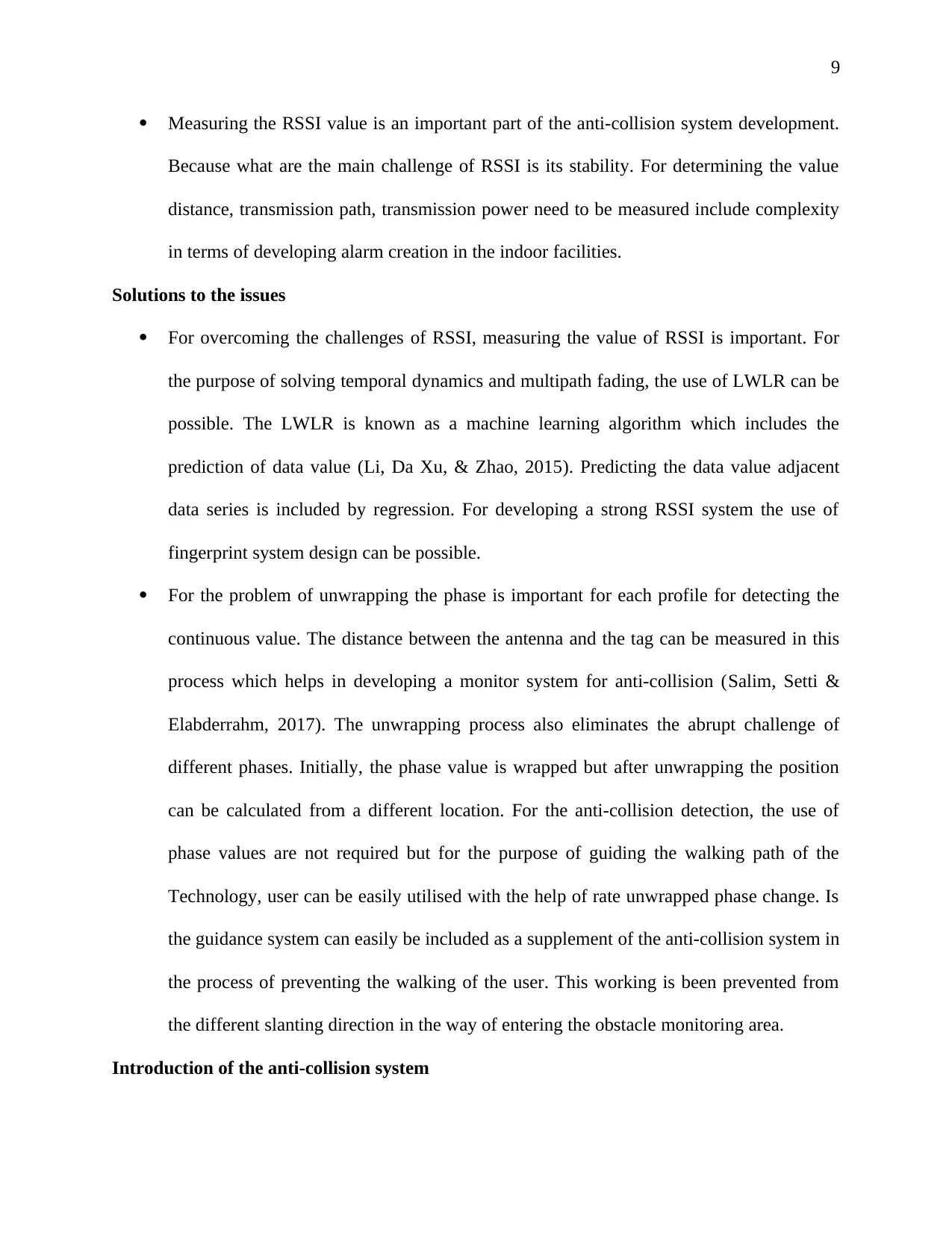
9
Measuring the RSSI value is an important part of the anti-collision system development.
Because what are the main challenge of RSSI is its stability. For determining the value
distance, transmission path, transmission power need to be measured include complexity
in terms of developing alarm creation in the indoor facilities.
Solutions to the issues
For overcoming the challenges of RSSI, measuring the value of RSSI is important. For
the purpose of solving temporal dynamics and multipath fading, the use of LWLR can be
possible. The LWLR is known as a machine learning algorithm which includes the
prediction of data value (Li, Da Xu, & Zhao, 2015). Predicting the data value adjacent
data series is included by regression. For developing a strong RSSI system the use of
fingerprint system design can be possible.
For the problem of unwrapping the phase is important for each profile for detecting the
continuous value. The distance between the antenna and the tag can be measured in this
process which helps in developing a monitor system for anti-collision (Salim, Setti &
Elabderrahm, 2017). The unwrapping process also eliminates the abrupt challenge of
different phases. Initially, the phase value is wrapped but after unwrapping the position
can be calculated from a different location. For the anti-collision detection, the use of
phase values are not required but for the purpose of guiding the walking path of the
Technology, user can be easily utilised with the help of rate unwrapped phase change. Is
the guidance system can easily be included as a supplement of the anti-collision system in
the process of preventing the walking of the user. This working is been prevented from
the different slanting direction in the way of entering the obstacle monitoring area.
Introduction of the anti-collision system
Measuring the RSSI value is an important part of the anti-collision system development.
Because what are the main challenge of RSSI is its stability. For determining the value
distance, transmission path, transmission power need to be measured include complexity
in terms of developing alarm creation in the indoor facilities.
Solutions to the issues
For overcoming the challenges of RSSI, measuring the value of RSSI is important. For
the purpose of solving temporal dynamics and multipath fading, the use of LWLR can be
possible. The LWLR is known as a machine learning algorithm which includes the
prediction of data value (Li, Da Xu, & Zhao, 2015). Predicting the data value adjacent
data series is included by regression. For developing a strong RSSI system the use of
fingerprint system design can be possible.
For the problem of unwrapping the phase is important for each profile for detecting the
continuous value. The distance between the antenna and the tag can be measured in this
process which helps in developing a monitor system for anti-collision (Salim, Setti &
Elabderrahm, 2017). The unwrapping process also eliminates the abrupt challenge of
different phases. Initially, the phase value is wrapped but after unwrapping the position
can be calculated from a different location. For the anti-collision detection, the use of
phase values are not required but for the purpose of guiding the walking path of the
Technology, user can be easily utilised with the help of rate unwrapped phase change. Is
the guidance system can easily be included as a supplement of the anti-collision system in
the process of preventing the walking of the user. This working is been prevented from
the different slanting direction in the way of entering the obstacle monitoring area.
Introduction of the anti-collision system
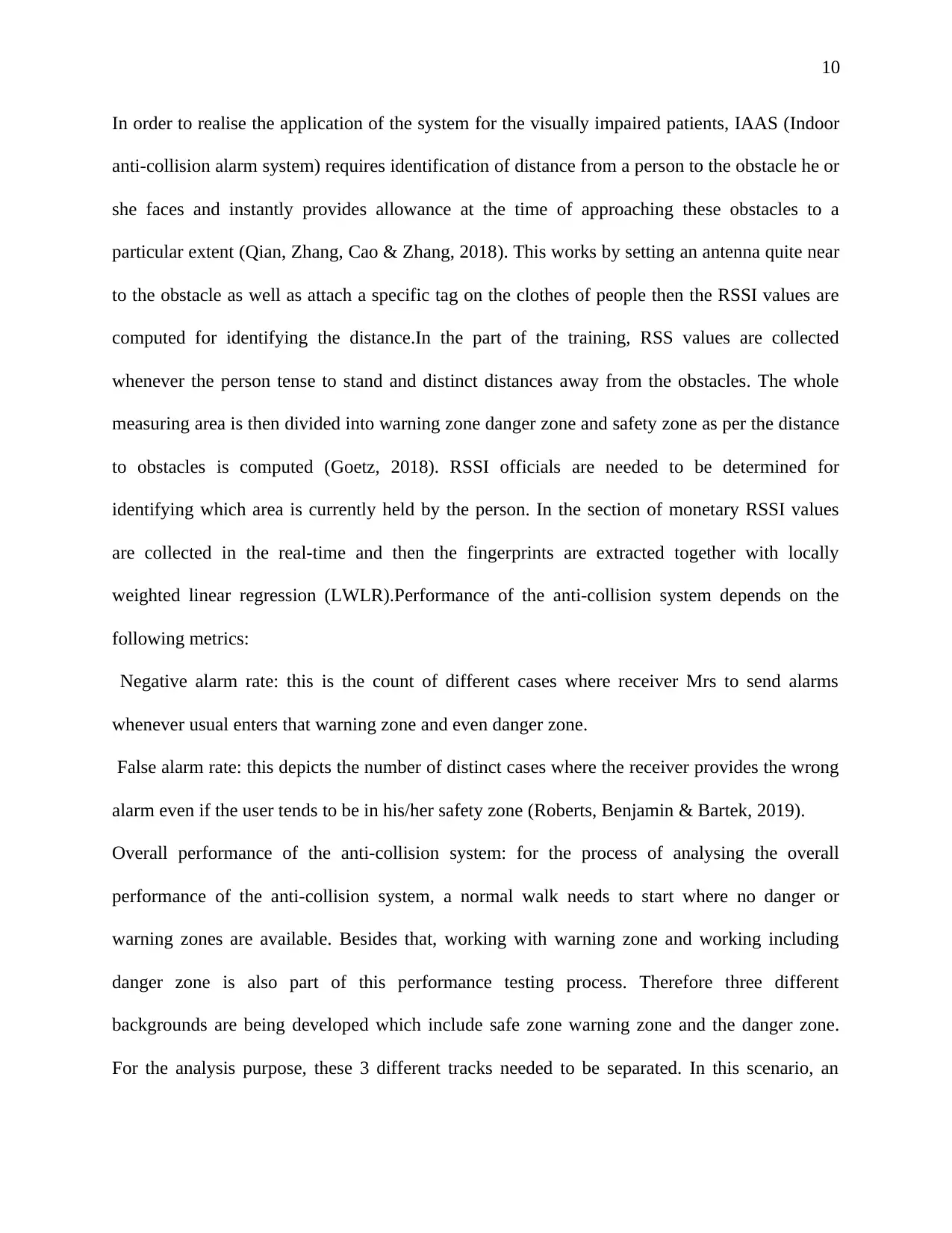
10
In order to realise the application of the system for the visually impaired patients, IAAS (Indoor
anti-collision alarm system) requires identification of distance from a person to the obstacle he or
she faces and instantly provides allowance at the time of approaching these obstacles to a
particular extent (Qian, Zhang, Cao & Zhang, 2018). This works by setting an antenna quite near
to the obstacle as well as attach a specific tag on the clothes of people then the RSSI values are
computed for identifying the distance.In the part of the training, RSS values are collected
whenever the person tense to stand and distinct distances away from the obstacles. The whole
measuring area is then divided into warning zone danger zone and safety zone as per the distance
to obstacles is computed (Goetz, 2018). RSSI officials are needed to be determined for
identifying which area is currently held by the person. In the section of monetary RSSI values
are collected in the real-time and then the fingerprints are extracted together with locally
weighted linear regression (LWLR).Performance of the anti-collision system depends on the
following metrics:
Negative alarm rate: this is the count of different cases where receiver Mrs to send alarms
whenever usual enters that warning zone and even danger zone.
False alarm rate: this depicts the number of distinct cases where the receiver provides the wrong
alarm even if the user tends to be in his/her safety zone (Roberts, Benjamin & Bartek, 2019).
Overall performance of the anti-collision system: for the process of analysing the overall
performance of the anti-collision system, a normal walk needs to start where no danger or
warning zones are available. Besides that, working with warning zone and working including
danger zone is also part of this performance testing process. Therefore three different
backgrounds are being developed which include safe zone warning zone and the danger zone.
For the analysis purpose, these 3 different tracks needed to be separated. In this scenario, an
In order to realise the application of the system for the visually impaired patients, IAAS (Indoor
anti-collision alarm system) requires identification of distance from a person to the obstacle he or
she faces and instantly provides allowance at the time of approaching these obstacles to a
particular extent (Qian, Zhang, Cao & Zhang, 2018). This works by setting an antenna quite near
to the obstacle as well as attach a specific tag on the clothes of people then the RSSI values are
computed for identifying the distance.In the part of the training, RSS values are collected
whenever the person tense to stand and distinct distances away from the obstacles. The whole
measuring area is then divided into warning zone danger zone and safety zone as per the distance
to obstacles is computed (Goetz, 2018). RSSI officials are needed to be determined for
identifying which area is currently held by the person. In the section of monetary RSSI values
are collected in the real-time and then the fingerprints are extracted together with locally
weighted linear regression (LWLR).Performance of the anti-collision system depends on the
following metrics:
Negative alarm rate: this is the count of different cases where receiver Mrs to send alarms
whenever usual enters that warning zone and even danger zone.
False alarm rate: this depicts the number of distinct cases where the receiver provides the wrong
alarm even if the user tends to be in his/her safety zone (Roberts, Benjamin & Bartek, 2019).
Overall performance of the anti-collision system: for the process of analysing the overall
performance of the anti-collision system, a normal walk needs to start where no danger or
warning zones are available. Besides that, working with warning zone and working including
danger zone is also part of this performance testing process. Therefore three different
backgrounds are being developed which include safe zone warning zone and the danger zone.
For the analysis purpose, these 3 different tracks needed to be separated. In this scenario, an
Secure Best Marks with AI Grader
Need help grading? Try our AI Grader for instant feedback on your assignments.
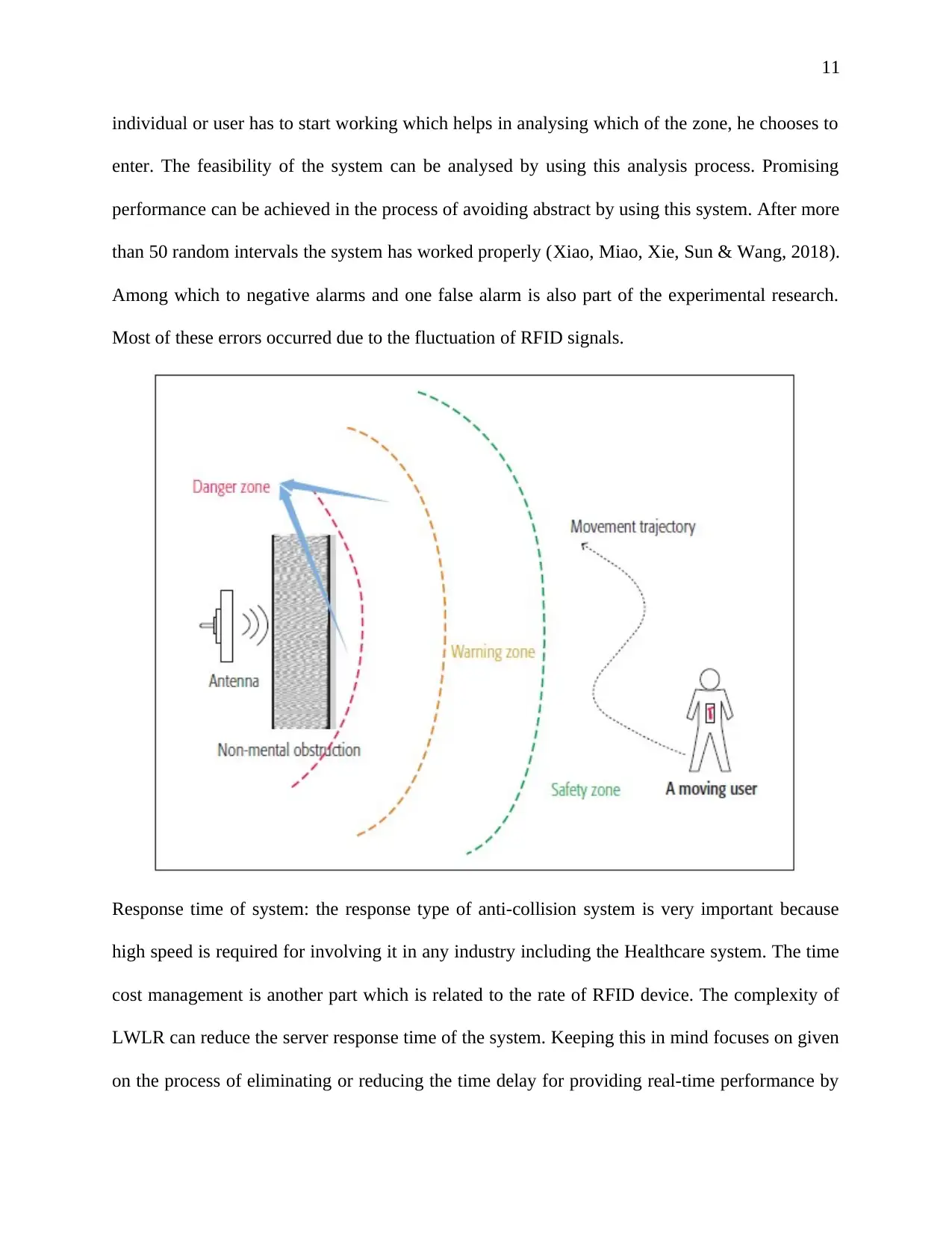
11
individual or user has to start working which helps in analysing which of the zone, he chooses to
enter. The feasibility of the system can be analysed by using this analysis process. Promising
performance can be achieved in the process of avoiding abstract by using this system. After more
than 50 random intervals the system has worked properly (Xiao, Miao, Xie, Sun & Wang, 2018).
Among which to negative alarms and one false alarm is also part of the experimental research.
Most of these errors occurred due to the fluctuation of RFID signals.
Response time of system: the response type of anti-collision system is very important because
high speed is required for involving it in any industry including the Healthcare system. The time
cost management is another part which is related to the rate of RFID device. The complexity of
LWLR can reduce the server response time of the system. Keeping this in mind focuses on given
on the process of eliminating or reducing the time delay for providing real-time performance by
individual or user has to start working which helps in analysing which of the zone, he chooses to
enter. The feasibility of the system can be analysed by using this analysis process. Promising
performance can be achieved in the process of avoiding abstract by using this system. After more
than 50 random intervals the system has worked properly (Xiao, Miao, Xie, Sun & Wang, 2018).
Among which to negative alarms and one false alarm is also part of the experimental research.
Most of these errors occurred due to the fluctuation of RFID signals.
Response time of system: the response type of anti-collision system is very important because
high speed is required for involving it in any industry including the Healthcare system. The time
cost management is another part which is related to the rate of RFID device. The complexity of
LWLR can reduce the server response time of the system. Keeping this in mind focuses on given
on the process of eliminating or reducing the time delay for providing real-time performance by
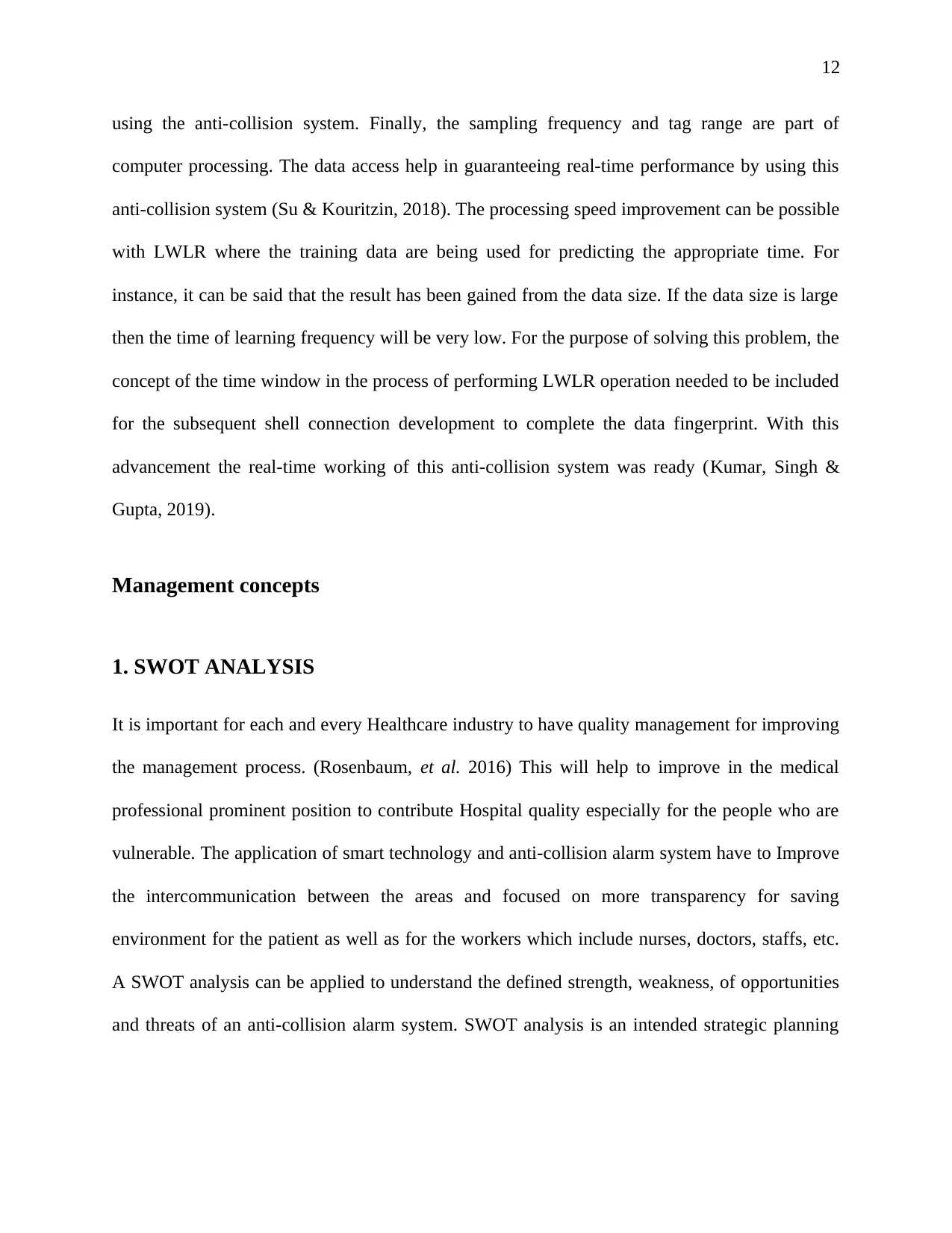
12
using the anti-collision system. Finally, the sampling frequency and tag range are part of
computer processing. The data access help in guaranteeing real-time performance by using this
anti-collision system (Su & Kouritzin, 2018). The processing speed improvement can be possible
with LWLR where the training data are being used for predicting the appropriate time. For
instance, it can be said that the result has been gained from the data size. If the data size is large
then the time of learning frequency will be very low. For the purpose of solving this problem, the
concept of the time window in the process of performing LWLR operation needed to be included
for the subsequent shell connection development to complete the data fingerprint. With this
advancement the real-time working of this anti-collision system was ready (Kumar, Singh &
Gupta, 2019).
Management concepts
1. SWOT ANALYSIS
It is important for each and every Healthcare industry to have quality management for improving
the management process. (Rosenbaum, et al. 2016) This will help to improve in the medical
professional prominent position to contribute Hospital quality especially for the people who are
vulnerable. The application of smart technology and anti-collision alarm system have to Improve
the intercommunication between the areas and focused on more transparency for saving
environment for the patient as well as for the workers which include nurses, doctors, staffs, etc.
A SWOT analysis can be applied to understand the defined strength, weakness, of opportunities
and threats of an anti-collision alarm system. SWOT analysis is an intended strategic planning
using the anti-collision system. Finally, the sampling frequency and tag range are part of
computer processing. The data access help in guaranteeing real-time performance by using this
anti-collision system (Su & Kouritzin, 2018). The processing speed improvement can be possible
with LWLR where the training data are being used for predicting the appropriate time. For
instance, it can be said that the result has been gained from the data size. If the data size is large
then the time of learning frequency will be very low. For the purpose of solving this problem, the
concept of the time window in the process of performing LWLR operation needed to be included
for the subsequent shell connection development to complete the data fingerprint. With this
advancement the real-time working of this anti-collision system was ready (Kumar, Singh &
Gupta, 2019).
Management concepts
1. SWOT ANALYSIS
It is important for each and every Healthcare industry to have quality management for improving
the management process. (Rosenbaum, et al. 2016) This will help to improve in the medical
professional prominent position to contribute Hospital quality especially for the people who are
vulnerable. The application of smart technology and anti-collision alarm system have to Improve
the intercommunication between the areas and focused on more transparency for saving
environment for the patient as well as for the workers which include nurses, doctors, staffs, etc.
A SWOT analysis can be applied to understand the defined strength, weakness, of opportunities
and threats of an anti-collision alarm system. SWOT analysis is an intended strategic planning
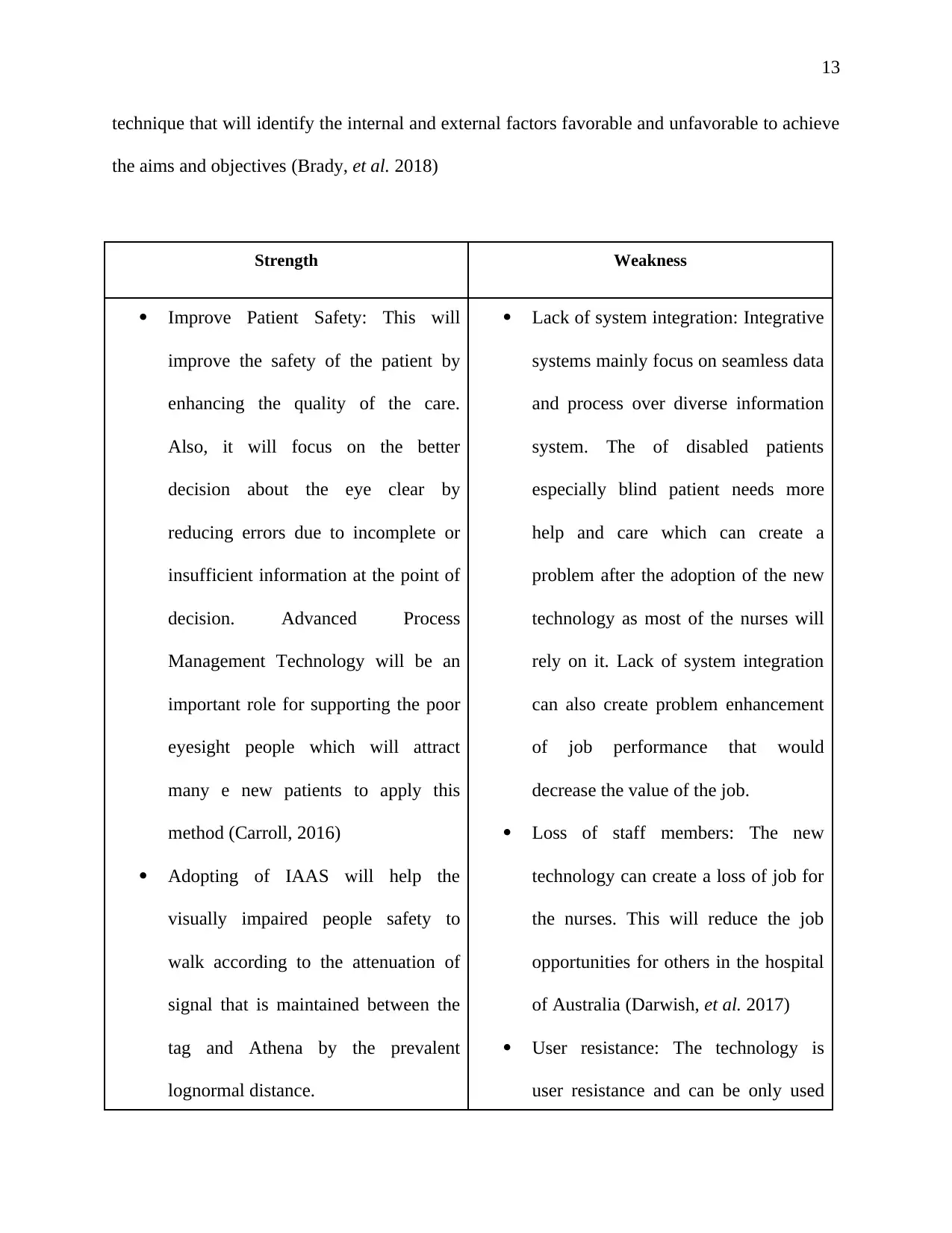
13
technique that will identify the internal and external factors favorable and unfavorable to achieve
the aims and objectives (Brady, et al. 2018)
Strength Weakness
Improve Patient Safety: This will
improve the safety of the patient by
enhancing the quality of the care.
Also, it will focus on the better
decision about the eye clear by
reducing errors due to incomplete or
insufficient information at the point of
decision. Advanced Process
Management Technology will be an
important role for supporting the poor
eyesight people which will attract
many e new patients to apply this
method (Carroll, 2016)
Adopting of IAAS will help the
visually impaired people safety to
walk according to the attenuation of
signal that is maintained between the
tag and Athena by the prevalent
lognormal distance.
Lack of system integration: Integrative
systems mainly focus on seamless data
and process over diverse information
system. The of disabled patients
especially blind patient needs more
help and care which can create a
problem after the adoption of the new
technology as most of the nurses will
rely on it. Lack of system integration
can also create problem enhancement
of job performance that would
decrease the value of the job.
Loss of staff members: The new
technology can create a loss of job for
the nurses. This will reduce the job
opportunities for others in the hospital
of Australia (Darwish, et al. 2017)
User resistance: The technology is
user resistance and can be only used
technique that will identify the internal and external factors favorable and unfavorable to achieve
the aims and objectives (Brady, et al. 2018)
Strength Weakness
Improve Patient Safety: This will
improve the safety of the patient by
enhancing the quality of the care.
Also, it will focus on the better
decision about the eye clear by
reducing errors due to incomplete or
insufficient information at the point of
decision. Advanced Process
Management Technology will be an
important role for supporting the poor
eyesight people which will attract
many e new patients to apply this
method (Carroll, 2016)
Adopting of IAAS will help the
visually impaired people safety to
walk according to the attenuation of
signal that is maintained between the
tag and Athena by the prevalent
lognormal distance.
Lack of system integration: Integrative
systems mainly focus on seamless data
and process over diverse information
system. The of disabled patients
especially blind patient needs more
help and care which can create a
problem after the adoption of the new
technology as most of the nurses will
rely on it. Lack of system integration
can also create problem enhancement
of job performance that would
decrease the value of the job.
Loss of staff members: The new
technology can create a loss of job for
the nurses. This will reduce the job
opportunities for others in the hospital
of Australia (Darwish, et al. 2017)
User resistance: The technology is
user resistance and can be only used
Paraphrase This Document
Need a fresh take? Get an instant paraphrase of this document with our AI Paraphraser
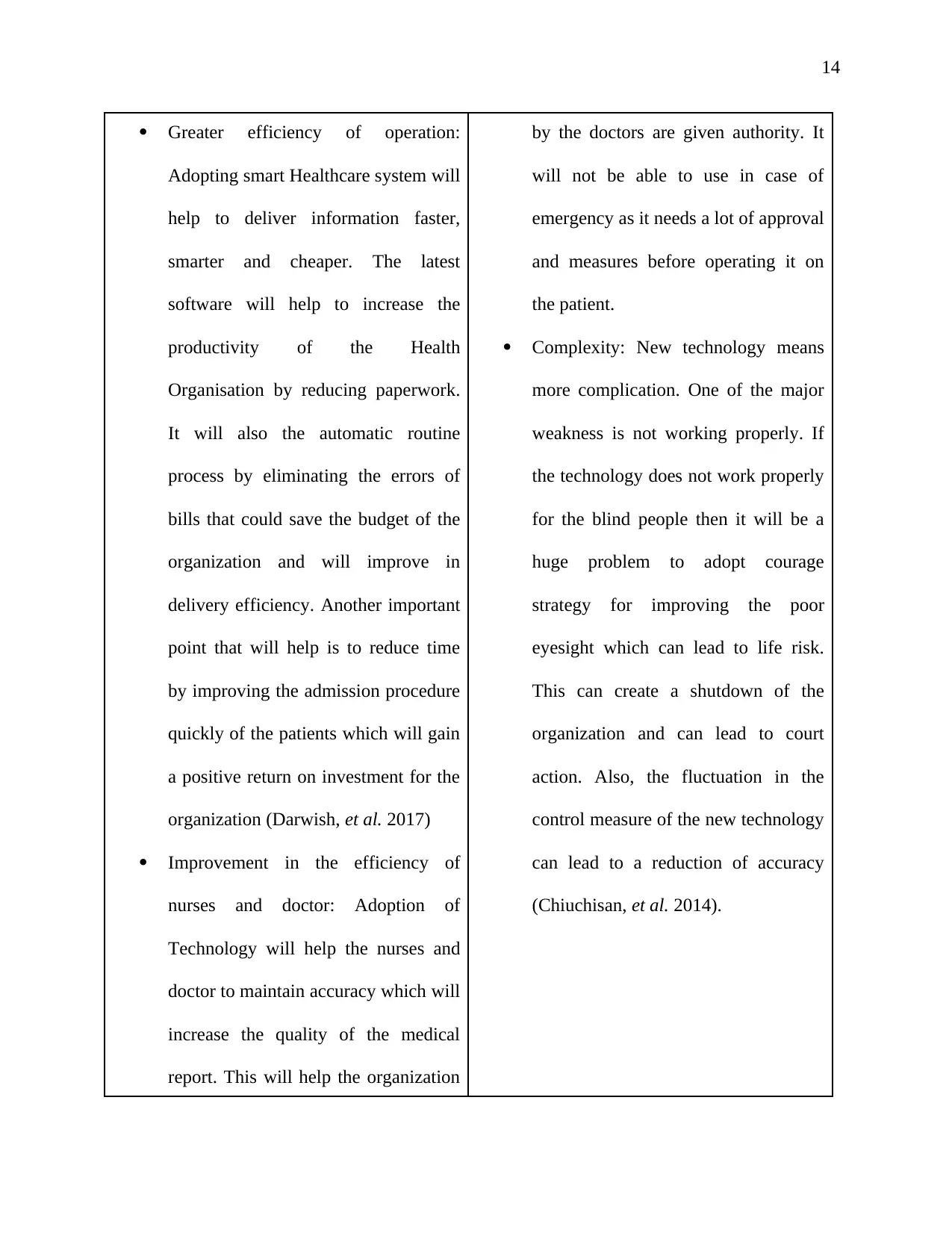
14
Greater efficiency of operation:
Adopting smart Healthcare system will
help to deliver information faster,
smarter and cheaper. The latest
software will help to increase the
productivity of the Health
Organisation by reducing paperwork.
It will also the automatic routine
process by eliminating the errors of
bills that could save the budget of the
organization and will improve in
delivery efficiency. Another important
point that will help is to reduce time
by improving the admission procedure
quickly of the patients which will gain
a positive return on investment for the
organization (Darwish, et al. 2017)
Improvement in the efficiency of
nurses and doctor: Adoption of
Technology will help the nurses and
doctor to maintain accuracy which will
increase the quality of the medical
report. This will help the organization
by the doctors are given authority. It
will not be able to use in case of
emergency as it needs a lot of approval
and measures before operating it on
the patient.
Complexity: New technology means
more complication. One of the major
weakness is not working properly. If
the technology does not work properly
for the blind people then it will be a
huge problem to adopt courage
strategy for improving the poor
eyesight which can lead to life risk.
This can create a shutdown of the
organization and can lead to court
action. Also, the fluctuation in the
control measure of the new technology
can lead to a reduction of accuracy
(Chiuchisan, et al. 2014).
Greater efficiency of operation:
Adopting smart Healthcare system will
help to deliver information faster,
smarter and cheaper. The latest
software will help to increase the
productivity of the Health
Organisation by reducing paperwork.
It will also the automatic routine
process by eliminating the errors of
bills that could save the budget of the
organization and will improve in
delivery efficiency. Another important
point that will help is to reduce time
by improving the admission procedure
quickly of the patients which will gain
a positive return on investment for the
organization (Darwish, et al. 2017)
Improvement in the efficiency of
nurses and doctor: Adoption of
Technology will help the nurses and
doctor to maintain accuracy which will
increase the quality of the medical
report. This will help the organization
by the doctors are given authority. It
will not be able to use in case of
emergency as it needs a lot of approval
and measures before operating it on
the patient.
Complexity: New technology means
more complication. One of the major
weakness is not working properly. If
the technology does not work properly
for the blind people then it will be a
huge problem to adopt courage
strategy for improving the poor
eyesight which can lead to life risk.
This can create a shutdown of the
organization and can lead to court
action. Also, the fluctuation in the
control measure of the new technology
can lead to a reduction of accuracy
(Chiuchisan, et al. 2014).
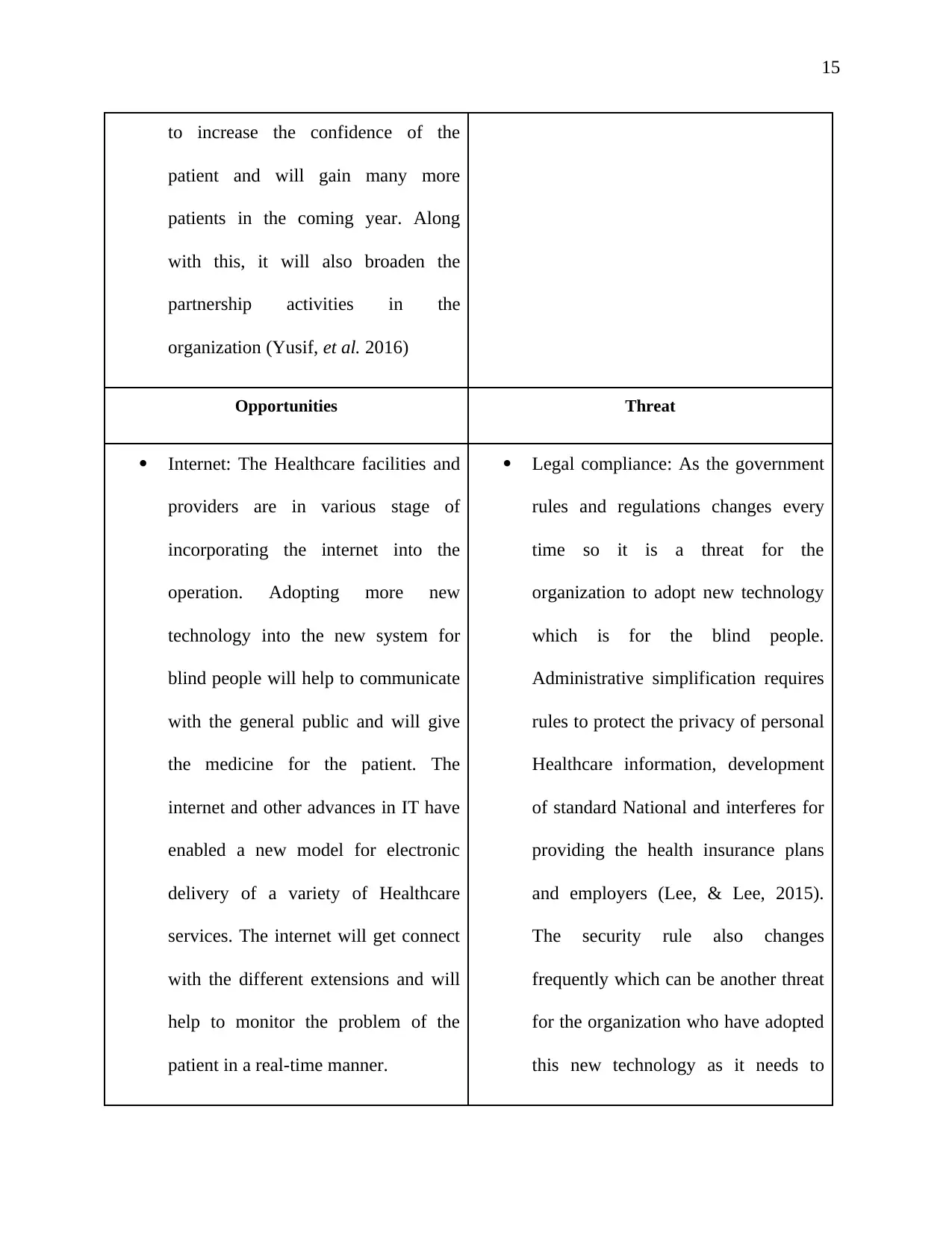
15
to increase the confidence of the
patient and will gain many more
patients in the coming year. Along
with this, it will also broaden the
partnership activities in the
organization (Yusif, et al. 2016)
Opportunities Threat
Internet: The Healthcare facilities and
providers are in various stage of
incorporating the internet into the
operation. Adopting more new
technology into the new system for
blind people will help to communicate
with the general public and will give
the medicine for the patient. The
internet and other advances in IT have
enabled a new model for electronic
delivery of a variety of Healthcare
services. The internet will get connect
with the different extensions and will
help to monitor the problem of the
patient in a real-time manner.
Legal compliance: As the government
rules and regulations changes every
time so it is a threat for the
organization to adopt new technology
which is for the blind people.
Administrative simplification requires
rules to protect the privacy of personal
Healthcare information, development
of standard National and interferes for
providing the health insurance plans
and employers (Lee, & Lee, 2015).
The security rule also changes
frequently which can be another threat
for the organization who have adopted
this new technology as it needs to
to increase the confidence of the
patient and will gain many more
patients in the coming year. Along
with this, it will also broaden the
partnership activities in the
organization (Yusif, et al. 2016)
Opportunities Threat
Internet: The Healthcare facilities and
providers are in various stage of
incorporating the internet into the
operation. Adopting more new
technology into the new system for
blind people will help to communicate
with the general public and will give
the medicine for the patient. The
internet and other advances in IT have
enabled a new model for electronic
delivery of a variety of Healthcare
services. The internet will get connect
with the different extensions and will
help to monitor the problem of the
patient in a real-time manner.
Legal compliance: As the government
rules and regulations changes every
time so it is a threat for the
organization to adopt new technology
which is for the blind people.
Administrative simplification requires
rules to protect the privacy of personal
Healthcare information, development
of standard National and interferes for
providing the health insurance plans
and employers (Lee, & Lee, 2015).
The security rule also changes
frequently which can be another threat
for the organization who have adopted
this new technology as it needs to
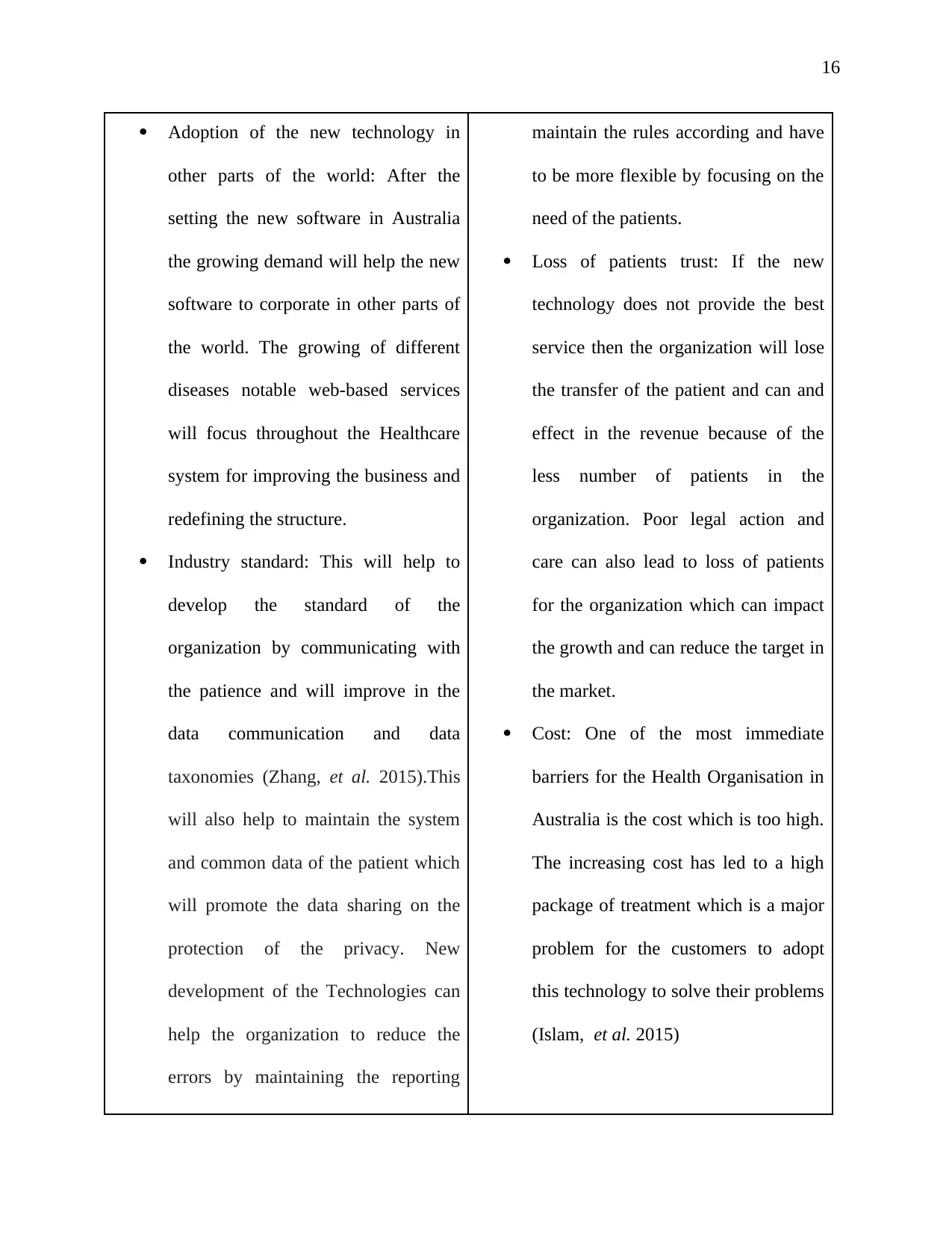
16
Adoption of the new technology in
other parts of the world: After the
setting the new software in Australia
the growing demand will help the new
software to corporate in other parts of
the world. The growing of different
diseases notable web-based services
will focus throughout the Healthcare
system for improving the business and
redefining the structure.
Industry standard: This will help to
develop the standard of the
organization by communicating with
the patience and will improve in the
data communication and data
taxonomies (Zhang, et al. 2015).This
will also help to maintain the system
and common data of the patient which
will promote the data sharing on the
protection of the privacy. New
development of the Technologies can
help the organization to reduce the
errors by maintaining the reporting
maintain the rules according and have
to be more flexible by focusing on the
need of the patients.
Loss of patients trust: If the new
technology does not provide the best
service then the organization will lose
the transfer of the patient and can and
effect in the revenue because of the
less number of patients in the
organization. Poor legal action and
care can also lead to loss of patients
for the organization which can impact
the growth and can reduce the target in
the market.
Cost: One of the most immediate
barriers for the Health Organisation in
Australia is the cost which is too high.
The increasing cost has led to a high
package of treatment which is a major
problem for the customers to adopt
this technology to solve their problems
(Islam, et al. 2015)
Adoption of the new technology in
other parts of the world: After the
setting the new software in Australia
the growing demand will help the new
software to corporate in other parts of
the world. The growing of different
diseases notable web-based services
will focus throughout the Healthcare
system for improving the business and
redefining the structure.
Industry standard: This will help to
develop the standard of the
organization by communicating with
the patience and will improve in the
data communication and data
taxonomies (Zhang, et al. 2015).This
will also help to maintain the system
and common data of the patient which
will promote the data sharing on the
protection of the privacy. New
development of the Technologies can
help the organization to reduce the
errors by maintaining the reporting
maintain the rules according and have
to be more flexible by focusing on the
need of the patients.
Loss of patients trust: If the new
technology does not provide the best
service then the organization will lose
the transfer of the patient and can and
effect in the revenue because of the
less number of patients in the
organization. Poor legal action and
care can also lead to loss of patients
for the organization which can impact
the growth and can reduce the target in
the market.
Cost: One of the most immediate
barriers for the Health Organisation in
Australia is the cost which is too high.
The increasing cost has led to a high
package of treatment which is a major
problem for the customers to adopt
this technology to solve their problems
(Islam, et al. 2015)
Secure Best Marks with AI Grader
Need help grading? Try our AI Grader for instant feedback on your assignments.
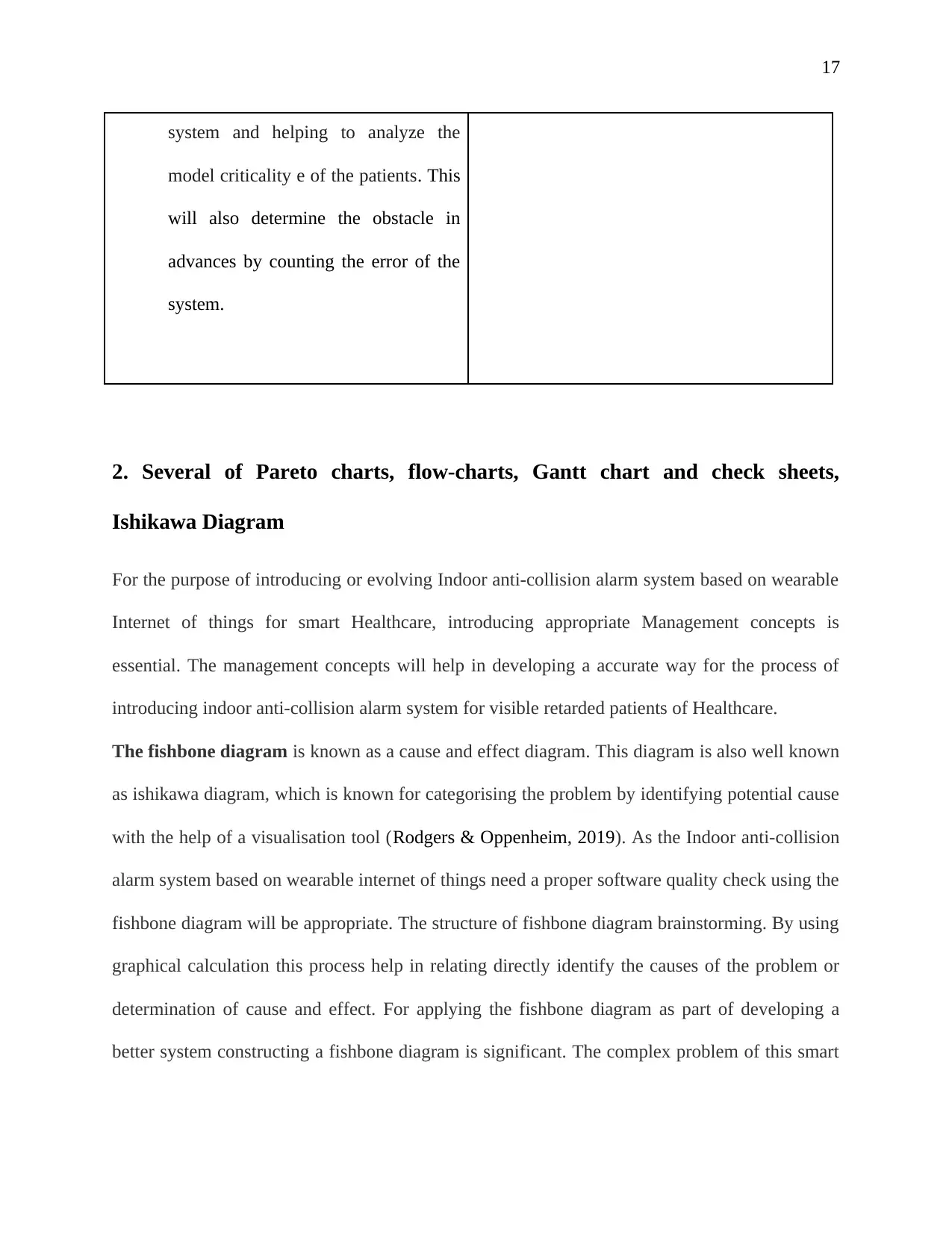
17
system and helping to analyze the
model criticality e of the patients. This
will also determine the obstacle in
advances by counting the error of the
system.
2. Several of Pareto charts, flow-charts, Gantt chart and check sheets,
Ishikawa Diagram
For the purpose of introducing or evolving Indoor anti-collision alarm system based on wearable
Internet of things for smart Healthcare, introducing appropriate Management concepts is
essential. The management concepts will help in developing a accurate way for the process of
introducing indoor anti-collision alarm system for visible retarded patients of Healthcare.
The fishbone diagram is known as a cause and effect diagram. This diagram is also well known
as ishikawa diagram, which is known for categorising the problem by identifying potential cause
with the help of a visualisation tool (Rodgers & Oppenheim, 2019). As the Indoor anti-collision
alarm system based on wearable internet of things need a proper software quality check using the
fishbone diagram will be appropriate. The structure of fishbone diagram brainstorming. By using
graphical calculation this process help in relating directly identify the causes of the problem or
determination of cause and effect. For applying the fishbone diagram as part of developing a
better system constructing a fishbone diagram is significant. The complex problem of this smart
system and helping to analyze the
model criticality e of the patients. This
will also determine the obstacle in
advances by counting the error of the
system.
2. Several of Pareto charts, flow-charts, Gantt chart and check sheets,
Ishikawa Diagram
For the purpose of introducing or evolving Indoor anti-collision alarm system based on wearable
Internet of things for smart Healthcare, introducing appropriate Management concepts is
essential. The management concepts will help in developing a accurate way for the process of
introducing indoor anti-collision alarm system for visible retarded patients of Healthcare.
The fishbone diagram is known as a cause and effect diagram. This diagram is also well known
as ishikawa diagram, which is known for categorising the problem by identifying potential cause
with the help of a visualisation tool (Rodgers & Oppenheim, 2019). As the Indoor anti-collision
alarm system based on wearable internet of things need a proper software quality check using the
fishbone diagram will be appropriate. The structure of fishbone diagram brainstorming. By using
graphical calculation this process help in relating directly identify the causes of the problem or
determination of cause and effect. For applying the fishbone diagram as part of developing a
better system constructing a fishbone diagram is significant. The complex problem of this smart
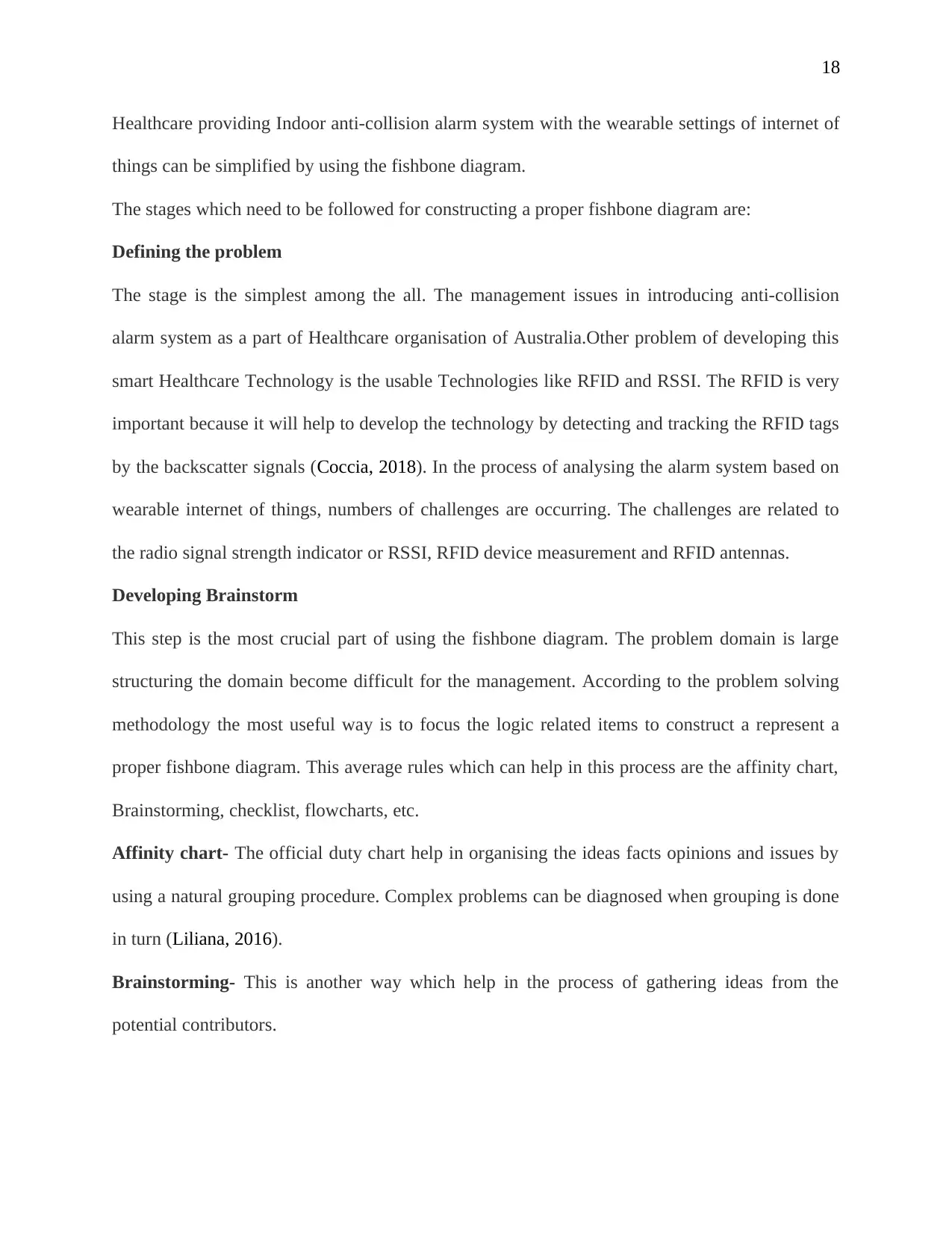
18
Healthcare providing Indoor anti-collision alarm system with the wearable settings of internet of
things can be simplified by using the fishbone diagram.
The stages which need to be followed for constructing a proper fishbone diagram are:
Defining the problem
The stage is the simplest among the all. The management issues in introducing anti-collision
alarm system as a part of Healthcare organisation of Australia.Other problem of developing this
smart Healthcare Technology is the usable Technologies like RFID and RSSI. The RFID is very
important because it will help to develop the technology by detecting and tracking the RFID tags
by the backscatter signals (Coccia, 2018). In the process of analysing the alarm system based on
wearable internet of things, numbers of challenges are occurring. The challenges are related to
the radio signal strength indicator or RSSI, RFID device measurement and RFID antennas.
Developing Brainstorm
This step is the most crucial part of using the fishbone diagram. The problem domain is large
structuring the domain become difficult for the management. According to the problem solving
methodology the most useful way is to focus the logic related items to construct a represent a
proper fishbone diagram. This average rules which can help in this process are the affinity chart,
Brainstorming, checklist, flowcharts, etc.
Affinity chart- The official duty chart help in organising the ideas facts opinions and issues by
using a natural grouping procedure. Complex problems can be diagnosed when grouping is done
in turn (Liliana, 2016).
Brainstorming- This is another way which help in the process of gathering ideas from the
potential contributors.
Healthcare providing Indoor anti-collision alarm system with the wearable settings of internet of
things can be simplified by using the fishbone diagram.
The stages which need to be followed for constructing a proper fishbone diagram are:
Defining the problem
The stage is the simplest among the all. The management issues in introducing anti-collision
alarm system as a part of Healthcare organisation of Australia.Other problem of developing this
smart Healthcare Technology is the usable Technologies like RFID and RSSI. The RFID is very
important because it will help to develop the technology by detecting and tracking the RFID tags
by the backscatter signals (Coccia, 2018). In the process of analysing the alarm system based on
wearable internet of things, numbers of challenges are occurring. The challenges are related to
the radio signal strength indicator or RSSI, RFID device measurement and RFID antennas.
Developing Brainstorm
This step is the most crucial part of using the fishbone diagram. The problem domain is large
structuring the domain become difficult for the management. According to the problem solving
methodology the most useful way is to focus the logic related items to construct a represent a
proper fishbone diagram. This average rules which can help in this process are the affinity chart,
Brainstorming, checklist, flowcharts, etc.
Affinity chart- The official duty chart help in organising the ideas facts opinions and issues by
using a natural grouping procedure. Complex problems can be diagnosed when grouping is done
in turn (Liliana, 2016).
Brainstorming- This is another way which help in the process of gathering ideas from the
potential contributors.
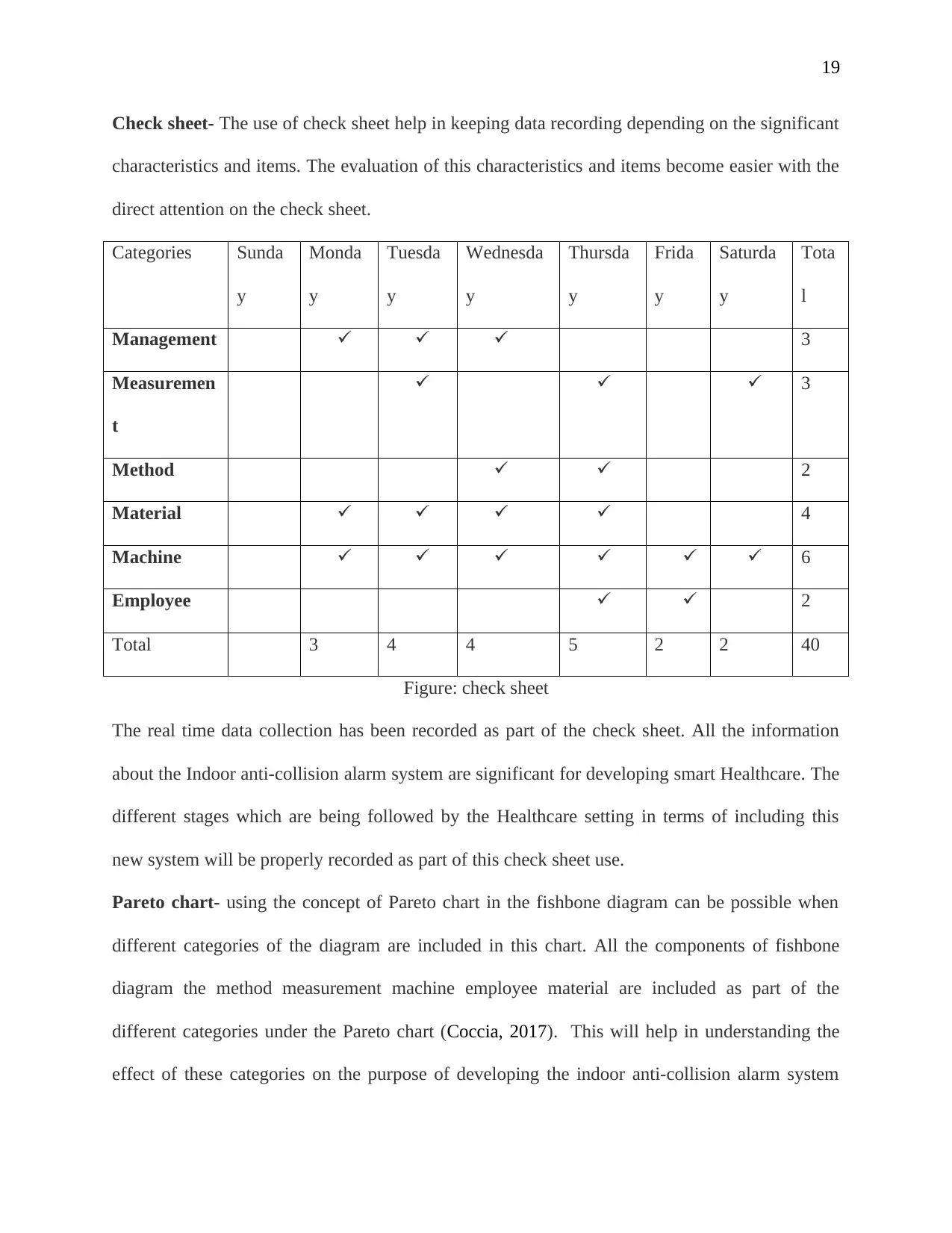
19
Check sheet- The use of check sheet help in keeping data recording depending on the significant
characteristics and items. The evaluation of this characteristics and items become easier with the
direct attention on the check sheet.
Categories Sunda
y
Monda
y
Tuesda
y
Wednesda
y
Thursda
y
Frida
y
Saturda
y
Tota
l
Management 3
Measuremen
t
3
Method 2
Material 4
Machine 6
Employee 2
Total 3 4 4 5 2 2 40
Figure: check sheet
The real time data collection has been recorded as part of the check sheet. All the information
about the Indoor anti-collision alarm system are significant for developing smart Healthcare. The
different stages which are being followed by the Healthcare setting in terms of including this
new system will be properly recorded as part of this check sheet use.
Pareto chart- using the concept of Pareto chart in the fishbone diagram can be possible when
different categories of the diagram are included in this chart. All the components of fishbone
diagram the method measurement machine employee material are included as part of the
different categories under the Pareto chart (Coccia, 2017). This will help in understanding the
effect of these categories on the purpose of developing the indoor anti-collision alarm system
Check sheet- The use of check sheet help in keeping data recording depending on the significant
characteristics and items. The evaluation of this characteristics and items become easier with the
direct attention on the check sheet.
Categories Sunda
y
Monda
y
Tuesda
y
Wednesda
y
Thursda
y
Frida
y
Saturda
y
Tota
l
Management 3
Measuremen
t
3
Method 2
Material 4
Machine 6
Employee 2
Total 3 4 4 5 2 2 40
Figure: check sheet
The real time data collection has been recorded as part of the check sheet. All the information
about the Indoor anti-collision alarm system are significant for developing smart Healthcare. The
different stages which are being followed by the Healthcare setting in terms of including this
new system will be properly recorded as part of this check sheet use.
Pareto chart- using the concept of Pareto chart in the fishbone diagram can be possible when
different categories of the diagram are included in this chart. All the components of fishbone
diagram the method measurement machine employee material are included as part of the
different categories under the Pareto chart (Coccia, 2017). This will help in understanding the
effect of these categories on the purpose of developing the indoor anti-collision alarm system
Paraphrase This Document
Need a fresh take? Get an instant paraphrase of this document with our AI Paraphraser
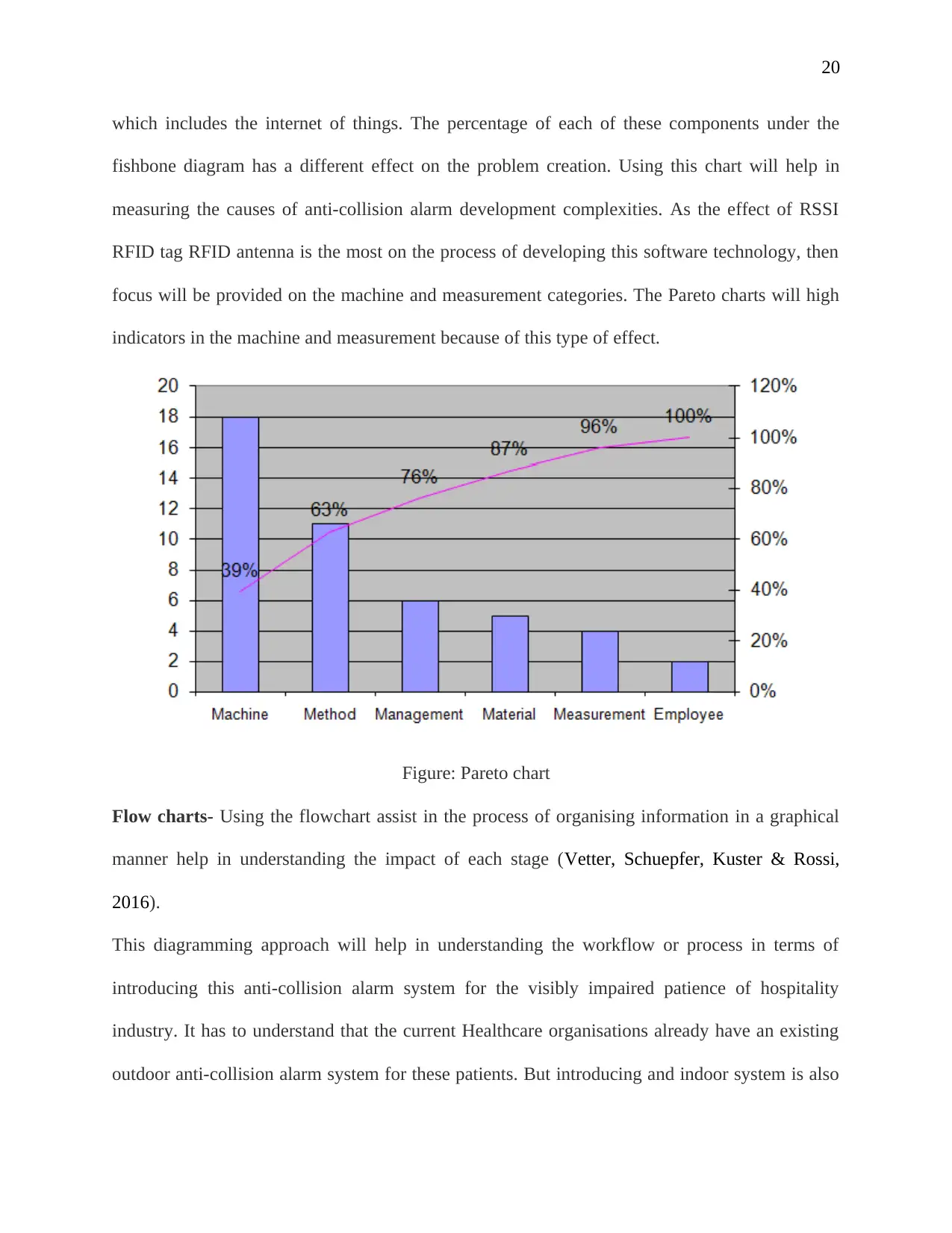
20
which includes the internet of things. The percentage of each of these components under the
fishbone diagram has a different effect on the problem creation. Using this chart will help in
measuring the causes of anti-collision alarm development complexities. As the effect of RSSI
RFID tag RFID antenna is the most on the process of developing this software technology, then
focus will be provided on the machine and measurement categories. The Pareto charts will high
indicators in the machine and measurement because of this type of effect.
Figure: Pareto chart
Flow charts- Using the flowchart assist in the process of organising information in a graphical
manner help in understanding the impact of each stage (Vetter, Schuepfer, Kuster & Rossi,
2016).
This diagramming approach will help in understanding the workflow or process in terms of
introducing this anti-collision alarm system for the visibly impaired patience of hospitality
industry. It has to understand that the current Healthcare organisations already have an existing
outdoor anti-collision alarm system for these patients. But introducing and indoor system is also
which includes the internet of things. The percentage of each of these components under the
fishbone diagram has a different effect on the problem creation. Using this chart will help in
measuring the causes of anti-collision alarm development complexities. As the effect of RSSI
RFID tag RFID antenna is the most on the process of developing this software technology, then
focus will be provided on the machine and measurement categories. The Pareto charts will high
indicators in the machine and measurement because of this type of effect.
Figure: Pareto chart
Flow charts- Using the flowchart assist in the process of organising information in a graphical
manner help in understanding the impact of each stage (Vetter, Schuepfer, Kuster & Rossi,
2016).
This diagramming approach will help in understanding the workflow or process in terms of
introducing this anti-collision alarm system for the visibly impaired patience of hospitality
industry. It has to understand that the current Healthcare organisations already have an existing
outdoor anti-collision alarm system for these patients. But introducing and indoor system is also
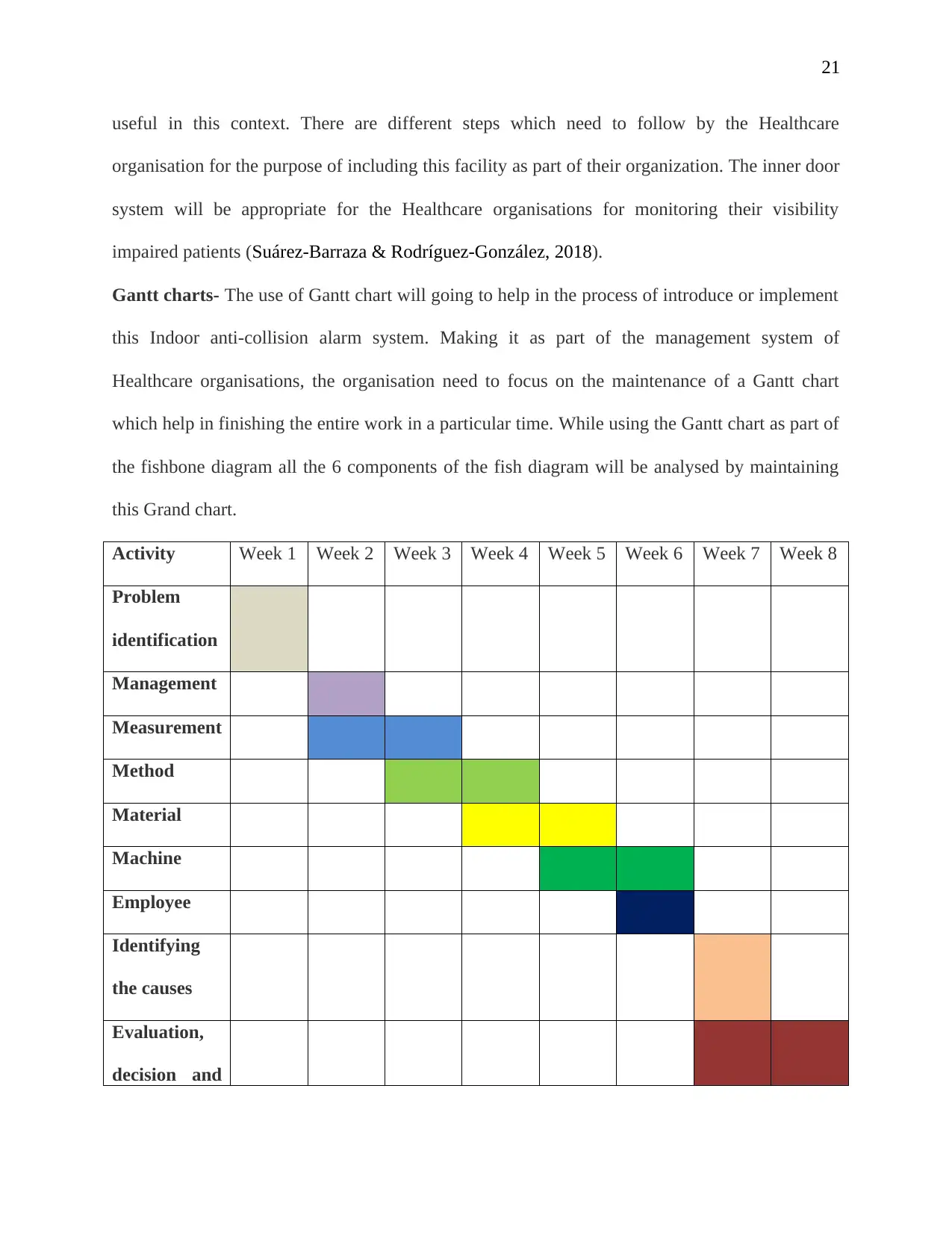
21
useful in this context. There are different steps which need to follow by the Healthcare
organisation for the purpose of including this facility as part of their organization. The inner door
system will be appropriate for the Healthcare organisations for monitoring their visibility
impaired patients (Suárez-Barraza & Rodríguez-González, 2018).
Gantt charts- The use of Gantt chart will going to help in the process of introduce or implement
this Indoor anti-collision alarm system. Making it as part of the management system of
Healthcare organisations, the organisation need to focus on the maintenance of a Gantt chart
which help in finishing the entire work in a particular time. While using the Gantt chart as part of
the fishbone diagram all the 6 components of the fish diagram will be analysed by maintaining
this Grand chart.
Activity Week 1 Week 2 Week 3 Week 4 Week 5 Week 6 Week 7 Week 8
Problem
identification
Management
Measurement
Method
Material
Machine
Employee
Identifying
the causes
Evaluation,
decision and
useful in this context. There are different steps which need to follow by the Healthcare
organisation for the purpose of including this facility as part of their organization. The inner door
system will be appropriate for the Healthcare organisations for monitoring their visibility
impaired patients (Suárez-Barraza & Rodríguez-González, 2018).
Gantt charts- The use of Gantt chart will going to help in the process of introduce or implement
this Indoor anti-collision alarm system. Making it as part of the management system of
Healthcare organisations, the organisation need to focus on the maintenance of a Gantt chart
which help in finishing the entire work in a particular time. While using the Gantt chart as part of
the fishbone diagram all the 6 components of the fish diagram will be analysed by maintaining
this Grand chart.
Activity Week 1 Week 2 Week 3 Week 4 Week 5 Week 6 Week 7 Week 8
Problem
identification
Management
Measurement
Method
Material
Machine
Employee
Identifying
the causes
Evaluation,
decision and
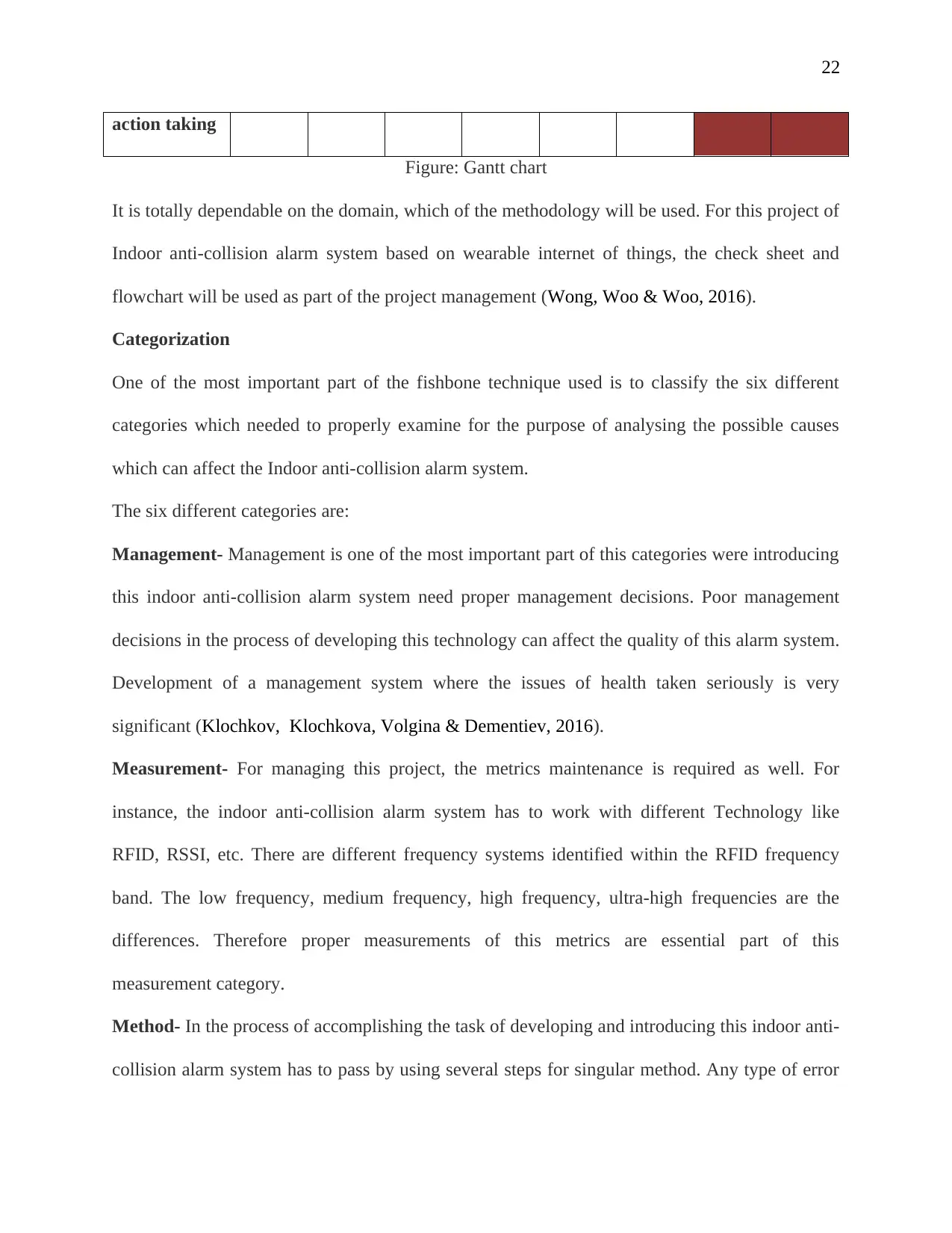
22
action taking
Figure: Gantt chart
It is totally dependable on the domain, which of the methodology will be used. For this project of
Indoor anti-collision alarm system based on wearable internet of things, the check sheet and
flowchart will be used as part of the project management (Wong, Woo & Woo, 2016).
Categorization
One of the most important part of the fishbone technique used is to classify the six different
categories which needed to properly examine for the purpose of analysing the possible causes
which can affect the Indoor anti-collision alarm system.
The six different categories are:
Management- Management is one of the most important part of this categories were introducing
this indoor anti-collision alarm system need proper management decisions. Poor management
decisions in the process of developing this technology can affect the quality of this alarm system.
Development of a management system where the issues of health taken seriously is very
significant (Klochkov, Klochkova, Volgina & Dementiev, 2016).
Measurement- For managing this project, the metrics maintenance is required as well. For
instance, the indoor anti-collision alarm system has to work with different Technology like
RFID, RSSI, etc. There are different frequency systems identified within the RFID frequency
band. The low frequency, medium frequency, high frequency, ultra-high frequencies are the
differences. Therefore proper measurements of this metrics are essential part of this
measurement category.
Method- In the process of accomplishing the task of developing and introducing this indoor anti-
collision alarm system has to pass by using several steps for singular method. Any type of error
action taking
Figure: Gantt chart
It is totally dependable on the domain, which of the methodology will be used. For this project of
Indoor anti-collision alarm system based on wearable internet of things, the check sheet and
flowchart will be used as part of the project management (Wong, Woo & Woo, 2016).
Categorization
One of the most important part of the fishbone technique used is to classify the six different
categories which needed to properly examine for the purpose of analysing the possible causes
which can affect the Indoor anti-collision alarm system.
The six different categories are:
Management- Management is one of the most important part of this categories were introducing
this indoor anti-collision alarm system need proper management decisions. Poor management
decisions in the process of developing this technology can affect the quality of this alarm system.
Development of a management system where the issues of health taken seriously is very
significant (Klochkov, Klochkova, Volgina & Dementiev, 2016).
Measurement- For managing this project, the metrics maintenance is required as well. For
instance, the indoor anti-collision alarm system has to work with different Technology like
RFID, RSSI, etc. There are different frequency systems identified within the RFID frequency
band. The low frequency, medium frequency, high frequency, ultra-high frequencies are the
differences. Therefore proper measurements of this metrics are essential part of this
measurement category.
Method- In the process of accomplishing the task of developing and introducing this indoor anti-
collision alarm system has to pass by using several steps for singular method. Any type of error
Secure Best Marks with AI Grader
Need help grading? Try our AI Grader for instant feedback on your assignments.
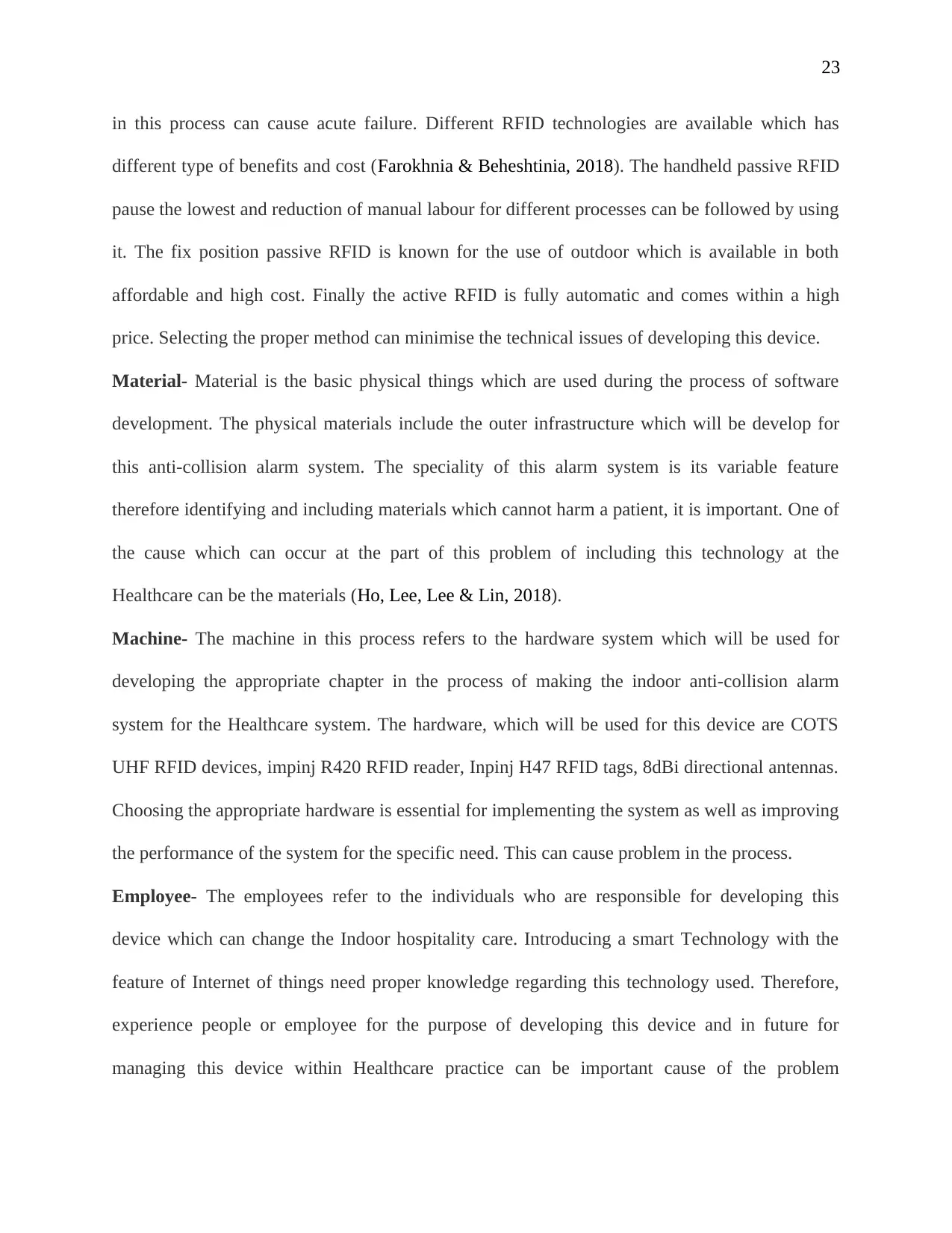
23
in this process can cause acute failure. Different RFID technologies are available which has
different type of benefits and cost (Farokhnia & Beheshtinia, 2018). The handheld passive RFID
pause the lowest and reduction of manual labour for different processes can be followed by using
it. The fix position passive RFID is known for the use of outdoor which is available in both
affordable and high cost. Finally the active RFID is fully automatic and comes within a high
price. Selecting the proper method can minimise the technical issues of developing this device.
Material- Material is the basic physical things which are used during the process of software
development. The physical materials include the outer infrastructure which will be develop for
this anti-collision alarm system. The speciality of this alarm system is its variable feature
therefore identifying and including materials which cannot harm a patient, it is important. One of
the cause which can occur at the part of this problem of including this technology at the
Healthcare can be the materials (Ho, Lee, Lee & Lin, 2018).
Machine- The machine in this process refers to the hardware system which will be used for
developing the appropriate chapter in the process of making the indoor anti-collision alarm
system for the Healthcare system. The hardware, which will be used for this device are COTS
UHF RFID devices, impinj R420 RFID reader, Inpinj H47 RFID tags, 8dBi directional antennas.
Choosing the appropriate hardware is essential for implementing the system as well as improving
the performance of the system for the specific need. This can cause problem in the process.
Employee- The employees refer to the individuals who are responsible for developing this
device which can change the Indoor hospitality care. Introducing a smart Technology with the
feature of Internet of things need proper knowledge regarding this technology used. Therefore,
experience people or employee for the purpose of developing this device and in future for
managing this device within Healthcare practice can be important cause of the problem
in this process can cause acute failure. Different RFID technologies are available which has
different type of benefits and cost (Farokhnia & Beheshtinia, 2018). The handheld passive RFID
pause the lowest and reduction of manual labour for different processes can be followed by using
it. The fix position passive RFID is known for the use of outdoor which is available in both
affordable and high cost. Finally the active RFID is fully automatic and comes within a high
price. Selecting the proper method can minimise the technical issues of developing this device.
Material- Material is the basic physical things which are used during the process of software
development. The physical materials include the outer infrastructure which will be develop for
this anti-collision alarm system. The speciality of this alarm system is its variable feature
therefore identifying and including materials which cannot harm a patient, it is important. One of
the cause which can occur at the part of this problem of including this technology at the
Healthcare can be the materials (Ho, Lee, Lee & Lin, 2018).
Machine- The machine in this process refers to the hardware system which will be used for
developing the appropriate chapter in the process of making the indoor anti-collision alarm
system for the Healthcare system. The hardware, which will be used for this device are COTS
UHF RFID devices, impinj R420 RFID reader, Inpinj H47 RFID tags, 8dBi directional antennas.
Choosing the appropriate hardware is essential for implementing the system as well as improving
the performance of the system for the specific need. This can cause problem in the process.
Employee- The employees refer to the individuals who are responsible for developing this
device which can change the Indoor hospitality care. Introducing a smart Technology with the
feature of Internet of things need proper knowledge regarding this technology used. Therefore,
experience people or employee for the purpose of developing this device and in future for
managing this device within Healthcare practice can be important cause of the problem
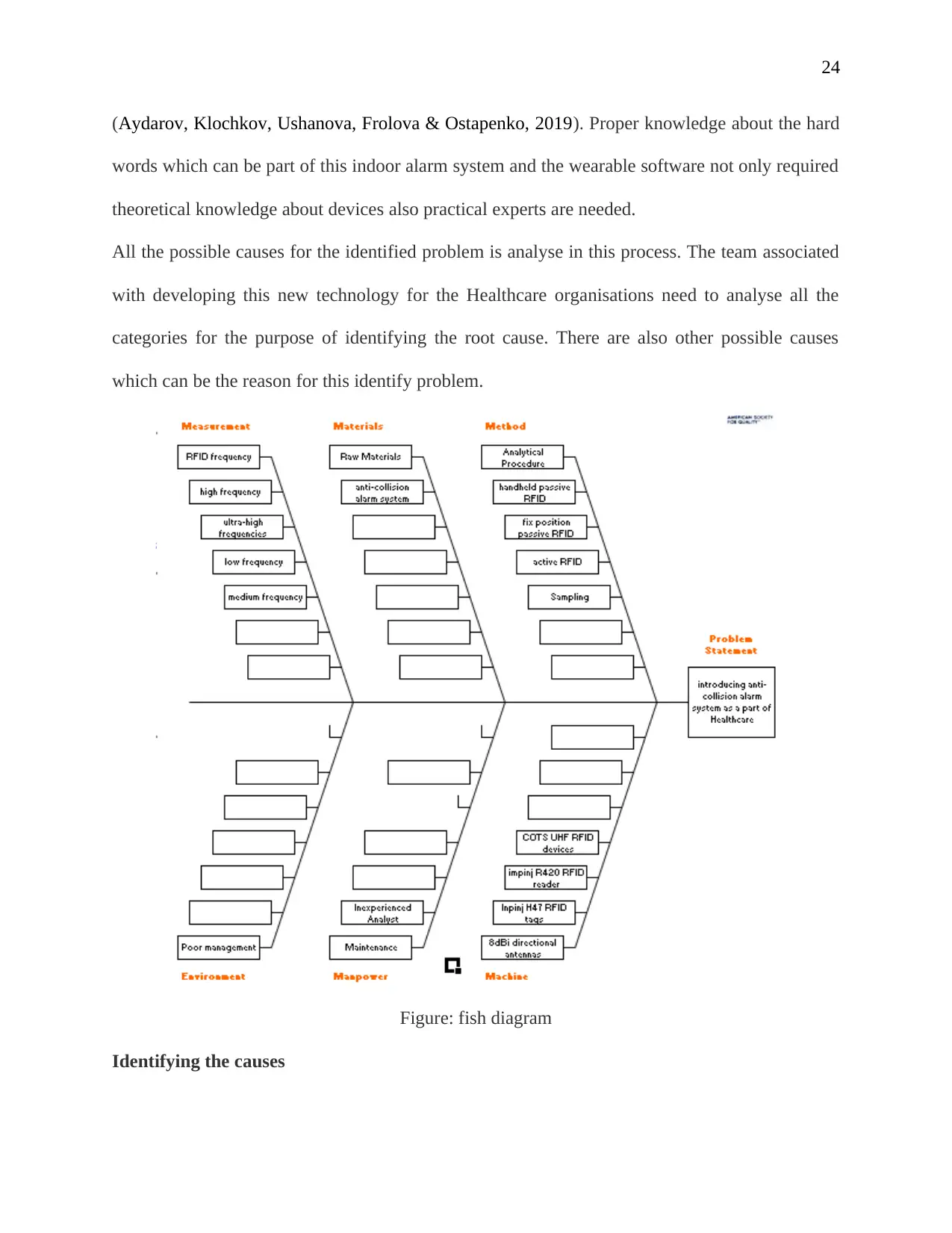
24
(Aydarov, Klochkov, Ushanova, Frolova & Ostapenko, 2019). Proper knowledge about the hard
words which can be part of this indoor alarm system and the wearable software not only required
theoretical knowledge about devices also practical experts are needed.
All the possible causes for the identified problem is analyse in this process. The team associated
with developing this new technology for the Healthcare organisations need to analyse all the
categories for the purpose of identifying the root cause. There are also other possible causes
which can be the reason for this identify problem.
Figure: fish diagram
Identifying the causes
(Aydarov, Klochkov, Ushanova, Frolova & Ostapenko, 2019). Proper knowledge about the hard
words which can be part of this indoor alarm system and the wearable software not only required
theoretical knowledge about devices also practical experts are needed.
All the possible causes for the identified problem is analyse in this process. The team associated
with developing this new technology for the Healthcare organisations need to analyse all the
categories for the purpose of identifying the root cause. There are also other possible causes
which can be the reason for this identify problem.
Figure: fish diagram
Identifying the causes
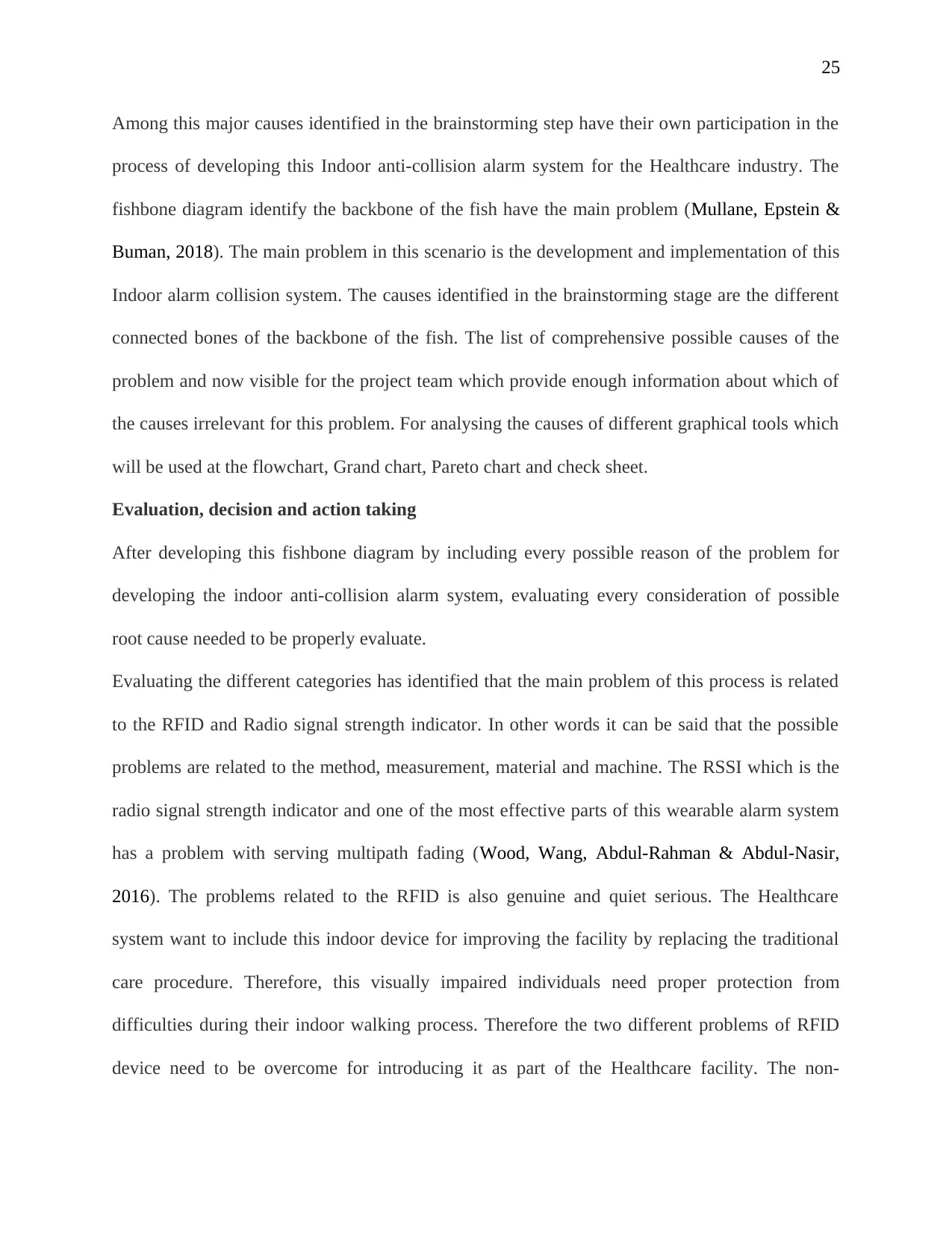
25
Among this major causes identified in the brainstorming step have their own participation in the
process of developing this Indoor anti-collision alarm system for the Healthcare industry. The
fishbone diagram identify the backbone of the fish have the main problem (Mullane, Epstein &
Buman, 2018). The main problem in this scenario is the development and implementation of this
Indoor alarm collision system. The causes identified in the brainstorming stage are the different
connected bones of the backbone of the fish. The list of comprehensive possible causes of the
problem and now visible for the project team which provide enough information about which of
the causes irrelevant for this problem. For analysing the causes of different graphical tools which
will be used at the flowchart, Grand chart, Pareto chart and check sheet.
Evaluation, decision and action taking
After developing this fishbone diagram by including every possible reason of the problem for
developing the indoor anti-collision alarm system, evaluating every consideration of possible
root cause needed to be properly evaluate.
Evaluating the different categories has identified that the main problem of this process is related
to the RFID and Radio signal strength indicator. In other words it can be said that the possible
problems are related to the method, measurement, material and machine. The RSSI which is the
radio signal strength indicator and one of the most effective parts of this wearable alarm system
has a problem with serving multipath fading (Wood, Wang, Abdul-Rahman & Abdul-Nasir,
2016). The problems related to the RFID is also genuine and quiet serious. The Healthcare
system want to include this indoor device for improving the facility by replacing the traditional
care procedure. Therefore, this visually impaired individuals need proper protection from
difficulties during their indoor walking process. Therefore the two different problems of RFID
device need to be overcome for introducing it as part of the Healthcare facility. The non-
Among this major causes identified in the brainstorming step have their own participation in the
process of developing this Indoor anti-collision alarm system for the Healthcare industry. The
fishbone diagram identify the backbone of the fish have the main problem (Mullane, Epstein &
Buman, 2018). The main problem in this scenario is the development and implementation of this
Indoor alarm collision system. The causes identified in the brainstorming stage are the different
connected bones of the backbone of the fish. The list of comprehensive possible causes of the
problem and now visible for the project team which provide enough information about which of
the causes irrelevant for this problem. For analysing the causes of different graphical tools which
will be used at the flowchart, Grand chart, Pareto chart and check sheet.
Evaluation, decision and action taking
After developing this fishbone diagram by including every possible reason of the problem for
developing the indoor anti-collision alarm system, evaluating every consideration of possible
root cause needed to be properly evaluate.
Evaluating the different categories has identified that the main problem of this process is related
to the RFID and Radio signal strength indicator. In other words it can be said that the possible
problems are related to the method, measurement, material and machine. The RSSI which is the
radio signal strength indicator and one of the most effective parts of this wearable alarm system
has a problem with serving multipath fading (Wood, Wang, Abdul-Rahman & Abdul-Nasir,
2016). The problems related to the RFID is also genuine and quiet serious. The Healthcare
system want to include this indoor device for improving the facility by replacing the traditional
care procedure. Therefore, this visually impaired individuals need proper protection from
difficulties during their indoor walking process. Therefore the two different problems of RFID
device need to be overcome for introducing it as part of the Healthcare facility. The non-
Paraphrase This Document
Need a fresh take? Get an instant paraphrase of this document with our AI Paraphraser
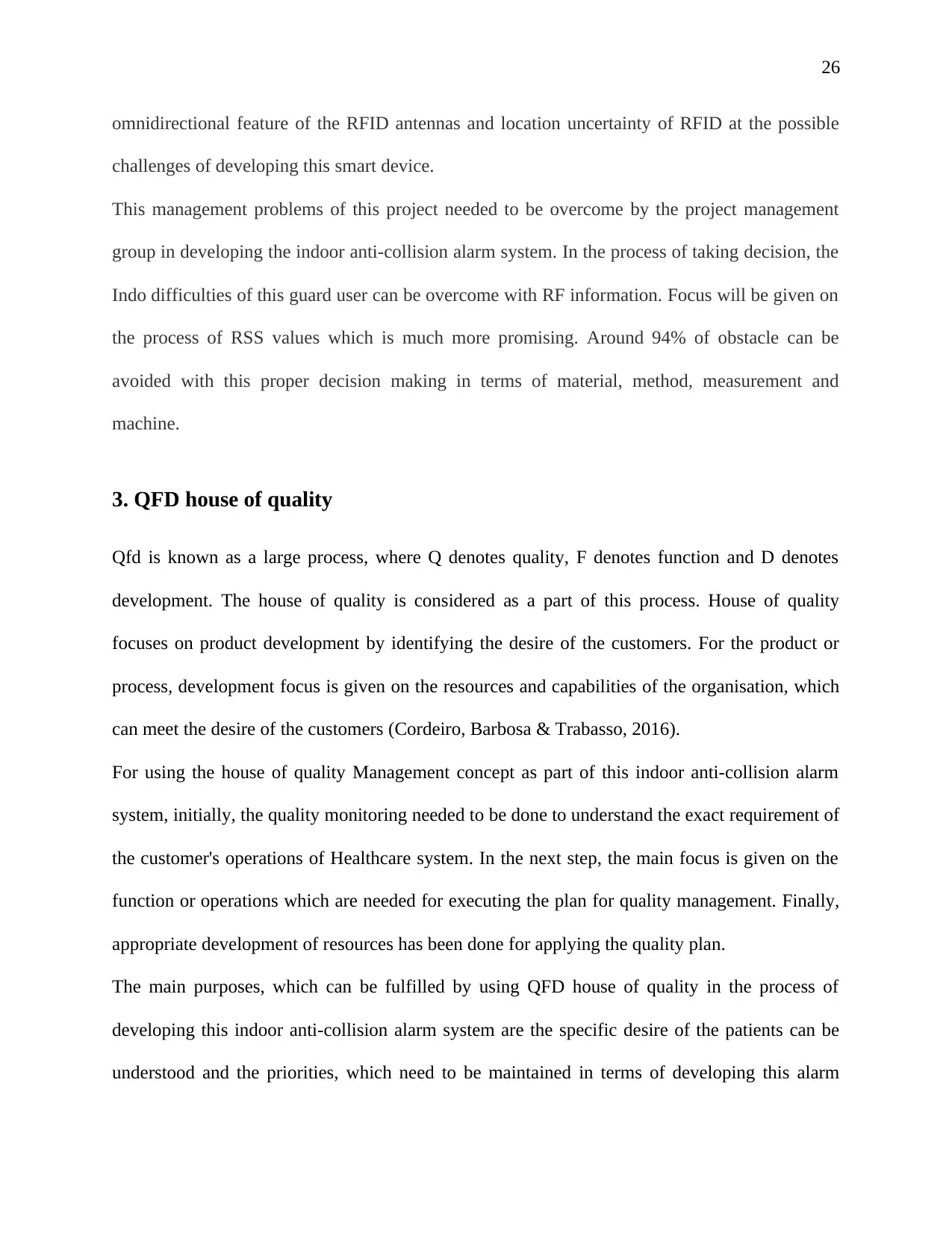
26
omnidirectional feature of the RFID antennas and location uncertainty of RFID at the possible
challenges of developing this smart device.
This management problems of this project needed to be overcome by the project management
group in developing the indoor anti-collision alarm system. In the process of taking decision, the
Indo difficulties of this guard user can be overcome with RF information. Focus will be given on
the process of RSS values which is much more promising. Around 94% of obstacle can be
avoided with this proper decision making in terms of material, method, measurement and
machine.
3. QFD house of quality
Qfd is known as a large process, where Q denotes quality, F denotes function and D denotes
development. The house of quality is considered as a part of this process. House of quality
focuses on product development by identifying the desire of the customers. For the product or
process, development focus is given on the resources and capabilities of the organisation, which
can meet the desire of the customers (Cordeiro, Barbosa & Trabasso, 2016).
For using the house of quality Management concept as part of this indoor anti-collision alarm
system, initially, the quality monitoring needed to be done to understand the exact requirement of
the customer's operations of Healthcare system. In the next step, the main focus is given on the
function or operations which are needed for executing the plan for quality management. Finally,
appropriate development of resources has been done for applying the quality plan.
The main purposes, which can be fulfilled by using QFD house of quality in the process of
developing this indoor anti-collision alarm system are the specific desire of the patients can be
understood and the priorities, which need to be maintained in terms of developing this alarm
omnidirectional feature of the RFID antennas and location uncertainty of RFID at the possible
challenges of developing this smart device.
This management problems of this project needed to be overcome by the project management
group in developing the indoor anti-collision alarm system. In the process of taking decision, the
Indo difficulties of this guard user can be overcome with RF information. Focus will be given on
the process of RSS values which is much more promising. Around 94% of obstacle can be
avoided with this proper decision making in terms of material, method, measurement and
machine.
3. QFD house of quality
Qfd is known as a large process, where Q denotes quality, F denotes function and D denotes
development. The house of quality is considered as a part of this process. House of quality
focuses on product development by identifying the desire of the customers. For the product or
process, development focus is given on the resources and capabilities of the organisation, which
can meet the desire of the customers (Cordeiro, Barbosa & Trabasso, 2016).
For using the house of quality Management concept as part of this indoor anti-collision alarm
system, initially, the quality monitoring needed to be done to understand the exact requirement of
the customer's operations of Healthcare system. In the next step, the main focus is given on the
function or operations which are needed for executing the plan for quality management. Finally,
appropriate development of resources has been done for applying the quality plan.
The main purposes, which can be fulfilled by using QFD house of quality in the process of
developing this indoor anti-collision alarm system are the specific desire of the patients can be
understood and the priorities, which need to be maintained in terms of developing this alarm
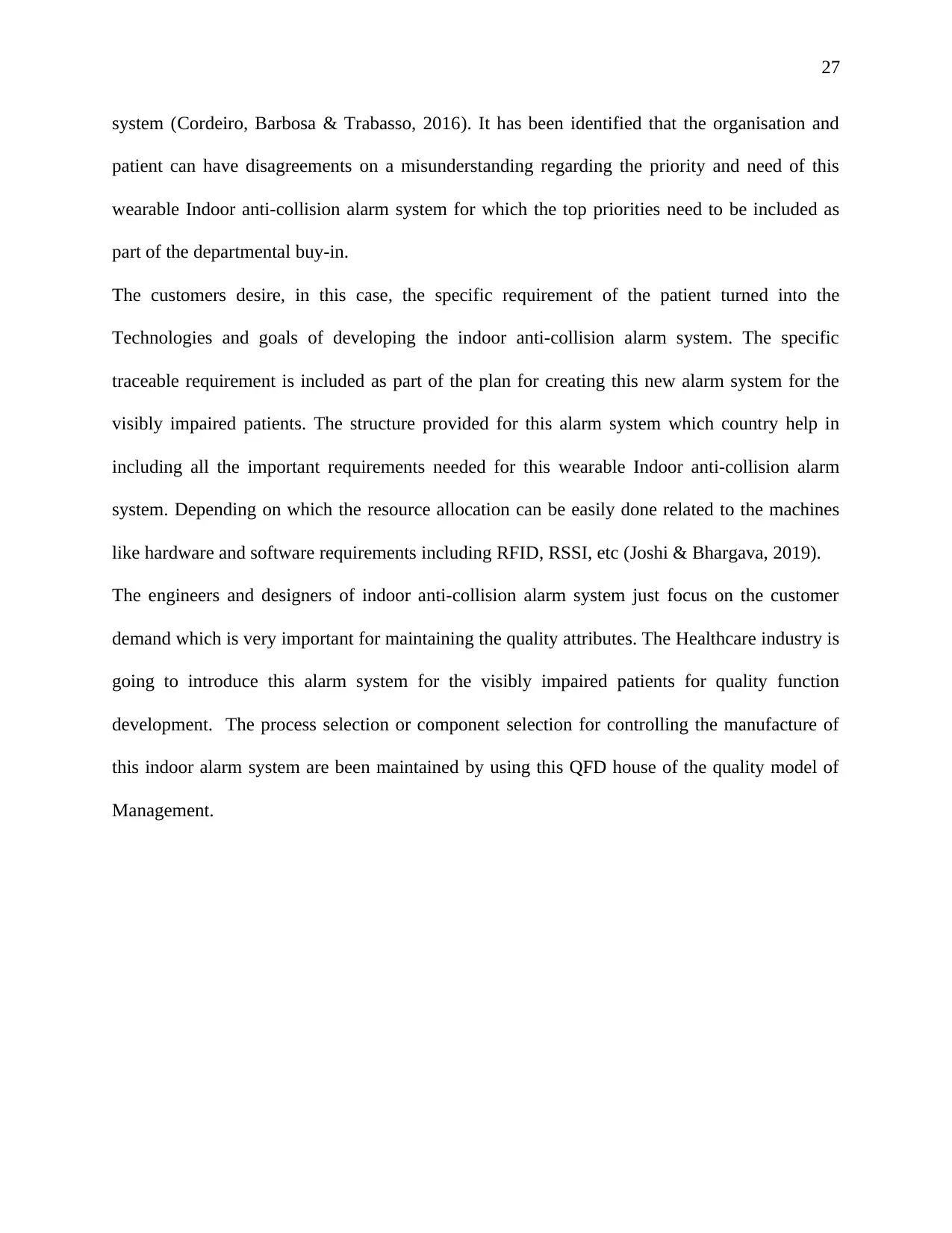
27
system (Cordeiro, Barbosa & Trabasso, 2016). It has been identified that the organisation and
patient can have disagreements on a misunderstanding regarding the priority and need of this
wearable Indoor anti-collision alarm system for which the top priorities need to be included as
part of the departmental buy-in.
The customers desire, in this case, the specific requirement of the patient turned into the
Technologies and goals of developing the indoor anti-collision alarm system. The specific
traceable requirement is included as part of the plan for creating this new alarm system for the
visibly impaired patients. The structure provided for this alarm system which country help in
including all the important requirements needed for this wearable Indoor anti-collision alarm
system. Depending on which the resource allocation can be easily done related to the machines
like hardware and software requirements including RFID, RSSI, etc (Joshi & Bhargava, 2019).
The engineers and designers of indoor anti-collision alarm system just focus on the customer
demand which is very important for maintaining the quality attributes. The Healthcare industry is
going to introduce this alarm system for the visibly impaired patients for quality function
development. The process selection or component selection for controlling the manufacture of
this indoor alarm system are been maintained by using this QFD house of the quality model of
Management.
system (Cordeiro, Barbosa & Trabasso, 2016). It has been identified that the organisation and
patient can have disagreements on a misunderstanding regarding the priority and need of this
wearable Indoor anti-collision alarm system for which the top priorities need to be included as
part of the departmental buy-in.
The customers desire, in this case, the specific requirement of the patient turned into the
Technologies and goals of developing the indoor anti-collision alarm system. The specific
traceable requirement is included as part of the plan for creating this new alarm system for the
visibly impaired patients. The structure provided for this alarm system which country help in
including all the important requirements needed for this wearable Indoor anti-collision alarm
system. Depending on which the resource allocation can be easily done related to the machines
like hardware and software requirements including RFID, RSSI, etc (Joshi & Bhargava, 2019).
The engineers and designers of indoor anti-collision alarm system just focus on the customer
demand which is very important for maintaining the quality attributes. The Healthcare industry is
going to introduce this alarm system for the visibly impaired patients for quality function
development. The process selection or component selection for controlling the manufacture of
this indoor alarm system are been maintained by using this QFD house of the quality model of
Management.
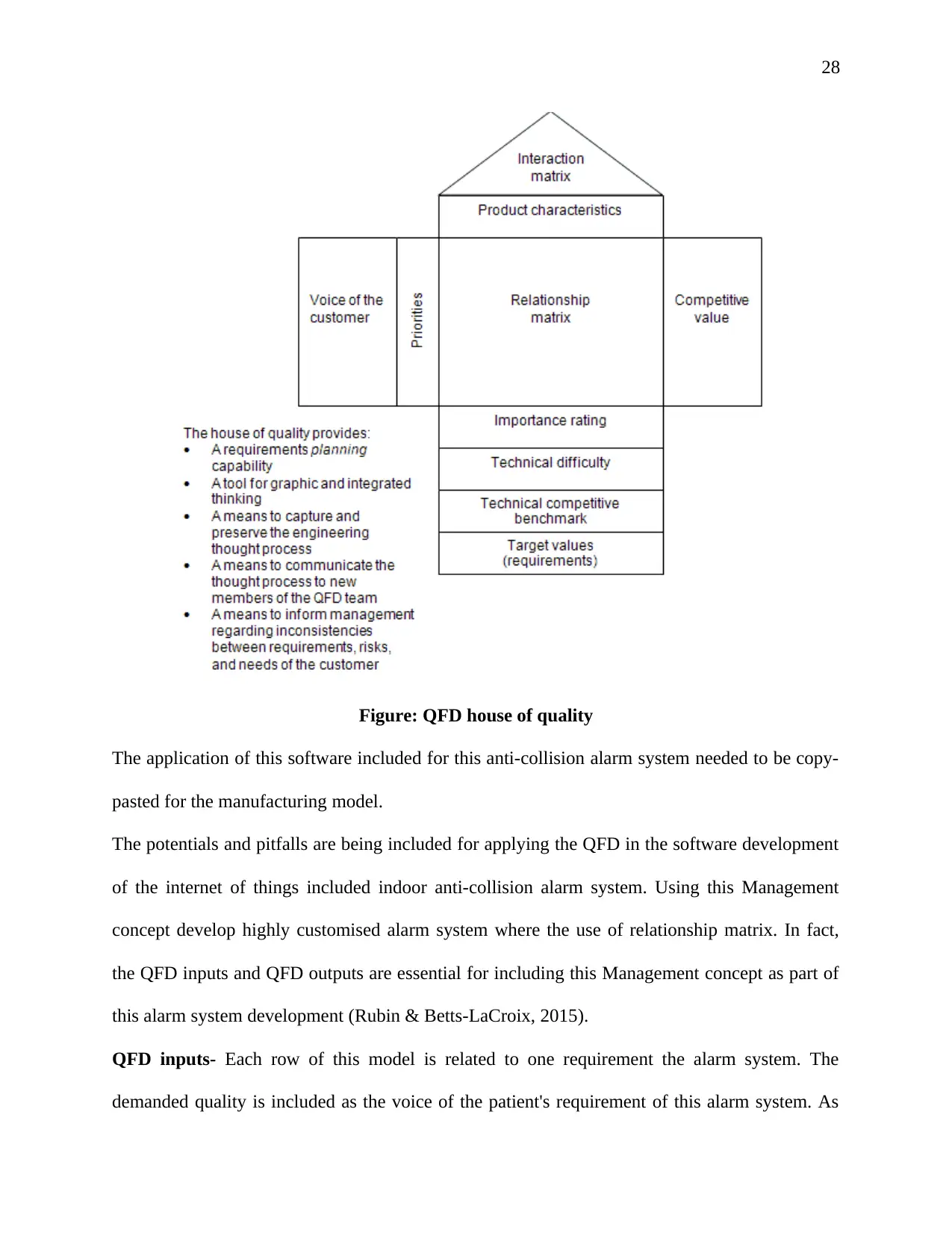
28
Figure: QFD house of quality
The application of this software included for this anti-collision alarm system needed to be copy-
pasted for the manufacturing model.
The potentials and pitfalls are being included for applying the QFD in the software development
of the internet of things included indoor anti-collision alarm system. Using this Management
concept develop highly customised alarm system where the use of relationship matrix. In fact,
the QFD inputs and QFD outputs are essential for including this Management concept as part of
this alarm system development (Rubin & Betts-LaCroix, 2015).
QFD inputs- Each row of this model is related to one requirement the alarm system. The
demanded quality is included as the voice of the patient's requirement of this alarm system. As
Figure: QFD house of quality
The application of this software included for this anti-collision alarm system needed to be copy-
pasted for the manufacturing model.
The potentials and pitfalls are being included for applying the QFD in the software development
of the internet of things included indoor anti-collision alarm system. Using this Management
concept develop highly customised alarm system where the use of relationship matrix. In fact,
the QFD inputs and QFD outputs are essential for including this Management concept as part of
this alarm system development (Rubin & Betts-LaCroix, 2015).
QFD inputs- Each row of this model is related to one requirement the alarm system. The
demanded quality is included as the voice of the patient's requirement of this alarm system. As
Secure Best Marks with AI Grader
Need help grading? Try our AI Grader for instant feedback on your assignments.
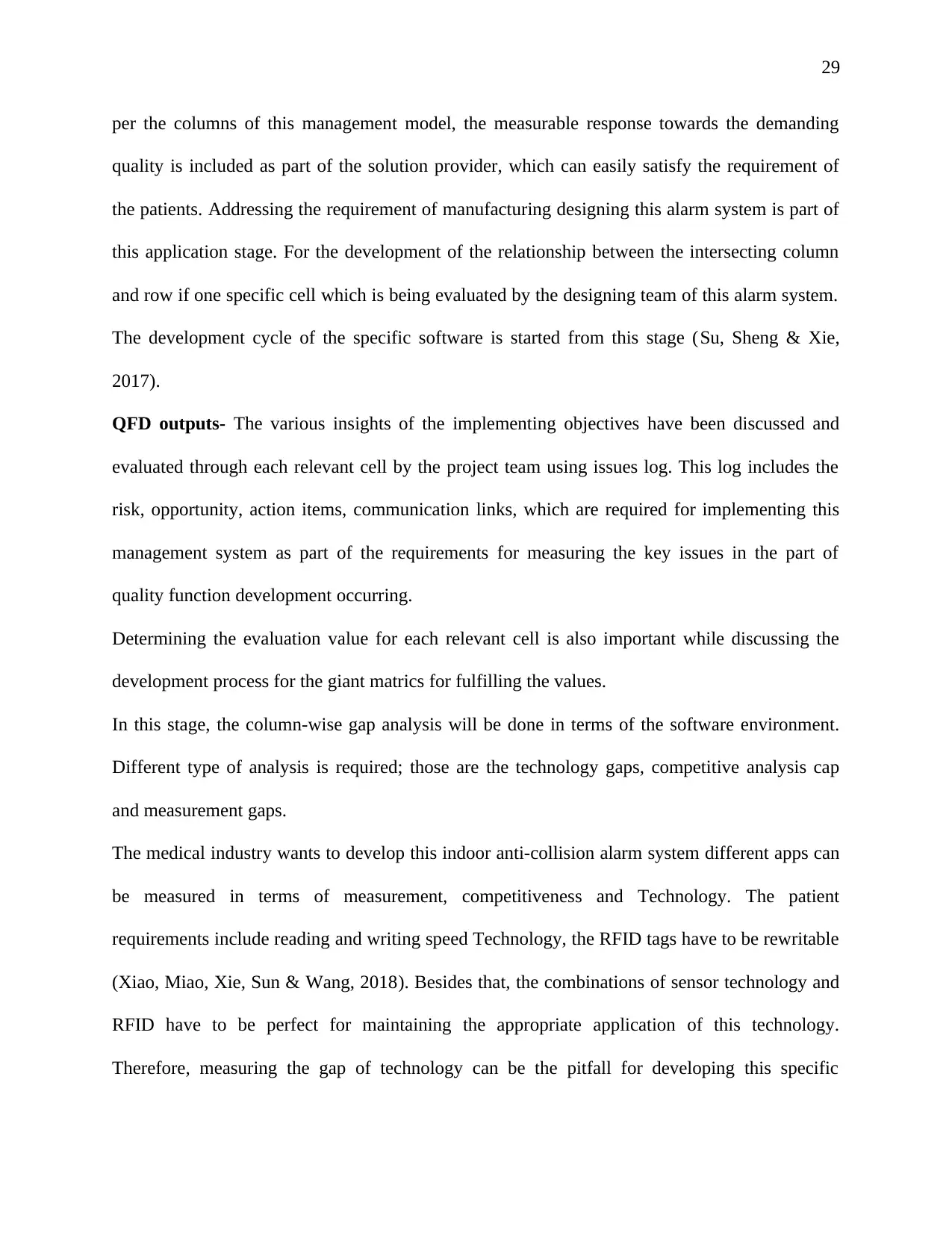
29
per the columns of this management model, the measurable response towards the demanding
quality is included as part of the solution provider, which can easily satisfy the requirement of
the patients. Addressing the requirement of manufacturing designing this alarm system is part of
this application stage. For the development of the relationship between the intersecting column
and row if one specific cell which is being evaluated by the designing team of this alarm system.
The development cycle of the specific software is started from this stage (Su, Sheng & Xie,
2017).
QFD outputs- The various insights of the implementing objectives have been discussed and
evaluated through each relevant cell by the project team using issues log. This log includes the
risk, opportunity, action items, communication links, which are required for implementing this
management system as part of the requirements for measuring the key issues in the part of
quality function development occurring.
Determining the evaluation value for each relevant cell is also important while discussing the
development process for the giant matrics for fulfilling the values.
In this stage, the column-wise gap analysis will be done in terms of the software environment.
Different type of analysis is required; those are the technology gaps, competitive analysis cap
and measurement gaps.
The medical industry wants to develop this indoor anti-collision alarm system different apps can
be measured in terms of measurement, competitiveness and Technology. The patient
requirements include reading and writing speed Technology, the RFID tags have to be rewritable
(Xiao, Miao, Xie, Sun & Wang, 2018). Besides that, the combinations of sensor technology and
RFID have to be perfect for maintaining the appropriate application of this technology.
Therefore, measuring the gap of technology can be the pitfall for developing this specific
per the columns of this management model, the measurable response towards the demanding
quality is included as part of the solution provider, which can easily satisfy the requirement of
the patients. Addressing the requirement of manufacturing designing this alarm system is part of
this application stage. For the development of the relationship between the intersecting column
and row if one specific cell which is being evaluated by the designing team of this alarm system.
The development cycle of the specific software is started from this stage (Su, Sheng & Xie,
2017).
QFD outputs- The various insights of the implementing objectives have been discussed and
evaluated through each relevant cell by the project team using issues log. This log includes the
risk, opportunity, action items, communication links, which are required for implementing this
management system as part of the requirements for measuring the key issues in the part of
quality function development occurring.
Determining the evaluation value for each relevant cell is also important while discussing the
development process for the giant matrics for fulfilling the values.
In this stage, the column-wise gap analysis will be done in terms of the software environment.
Different type of analysis is required; those are the technology gaps, competitive analysis cap
and measurement gaps.
The medical industry wants to develop this indoor anti-collision alarm system different apps can
be measured in terms of measurement, competitiveness and Technology. The patient
requirements include reading and writing speed Technology, the RFID tags have to be rewritable
(Xiao, Miao, Xie, Sun & Wang, 2018). Besides that, the combinations of sensor technology and
RFID have to be perfect for maintaining the appropriate application of this technology.
Therefore, measuring the gap of technology can be the pitfall for developing this specific
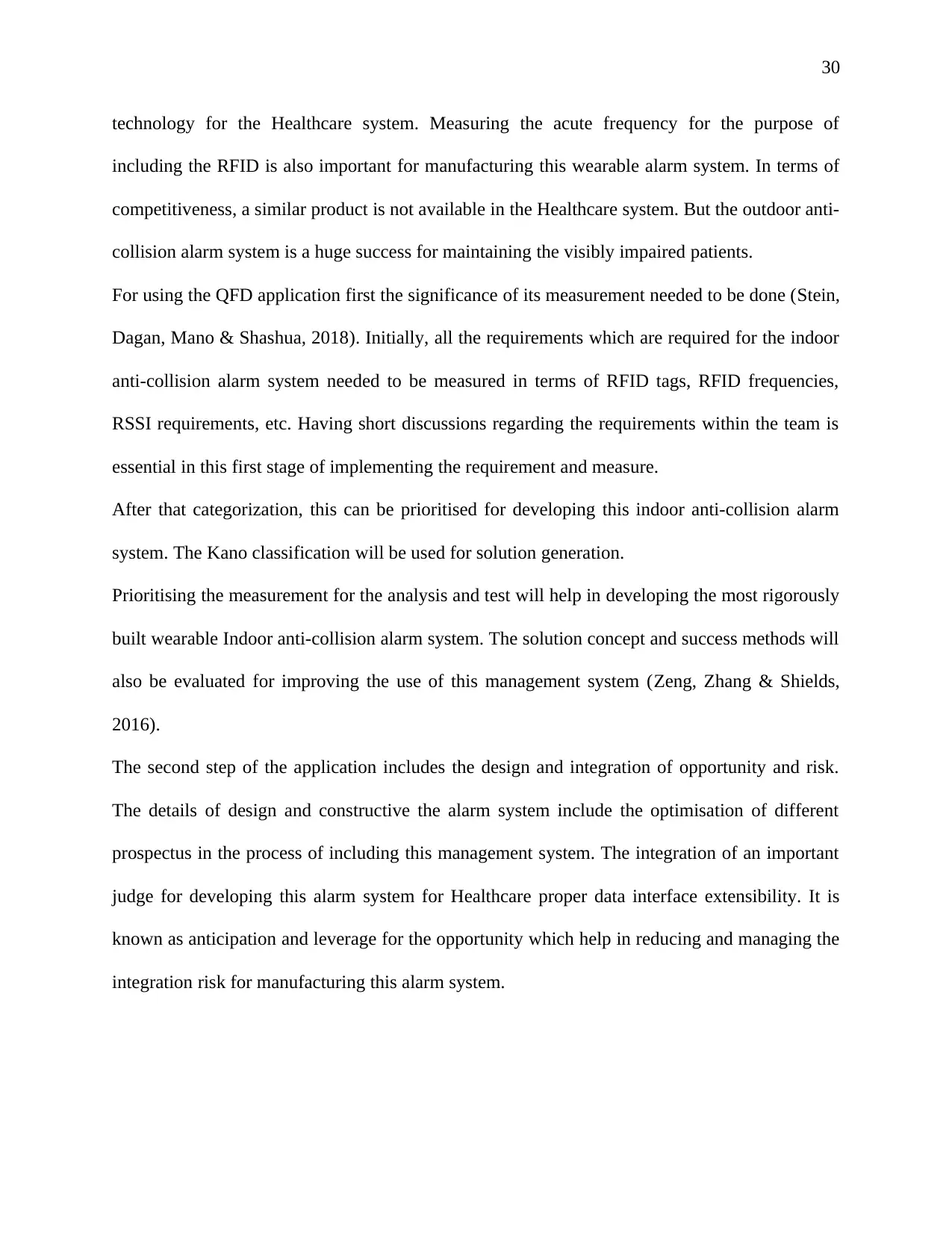
30
technology for the Healthcare system. Measuring the acute frequency for the purpose of
including the RFID is also important for manufacturing this wearable alarm system. In terms of
competitiveness, a similar product is not available in the Healthcare system. But the outdoor anti-
collision alarm system is a huge success for maintaining the visibly impaired patients.
For using the QFD application first the significance of its measurement needed to be done (Stein,
Dagan, Mano & Shashua, 2018). Initially, all the requirements which are required for the indoor
anti-collision alarm system needed to be measured in terms of RFID tags, RFID frequencies,
RSSI requirements, etc. Having short discussions regarding the requirements within the team is
essential in this first stage of implementing the requirement and measure.
After that categorization, this can be prioritised for developing this indoor anti-collision alarm
system. The Kano classification will be used for solution generation.
Prioritising the measurement for the analysis and test will help in developing the most rigorously
built wearable Indoor anti-collision alarm system. The solution concept and success methods will
also be evaluated for improving the use of this management system (Zeng, Zhang & Shields,
2016).
The second step of the application includes the design and integration of opportunity and risk.
The details of design and constructive the alarm system include the optimisation of different
prospectus in the process of including this management system. The integration of an important
judge for developing this alarm system for Healthcare proper data interface extensibility. It is
known as anticipation and leverage for the opportunity which help in reducing and managing the
integration risk for manufacturing this alarm system.
technology for the Healthcare system. Measuring the acute frequency for the purpose of
including the RFID is also important for manufacturing this wearable alarm system. In terms of
competitiveness, a similar product is not available in the Healthcare system. But the outdoor anti-
collision alarm system is a huge success for maintaining the visibly impaired patients.
For using the QFD application first the significance of its measurement needed to be done (Stein,
Dagan, Mano & Shashua, 2018). Initially, all the requirements which are required for the indoor
anti-collision alarm system needed to be measured in terms of RFID tags, RFID frequencies,
RSSI requirements, etc. Having short discussions regarding the requirements within the team is
essential in this first stage of implementing the requirement and measure.
After that categorization, this can be prioritised for developing this indoor anti-collision alarm
system. The Kano classification will be used for solution generation.
Prioritising the measurement for the analysis and test will help in developing the most rigorously
built wearable Indoor anti-collision alarm system. The solution concept and success methods will
also be evaluated for improving the use of this management system (Zeng, Zhang & Shields,
2016).
The second step of the application includes the design and integration of opportunity and risk.
The details of design and constructive the alarm system include the optimisation of different
prospectus in the process of including this management system. The integration of an important
judge for developing this alarm system for Healthcare proper data interface extensibility. It is
known as anticipation and leverage for the opportunity which help in reducing and managing the
integration risk for manufacturing this alarm system.
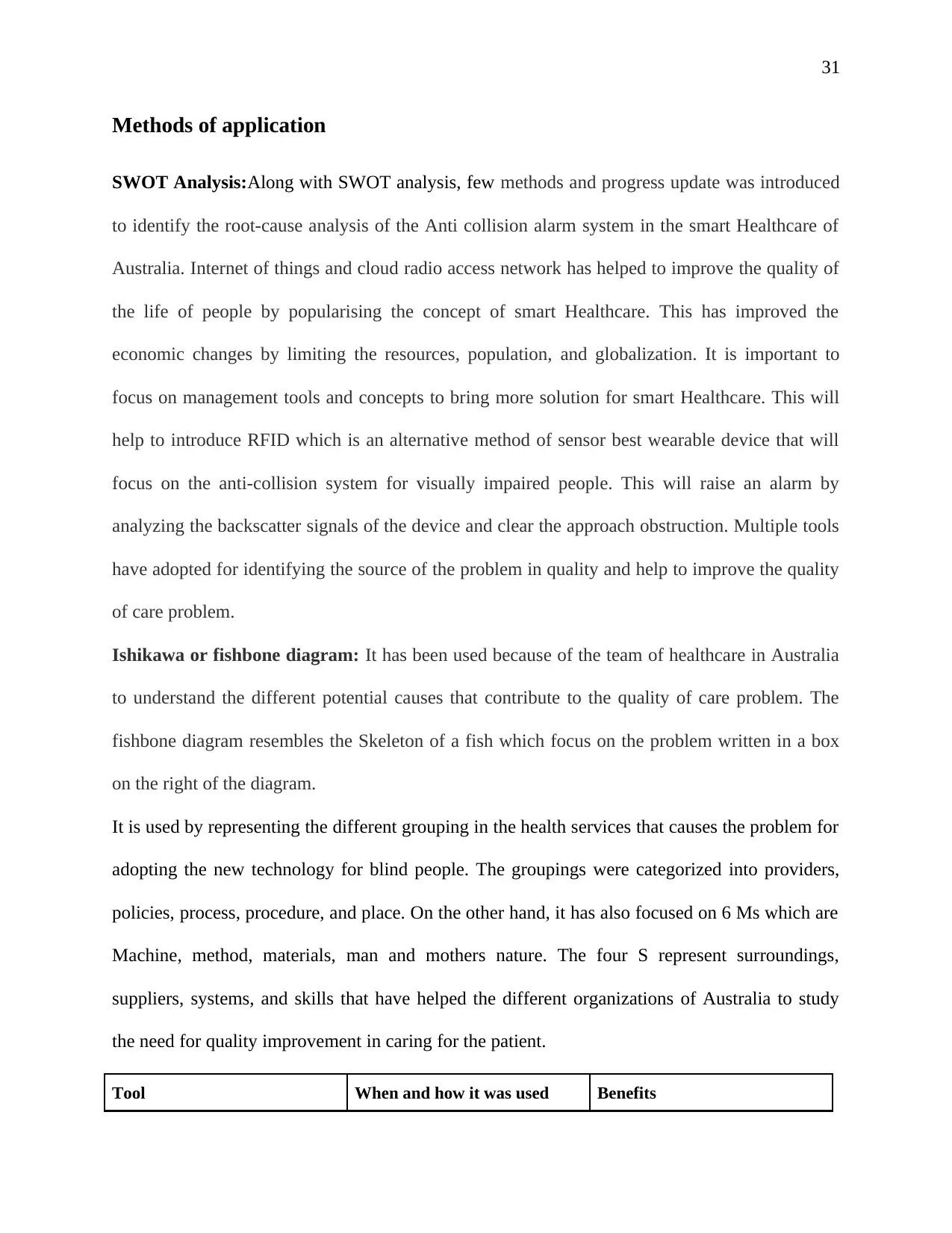
31
Methods of application
SWOT Analysis:Along with SWOT analysis, few methods and progress update was introduced
to identify the root-cause analysis of the Anti collision alarm system in the smart Healthcare of
Australia. Internet of things and cloud radio access network has helped to improve the quality of
the life of people by popularising the concept of smart Healthcare. This has improved the
economic changes by limiting the resources, population, and globalization. It is important to
focus on management tools and concepts to bring more solution for smart Healthcare. This will
help to introduce RFID which is an alternative method of sensor best wearable device that will
focus on the anti-collision system for visually impaired people. This will raise an alarm by
analyzing the backscatter signals of the device and clear the approach obstruction. Multiple tools
have adopted for identifying the source of the problem in quality and help to improve the quality
of care problem.
Ishikawa or fishbone diagram: It has been used because of the team of healthcare in Australia
to understand the different potential causes that contribute to the quality of care problem. The
fishbone diagram resembles the Skeleton of a fish which focus on the problem written in a box
on the right of the diagram.
It is used by representing the different grouping in the health services that causes the problem for
adopting the new technology for blind people. The groupings were categorized into providers,
policies, process, procedure, and place. On the other hand, it has also focused on 6 Ms which are
Machine, method, materials, man and mothers nature. The four S represent surroundings,
suppliers, systems, and skills that have helped the different organizations of Australia to study
the need for quality improvement in caring for the patient.
Tool When and how it was used Benefits
Methods of application
SWOT Analysis:Along with SWOT analysis, few methods and progress update was introduced
to identify the root-cause analysis of the Anti collision alarm system in the smart Healthcare of
Australia. Internet of things and cloud radio access network has helped to improve the quality of
the life of people by popularising the concept of smart Healthcare. This has improved the
economic changes by limiting the resources, population, and globalization. It is important to
focus on management tools and concepts to bring more solution for smart Healthcare. This will
help to introduce RFID which is an alternative method of sensor best wearable device that will
focus on the anti-collision system for visually impaired people. This will raise an alarm by
analyzing the backscatter signals of the device and clear the approach obstruction. Multiple tools
have adopted for identifying the source of the problem in quality and help to improve the quality
of care problem.
Ishikawa or fishbone diagram: It has been used because of the team of healthcare in Australia
to understand the different potential causes that contribute to the quality of care problem. The
fishbone diagram resembles the Skeleton of a fish which focus on the problem written in a box
on the right of the diagram.
It is used by representing the different grouping in the health services that causes the problem for
adopting the new technology for blind people. The groupings were categorized into providers,
policies, process, procedure, and place. On the other hand, it has also focused on 6 Ms which are
Machine, method, materials, man and mothers nature. The four S represent surroundings,
suppliers, systems, and skills that have helped the different organizations of Australia to study
the need for quality improvement in caring for the patient.
Tool When and how it was used Benefits
Paraphrase This Document
Need a fresh take? Get an instant paraphrase of this document with our AI Paraphraser
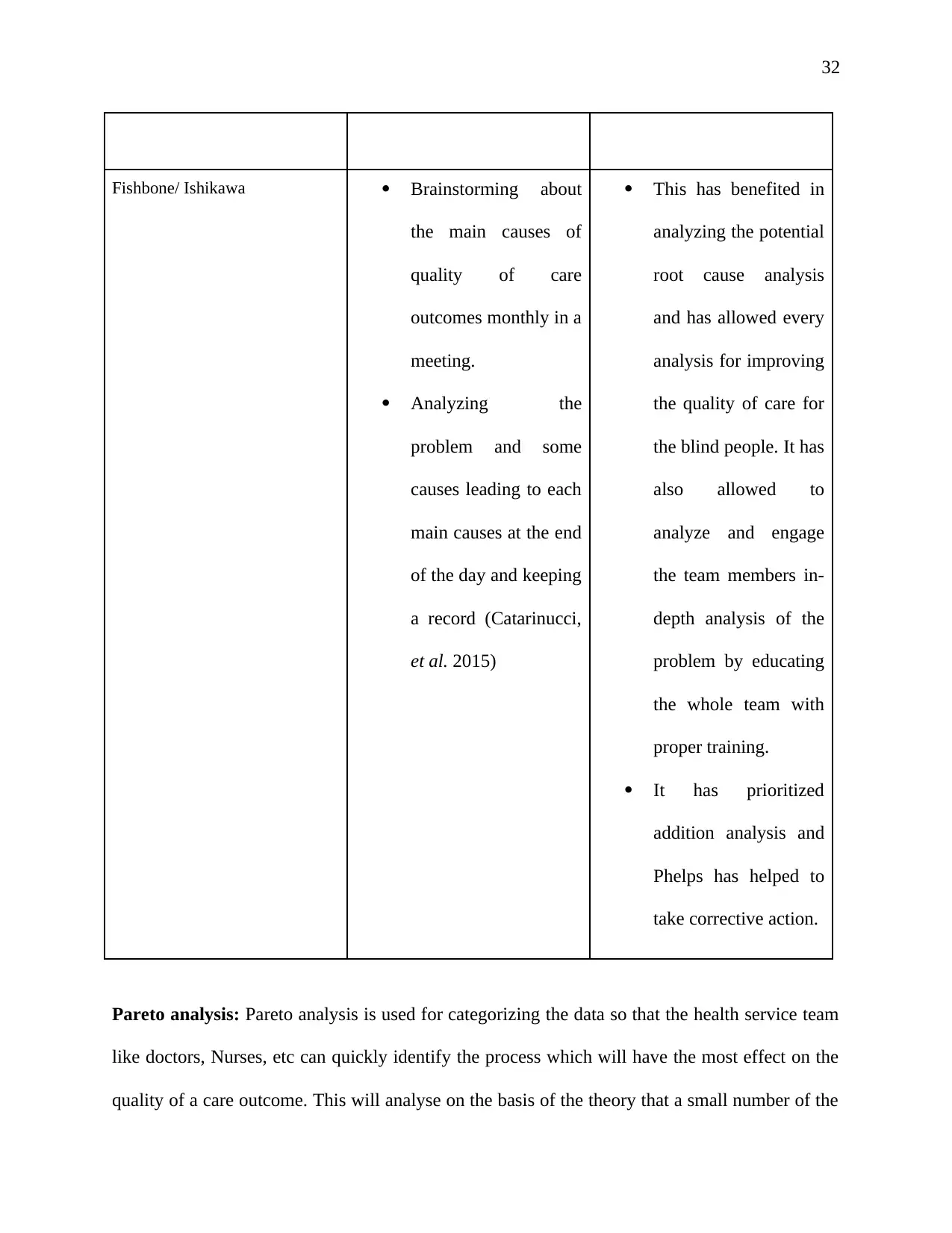
32
Fishbone/ Ishikawa Brainstorming about
the main causes of
quality of care
outcomes monthly in a
meeting.
Analyzing the
problem and some
causes leading to each
main causes at the end
of the day and keeping
a record (Catarinucci,
et al. 2015)
This has benefited in
analyzing the potential
root cause analysis
and has allowed every
analysis for improving
the quality of care for
the blind people. It has
also allowed to
analyze and engage
the team members in-
depth analysis of the
problem by educating
the whole team with
proper training.
It has prioritized
addition analysis and
Phelps has helped to
take corrective action.
Pareto analysis: Pareto analysis is used for categorizing the data so that the health service team
like doctors, Nurses, etc can quickly identify the process which will have the most effect on the
quality of a care outcome. This will analyse on the basis of the theory that a small number of the
Fishbone/ Ishikawa Brainstorming about
the main causes of
quality of care
outcomes monthly in a
meeting.
Analyzing the
problem and some
causes leading to each
main causes at the end
of the day and keeping
a record (Catarinucci,
et al. 2015)
This has benefited in
analyzing the potential
root cause analysis
and has allowed every
analysis for improving
the quality of care for
the blind people. It has
also allowed to
analyze and engage
the team members in-
depth analysis of the
problem by educating
the whole team with
proper training.
It has prioritized
addition analysis and
Phelps has helped to
take corrective action.
Pareto analysis: Pareto analysis is used for categorizing the data so that the health service team
like doctors, Nurses, etc can quickly identify the process which will have the most effect on the
quality of a care outcome. This will analyse on the basis of the theory that a small number of the
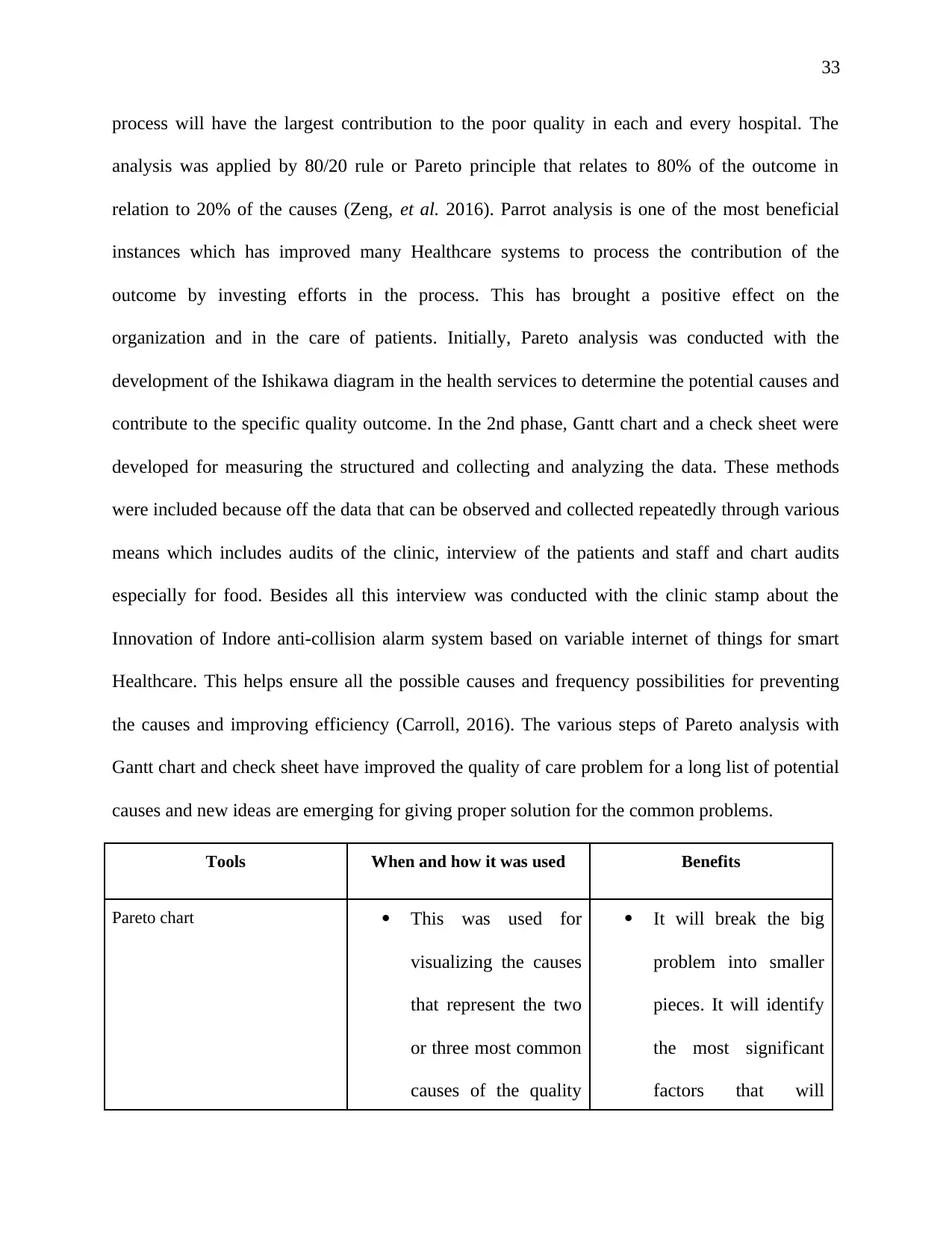
33
process will have the largest contribution to the poor quality in each and every hospital. The
analysis was applied by 80/20 rule or Pareto principle that relates to 80% of the outcome in
relation to 20% of the causes (Zeng, et al. 2016). Parrot analysis is one of the most beneficial
instances which has improved many Healthcare systems to process the contribution of the
outcome by investing efforts in the process. This has brought a positive effect on the
organization and in the care of patients. Initially, Pareto analysis was conducted with the
development of the Ishikawa diagram in the health services to determine the potential causes and
contribute to the specific quality outcome. In the 2nd phase, Gantt chart and a check sheet were
developed for measuring the structured and collecting and analyzing the data. These methods
were included because off the data that can be observed and collected repeatedly through various
means which includes audits of the clinic, interview of the patients and staff and chart audits
especially for food. Besides all this interview was conducted with the clinic stamp about the
Innovation of Indore anti-collision alarm system based on variable internet of things for smart
Healthcare. This helps ensure all the possible causes and frequency possibilities for preventing
the causes and improving efficiency (Carroll, 2016). The various steps of Pareto analysis with
Gantt chart and check sheet have improved the quality of care problem for a long list of potential
causes and new ideas are emerging for giving proper solution for the common problems.
Tools When and how it was used Benefits
Pareto chart This was used for
visualizing the causes
that represent the two
or three most common
causes of the quality
It will break the big
problem into smaller
pieces. It will identify
the most significant
factors that will
process will have the largest contribution to the poor quality in each and every hospital. The
analysis was applied by 80/20 rule or Pareto principle that relates to 80% of the outcome in
relation to 20% of the causes (Zeng, et al. 2016). Parrot analysis is one of the most beneficial
instances which has improved many Healthcare systems to process the contribution of the
outcome by investing efforts in the process. This has brought a positive effect on the
organization and in the care of patients. Initially, Pareto analysis was conducted with the
development of the Ishikawa diagram in the health services to determine the potential causes and
contribute to the specific quality outcome. In the 2nd phase, Gantt chart and a check sheet were
developed for measuring the structured and collecting and analyzing the data. These methods
were included because off the data that can be observed and collected repeatedly through various
means which includes audits of the clinic, interview of the patients and staff and chart audits
especially for food. Besides all this interview was conducted with the clinic stamp about the
Innovation of Indore anti-collision alarm system based on variable internet of things for smart
Healthcare. This helps ensure all the possible causes and frequency possibilities for preventing
the causes and improving efficiency (Carroll, 2016). The various steps of Pareto analysis with
Gantt chart and check sheet have improved the quality of care problem for a long list of potential
causes and new ideas are emerging for giving proper solution for the common problems.
Tools When and how it was used Benefits
Pareto chart This was used for
visualizing the causes
that represent the two
or three most common
causes of the quality
It will break the big
problem into smaller
pieces. It will identify
the most significant
factors that will
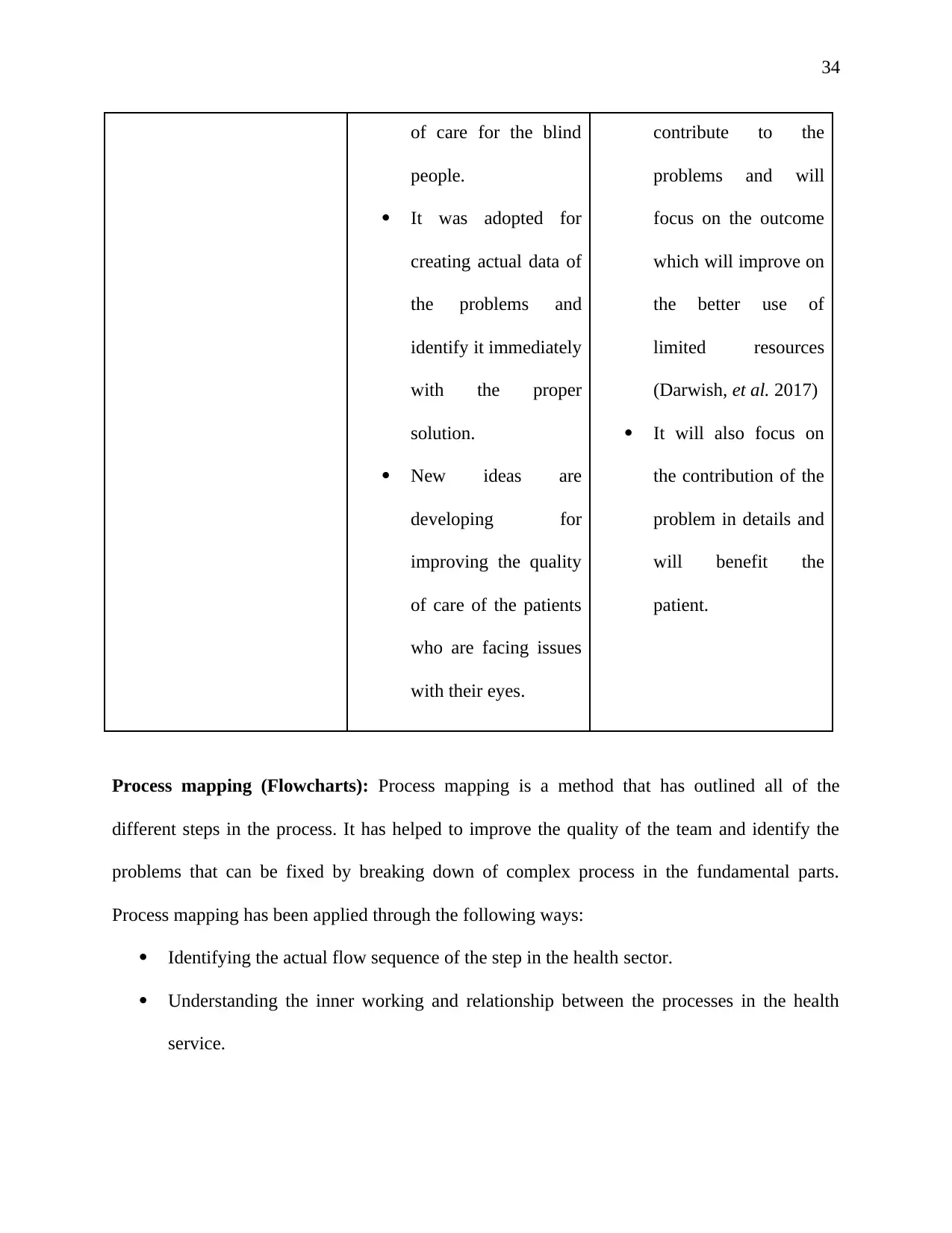
34
of care for the blind
people.
It was adopted for
creating actual data of
the problems and
identify it immediately
with the proper
solution.
New ideas are
developing for
improving the quality
of care of the patients
who are facing issues
with their eyes.
contribute to the
problems and will
focus on the outcome
which will improve on
the better use of
limited resources
(Darwish, et al. 2017)
It will also focus on
the contribution of the
problem in details and
will benefit the
patient.
Process mapping (Flowcharts): Process mapping is a method that has outlined all of the
different steps in the process. It has helped to improve the quality of the team and identify the
problems that can be fixed by breaking down of complex process in the fundamental parts.
Process mapping has been applied through the following ways:
Identifying the actual flow sequence of the step in the health sector.
Understanding the inner working and relationship between the processes in the health
service.
of care for the blind
people.
It was adopted for
creating actual data of
the problems and
identify it immediately
with the proper
solution.
New ideas are
developing for
improving the quality
of care of the patients
who are facing issues
with their eyes.
contribute to the
problems and will
focus on the outcome
which will improve on
the better use of
limited resources
(Darwish, et al. 2017)
It will also focus on
the contribution of the
problem in details and
will benefit the
patient.
Process mapping (Flowcharts): Process mapping is a method that has outlined all of the
different steps in the process. It has helped to improve the quality of the team and identify the
problems that can be fixed by breaking down of complex process in the fundamental parts.
Process mapping has been applied through the following ways:
Identifying the actual flow sequence of the step in the health sector.
Understanding the inner working and relationship between the processes in the health
service.
Secure Best Marks with AI Grader
Need help grading? Try our AI Grader for instant feedback on your assignments.
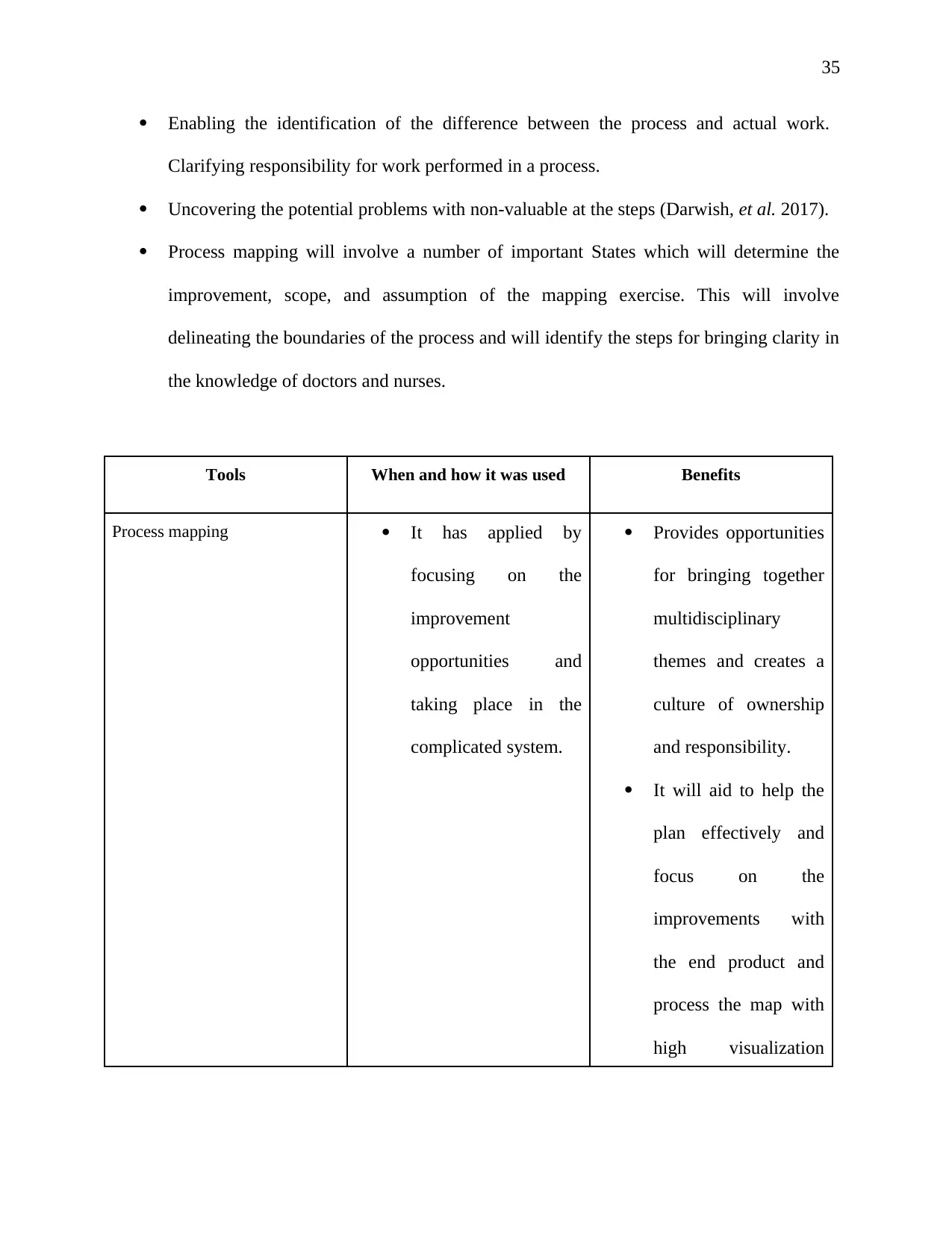
35
Enabling the identification of the difference between the process and actual work.
Clarifying responsibility for work performed in a process.
Uncovering the potential problems with non-valuable at the steps (Darwish, et al. 2017).
Process mapping will involve a number of important States which will determine the
improvement, scope, and assumption of the mapping exercise. This will involve
delineating the boundaries of the process and will identify the steps for bringing clarity in
the knowledge of doctors and nurses.
Tools When and how it was used Benefits
Process mapping It has applied by
focusing on the
improvement
opportunities and
taking place in the
complicated system.
Provides opportunities
for bringing together
multidisciplinary
themes and creates a
culture of ownership
and responsibility.
It will aid to help the
plan effectively and
focus on the
improvements with
the end product and
process the map with
high visualization
Enabling the identification of the difference between the process and actual work.
Clarifying responsibility for work performed in a process.
Uncovering the potential problems with non-valuable at the steps (Darwish, et al. 2017).
Process mapping will involve a number of important States which will determine the
improvement, scope, and assumption of the mapping exercise. This will involve
delineating the boundaries of the process and will identify the steps for bringing clarity in
the knowledge of doctors and nurses.
Tools When and how it was used Benefits
Process mapping It has applied by
focusing on the
improvement
opportunities and
taking place in the
complicated system.
Provides opportunities
for bringing together
multidisciplinary
themes and creates a
culture of ownership
and responsibility.
It will aid to help the
plan effectively and
focus on the
improvements with
the end product and
process the map with
high visualization
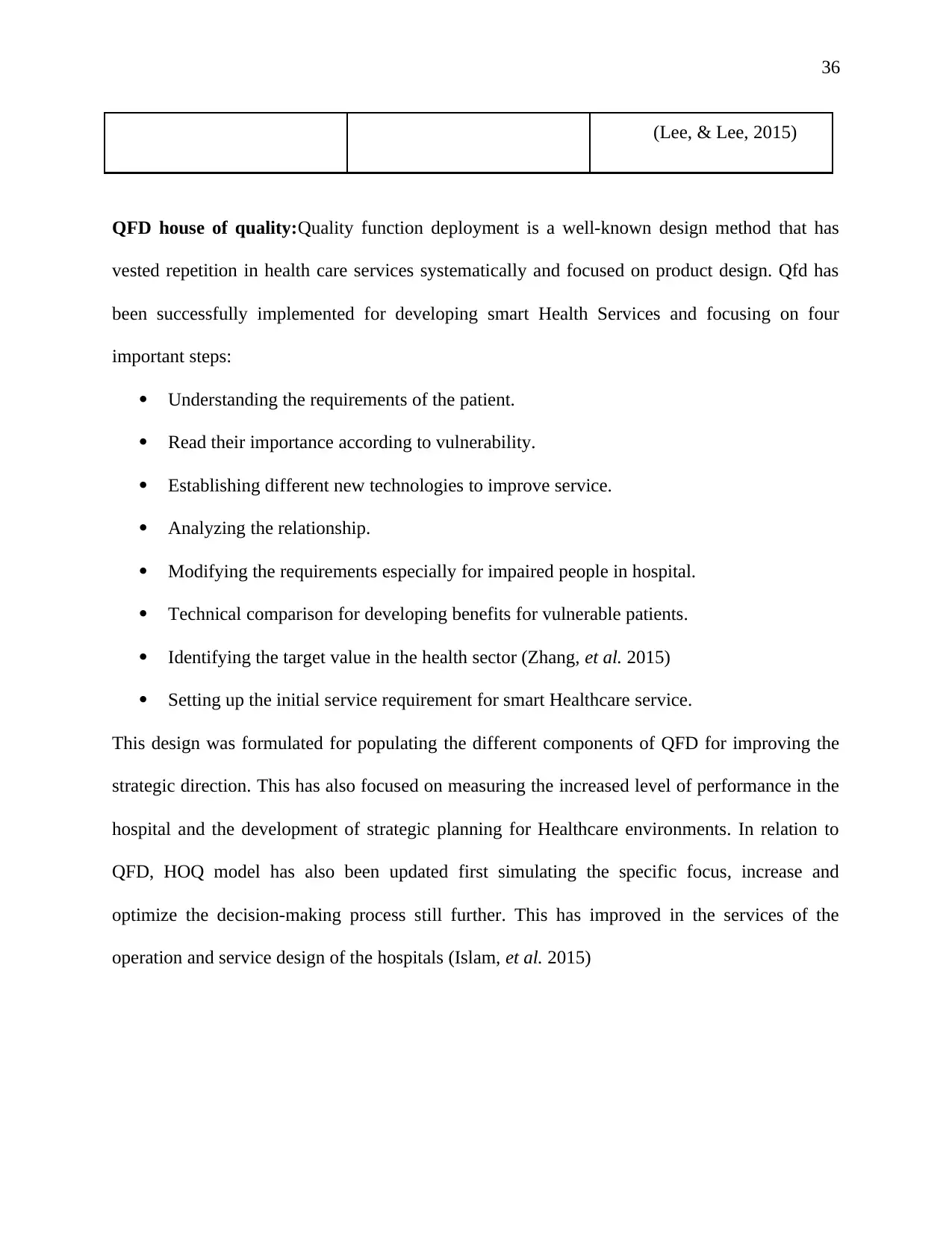
36
(Lee, & Lee, 2015)
QFD house of quality:Quality function deployment is a well-known design method that has
vested repetition in health care services systematically and focused on product design. Qfd has
been successfully implemented for developing smart Health Services and focusing on four
important steps:
Understanding the requirements of the patient.
Read their importance according to vulnerability.
Establishing different new technologies to improve service.
Analyzing the relationship.
Modifying the requirements especially for impaired people in hospital.
Technical comparison for developing benefits for vulnerable patients.
Identifying the target value in the health sector (Zhang, et al. 2015)
Setting up the initial service requirement for smart Healthcare service.
This design was formulated for populating the different components of QFD for improving the
strategic direction. This has also focused on measuring the increased level of performance in the
hospital and the development of strategic planning for Healthcare environments. In relation to
QFD, HOQ model has also been updated first simulating the specific focus, increase and
optimize the decision-making process still further. This has improved in the services of the
operation and service design of the hospitals (Islam, et al. 2015)
(Lee, & Lee, 2015)
QFD house of quality:Quality function deployment is a well-known design method that has
vested repetition in health care services systematically and focused on product design. Qfd has
been successfully implemented for developing smart Health Services and focusing on four
important steps:
Understanding the requirements of the patient.
Read their importance according to vulnerability.
Establishing different new technologies to improve service.
Analyzing the relationship.
Modifying the requirements especially for impaired people in hospital.
Technical comparison for developing benefits for vulnerable patients.
Identifying the target value in the health sector (Zhang, et al. 2015)
Setting up the initial service requirement for smart Healthcare service.
This design was formulated for populating the different components of QFD for improving the
strategic direction. This has also focused on measuring the increased level of performance in the
hospital and the development of strategic planning for Healthcare environments. In relation to
QFD, HOQ model has also been updated first simulating the specific focus, increase and
optimize the decision-making process still further. This has improved in the services of the
operation and service design of the hospitals (Islam, et al. 2015)
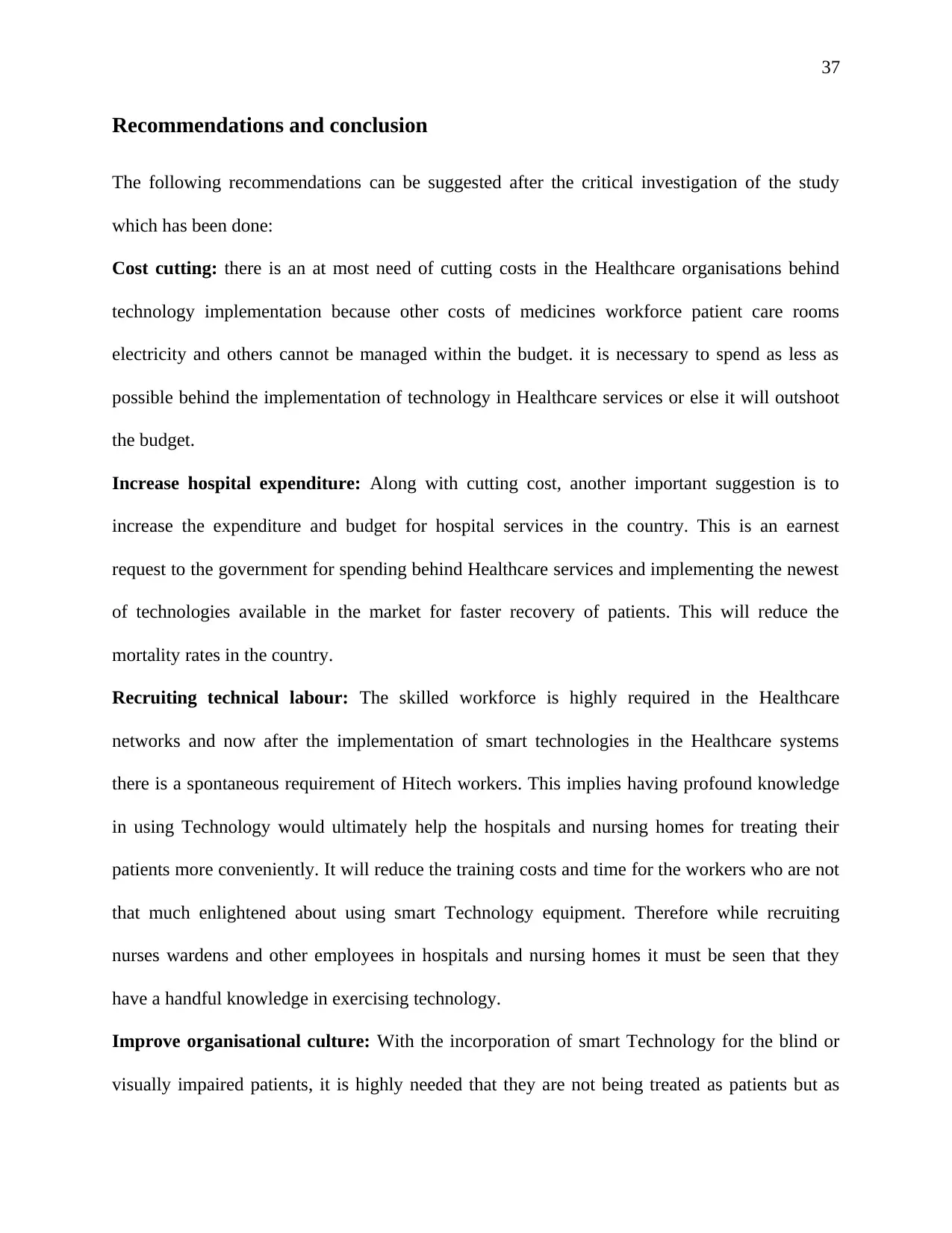
37
Recommendations and conclusion
The following recommendations can be suggested after the critical investigation of the study
which has been done:
Cost cutting: there is an at most need of cutting costs in the Healthcare organisations behind
technology implementation because other costs of medicines workforce patient care rooms
electricity and others cannot be managed within the budget. it is necessary to spend as less as
possible behind the implementation of technology in Healthcare services or else it will outshoot
the budget.
Increase hospital expenditure: Along with cutting cost, another important suggestion is to
increase the expenditure and budget for hospital services in the country. This is an earnest
request to the government for spending behind Healthcare services and implementing the newest
of technologies available in the market for faster recovery of patients. This will reduce the
mortality rates in the country.
Recruiting technical labour: The skilled workforce is highly required in the Healthcare
networks and now after the implementation of smart technologies in the Healthcare systems
there is a spontaneous requirement of Hitech workers. This implies having profound knowledge
in using Technology would ultimately help the hospitals and nursing homes for treating their
patients more conveniently. It will reduce the training costs and time for the workers who are not
that much enlightened about using smart Technology equipment. Therefore while recruiting
nurses wardens and other employees in hospitals and nursing homes it must be seen that they
have a handful knowledge in exercising technology.
Improve organisational culture: With the incorporation of smart Technology for the blind or
visually impaired patients, it is highly needed that they are not being treated as patients but as
Recommendations and conclusion
The following recommendations can be suggested after the critical investigation of the study
which has been done:
Cost cutting: there is an at most need of cutting costs in the Healthcare organisations behind
technology implementation because other costs of medicines workforce patient care rooms
electricity and others cannot be managed within the budget. it is necessary to spend as less as
possible behind the implementation of technology in Healthcare services or else it will outshoot
the budget.
Increase hospital expenditure: Along with cutting cost, another important suggestion is to
increase the expenditure and budget for hospital services in the country. This is an earnest
request to the government for spending behind Healthcare services and implementing the newest
of technologies available in the market for faster recovery of patients. This will reduce the
mortality rates in the country.
Recruiting technical labour: The skilled workforce is highly required in the Healthcare
networks and now after the implementation of smart technologies in the Healthcare systems
there is a spontaneous requirement of Hitech workers. This implies having profound knowledge
in using Technology would ultimately help the hospitals and nursing homes for treating their
patients more conveniently. It will reduce the training costs and time for the workers who are not
that much enlightened about using smart Technology equipment. Therefore while recruiting
nurses wardens and other employees in hospitals and nursing homes it must be seen that they
have a handful knowledge in exercising technology.
Improve organisational culture: With the incorporation of smart Technology for the blind or
visually impaired patients, it is highly needed that they are not being treated as patients but as
Paraphrase This Document
Need a fresh take? Get an instant paraphrase of this document with our AI Paraphraser
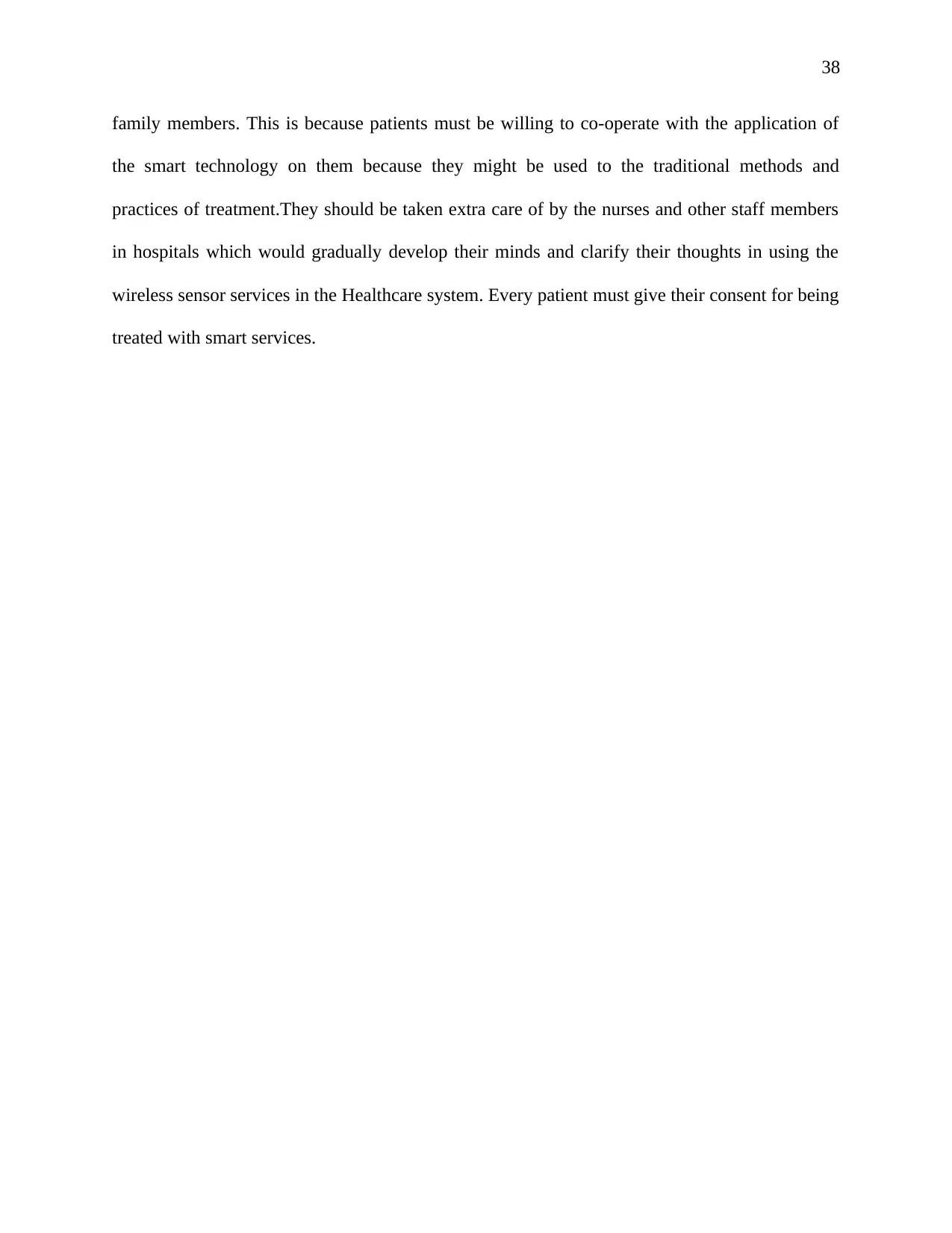
38
family members. This is because patients must be willing to co-operate with the application of
the smart technology on them because they might be used to the traditional methods and
practices of treatment.They should be taken extra care of by the nurses and other staff members
in hospitals which would gradually develop their minds and clarify their thoughts in using the
wireless sensor services in the Healthcare system. Every patient must give their consent for being
treated with smart services.
family members. This is because patients must be willing to co-operate with the application of
the smart technology on them because they might be used to the traditional methods and
practices of treatment.They should be taken extra care of by the nurses and other staff members
in hospitals which would gradually develop their minds and clarify their thoughts in using the
wireless sensor services in the Healthcare system. Every patient must give their consent for being
treated with smart services.
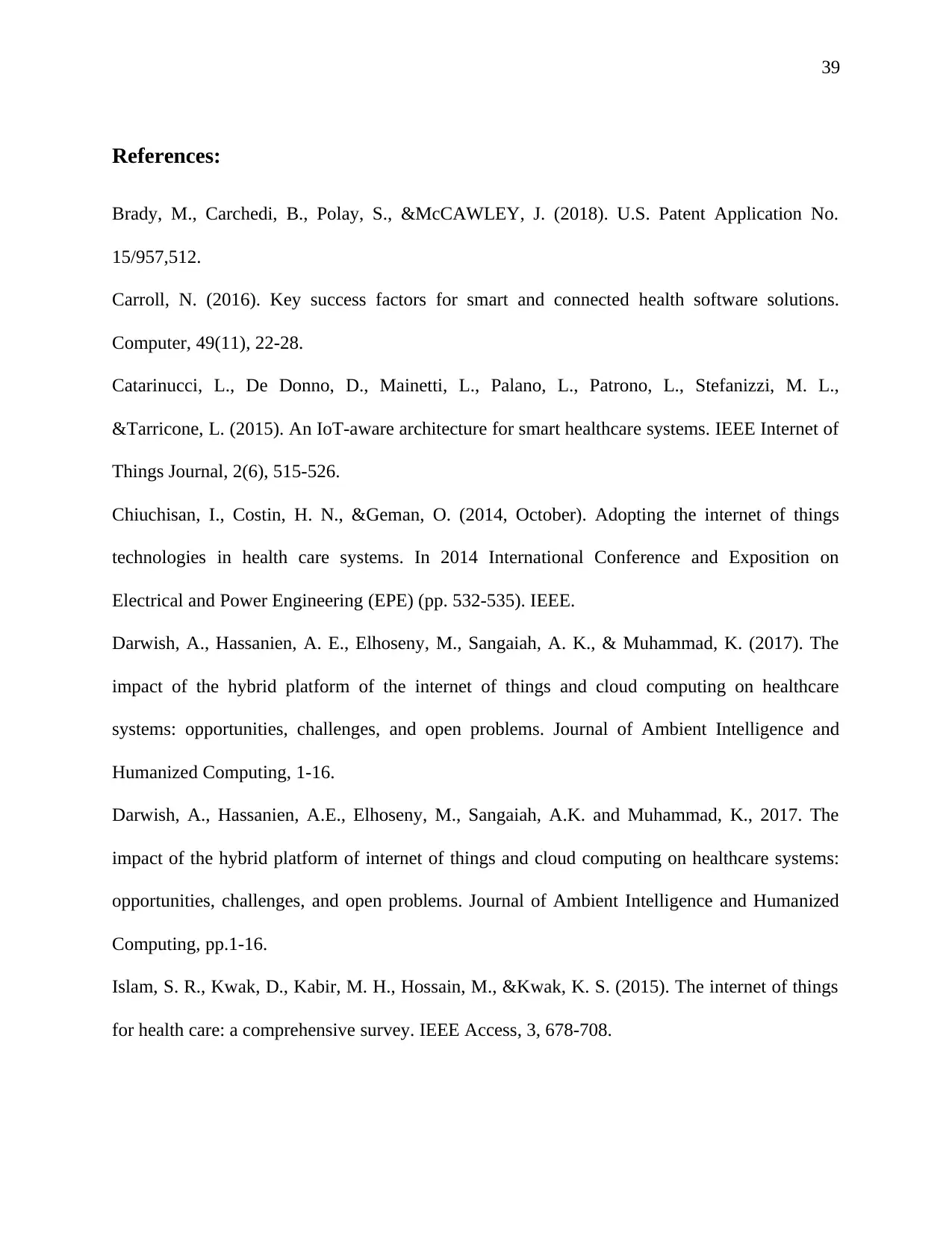
39
References:
Brady, M., Carchedi, B., Polay, S., &McCAWLEY, J. (2018). U.S. Patent Application No.
15/957,512.
Carroll, N. (2016). Key success factors for smart and connected health software solutions.
Computer, 49(11), 22-28.
Catarinucci, L., De Donno, D., Mainetti, L., Palano, L., Patrono, L., Stefanizzi, M. L.,
&Tarricone, L. (2015). An IoT-aware architecture for smart healthcare systems. IEEE Internet of
Things Journal, 2(6), 515-526.
Chiuchisan, I., Costin, H. N., &Geman, O. (2014, October). Adopting the internet of things
technologies in health care systems. In 2014 International Conference and Exposition on
Electrical and Power Engineering (EPE) (pp. 532-535). IEEE.
Darwish, A., Hassanien, A. E., Elhoseny, M., Sangaiah, A. K., & Muhammad, K. (2017). The
impact of the hybrid platform of the internet of things and cloud computing on healthcare
systems: opportunities, challenges, and open problems. Journal of Ambient Intelligence and
Humanized Computing, 1-16.
Darwish, A., Hassanien, A.E., Elhoseny, M., Sangaiah, A.K. and Muhammad, K., 2017. The
impact of the hybrid platform of internet of things and cloud computing on healthcare systems:
opportunities, challenges, and open problems. Journal of Ambient Intelligence and Humanized
Computing, pp.1-16.
Islam, S. R., Kwak, D., Kabir, M. H., Hossain, M., &Kwak, K. S. (2015). The internet of things
for health care: a comprehensive survey. IEEE Access, 3, 678-708.
References:
Brady, M., Carchedi, B., Polay, S., &McCAWLEY, J. (2018). U.S. Patent Application No.
15/957,512.
Carroll, N. (2016). Key success factors for smart and connected health software solutions.
Computer, 49(11), 22-28.
Catarinucci, L., De Donno, D., Mainetti, L., Palano, L., Patrono, L., Stefanizzi, M. L.,
&Tarricone, L. (2015). An IoT-aware architecture for smart healthcare systems. IEEE Internet of
Things Journal, 2(6), 515-526.
Chiuchisan, I., Costin, H. N., &Geman, O. (2014, October). Adopting the internet of things
technologies in health care systems. In 2014 International Conference and Exposition on
Electrical and Power Engineering (EPE) (pp. 532-535). IEEE.
Darwish, A., Hassanien, A. E., Elhoseny, M., Sangaiah, A. K., & Muhammad, K. (2017). The
impact of the hybrid platform of the internet of things and cloud computing on healthcare
systems: opportunities, challenges, and open problems. Journal of Ambient Intelligence and
Humanized Computing, 1-16.
Darwish, A., Hassanien, A.E., Elhoseny, M., Sangaiah, A.K. and Muhammad, K., 2017. The
impact of the hybrid platform of internet of things and cloud computing on healthcare systems:
opportunities, challenges, and open problems. Journal of Ambient Intelligence and Humanized
Computing, pp.1-16.
Islam, S. R., Kwak, D., Kabir, M. H., Hossain, M., &Kwak, K. S. (2015). The internet of things
for health care: a comprehensive survey. IEEE Access, 3, 678-708.
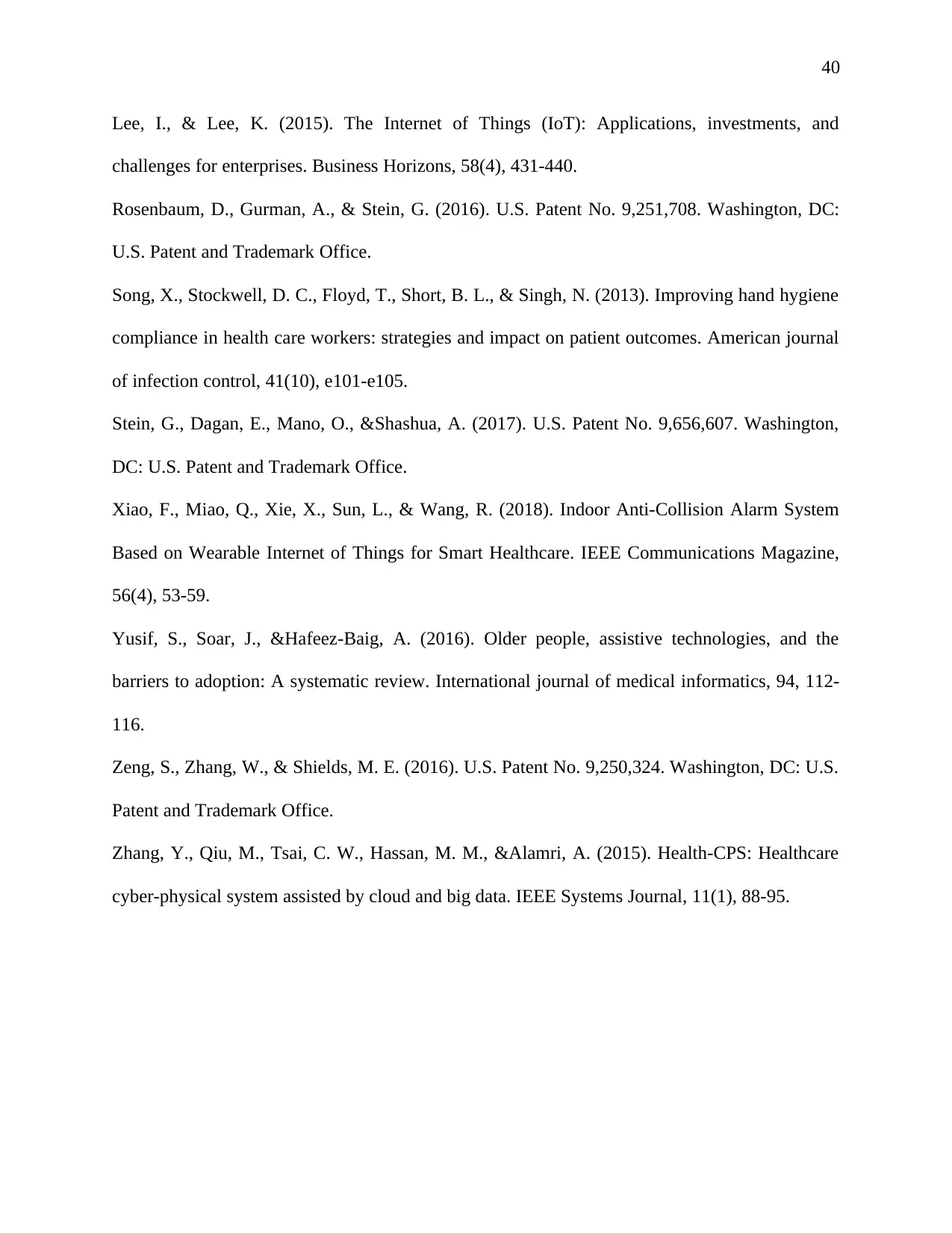
40
Lee, I., & Lee, K. (2015). The Internet of Things (IoT): Applications, investments, and
challenges for enterprises. Business Horizons, 58(4), 431-440.
Rosenbaum, D., Gurman, A., & Stein, G. (2016). U.S. Patent No. 9,251,708. Washington, DC:
U.S. Patent and Trademark Office.
Song, X., Stockwell, D. C., Floyd, T., Short, B. L., & Singh, N. (2013). Improving hand hygiene
compliance in health care workers: strategies and impact on patient outcomes. American journal
of infection control, 41(10), e101-e105.
Stein, G., Dagan, E., Mano, O., &Shashua, A. (2017). U.S. Patent No. 9,656,607. Washington,
DC: U.S. Patent and Trademark Office.
Xiao, F., Miao, Q., Xie, X., Sun, L., & Wang, R. (2018). Indoor Anti-Collision Alarm System
Based on Wearable Internet of Things for Smart Healthcare. IEEE Communications Magazine,
56(4), 53-59.
Yusif, S., Soar, J., &Hafeez-Baig, A. (2016). Older people, assistive technologies, and the
barriers to adoption: A systematic review. International journal of medical informatics, 94, 112-
116.
Zeng, S., Zhang, W., & Shields, M. E. (2016). U.S. Patent No. 9,250,324. Washington, DC: U.S.
Patent and Trademark Office.
Zhang, Y., Qiu, M., Tsai, C. W., Hassan, M. M., &Alamri, A. (2015). Health-CPS: Healthcare
cyber-physical system assisted by cloud and big data. IEEE Systems Journal, 11(1), 88-95.
Lee, I., & Lee, K. (2015). The Internet of Things (IoT): Applications, investments, and
challenges for enterprises. Business Horizons, 58(4), 431-440.
Rosenbaum, D., Gurman, A., & Stein, G. (2016). U.S. Patent No. 9,251,708. Washington, DC:
U.S. Patent and Trademark Office.
Song, X., Stockwell, D. C., Floyd, T., Short, B. L., & Singh, N. (2013). Improving hand hygiene
compliance in health care workers: strategies and impact on patient outcomes. American journal
of infection control, 41(10), e101-e105.
Stein, G., Dagan, E., Mano, O., &Shashua, A. (2017). U.S. Patent No. 9,656,607. Washington,
DC: U.S. Patent and Trademark Office.
Xiao, F., Miao, Q., Xie, X., Sun, L., & Wang, R. (2018). Indoor Anti-Collision Alarm System
Based on Wearable Internet of Things for Smart Healthcare. IEEE Communications Magazine,
56(4), 53-59.
Yusif, S., Soar, J., &Hafeez-Baig, A. (2016). Older people, assistive technologies, and the
barriers to adoption: A systematic review. International journal of medical informatics, 94, 112-
116.
Zeng, S., Zhang, W., & Shields, M. E. (2016). U.S. Patent No. 9,250,324. Washington, DC: U.S.
Patent and Trademark Office.
Zhang, Y., Qiu, M., Tsai, C. W., Hassan, M. M., &Alamri, A. (2015). Health-CPS: Healthcare
cyber-physical system assisted by cloud and big data. IEEE Systems Journal, 11(1), 88-95.
Secure Best Marks with AI Grader
Need help grading? Try our AI Grader for instant feedback on your assignments.
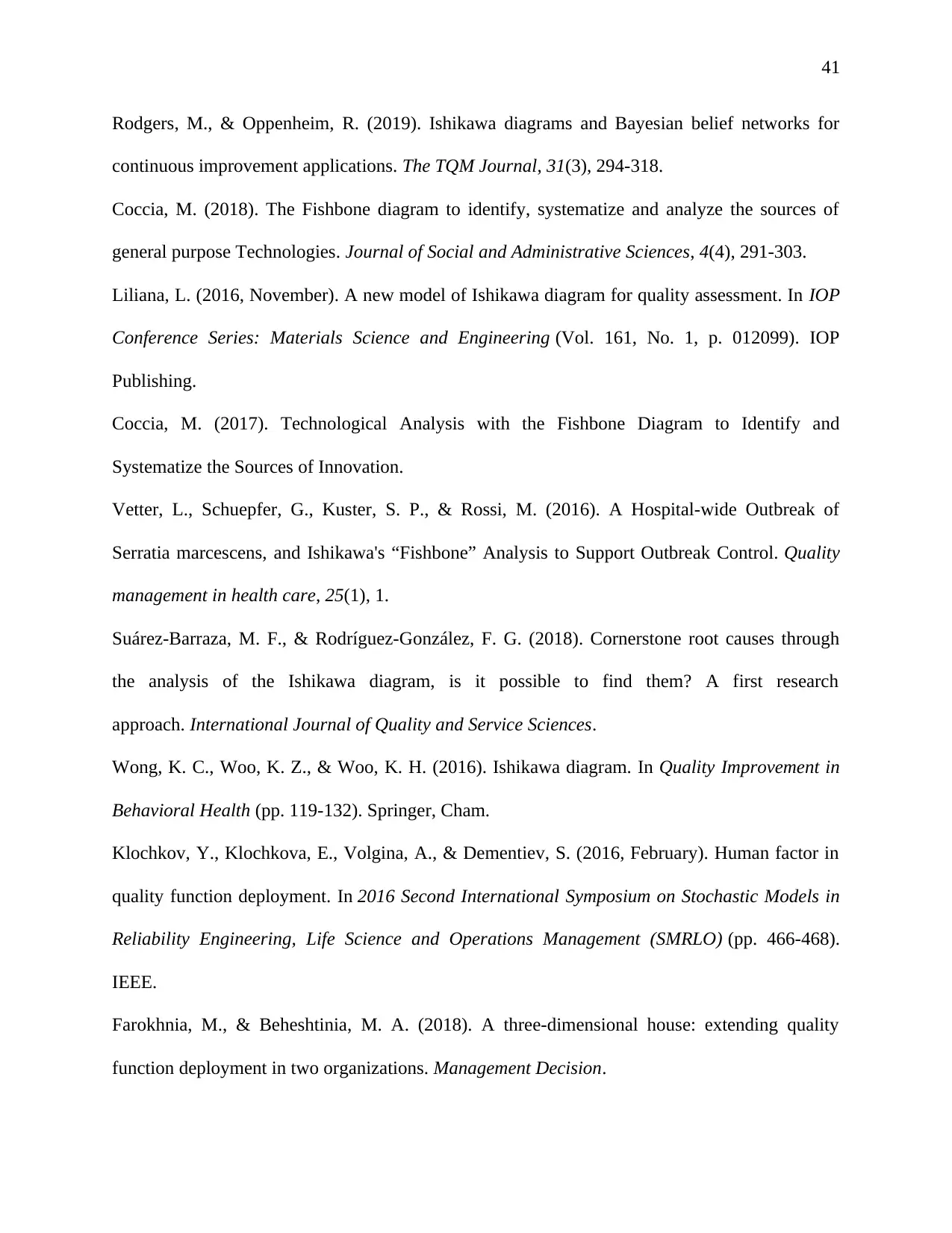
41
Rodgers, M., & Oppenheim, R. (2019). Ishikawa diagrams and Bayesian belief networks for
continuous improvement applications. The TQM Journal, 31(3), 294-318.
Coccia, M. (2018). The Fishbone diagram to identify, systematize and analyze the sources of
general purpose Technologies. Journal of Social and Administrative Sciences, 4(4), 291-303.
Liliana, L. (2016, November). A new model of Ishikawa diagram for quality assessment. In IOP
Conference Series: Materials Science and Engineering (Vol. 161, No. 1, p. 012099). IOP
Publishing.
Coccia, M. (2017). Technological Analysis with the Fishbone Diagram to Identify and
Systematize the Sources of Innovation.
Vetter, L., Schuepfer, G., Kuster, S. P., & Rossi, M. (2016). A Hospital-wide Outbreak of
Serratia marcescens, and Ishikawa's “Fishbone” Analysis to Support Outbreak Control. Quality
management in health care, 25(1), 1.
Suárez-Barraza, M. F., & Rodríguez-González, F. G. (2018). Cornerstone root causes through
the analysis of the Ishikawa diagram, is it possible to find them? A first research
approach. International Journal of Quality and Service Sciences.
Wong, K. C., Woo, K. Z., & Woo, K. H. (2016). Ishikawa diagram. In Quality Improvement in
Behavioral Health (pp. 119-132). Springer, Cham.
Klochkov, Y., Klochkova, E., Volgina, A., & Dementiev, S. (2016, February). Human factor in
quality function deployment. In 2016 Second International Symposium on Stochastic Models in
Reliability Engineering, Life Science and Operations Management (SMRLO) (pp. 466-468).
IEEE.
Farokhnia, M., & Beheshtinia, M. A. (2018). A three-dimensional house: extending quality
function deployment in two organizations. Management Decision.
Rodgers, M., & Oppenheim, R. (2019). Ishikawa diagrams and Bayesian belief networks for
continuous improvement applications. The TQM Journal, 31(3), 294-318.
Coccia, M. (2018). The Fishbone diagram to identify, systematize and analyze the sources of
general purpose Technologies. Journal of Social and Administrative Sciences, 4(4), 291-303.
Liliana, L. (2016, November). A new model of Ishikawa diagram for quality assessment. In IOP
Conference Series: Materials Science and Engineering (Vol. 161, No. 1, p. 012099). IOP
Publishing.
Coccia, M. (2017). Technological Analysis with the Fishbone Diagram to Identify and
Systematize the Sources of Innovation.
Vetter, L., Schuepfer, G., Kuster, S. P., & Rossi, M. (2016). A Hospital-wide Outbreak of
Serratia marcescens, and Ishikawa's “Fishbone” Analysis to Support Outbreak Control. Quality
management in health care, 25(1), 1.
Suárez-Barraza, M. F., & Rodríguez-González, F. G. (2018). Cornerstone root causes through
the analysis of the Ishikawa diagram, is it possible to find them? A first research
approach. International Journal of Quality and Service Sciences.
Wong, K. C., Woo, K. Z., & Woo, K. H. (2016). Ishikawa diagram. In Quality Improvement in
Behavioral Health (pp. 119-132). Springer, Cham.
Klochkov, Y., Klochkova, E., Volgina, A., & Dementiev, S. (2016, February). Human factor in
quality function deployment. In 2016 Second International Symposium on Stochastic Models in
Reliability Engineering, Life Science and Operations Management (SMRLO) (pp. 466-468).
IEEE.
Farokhnia, M., & Beheshtinia, M. A. (2018). A three-dimensional house: extending quality
function deployment in two organizations. Management Decision.
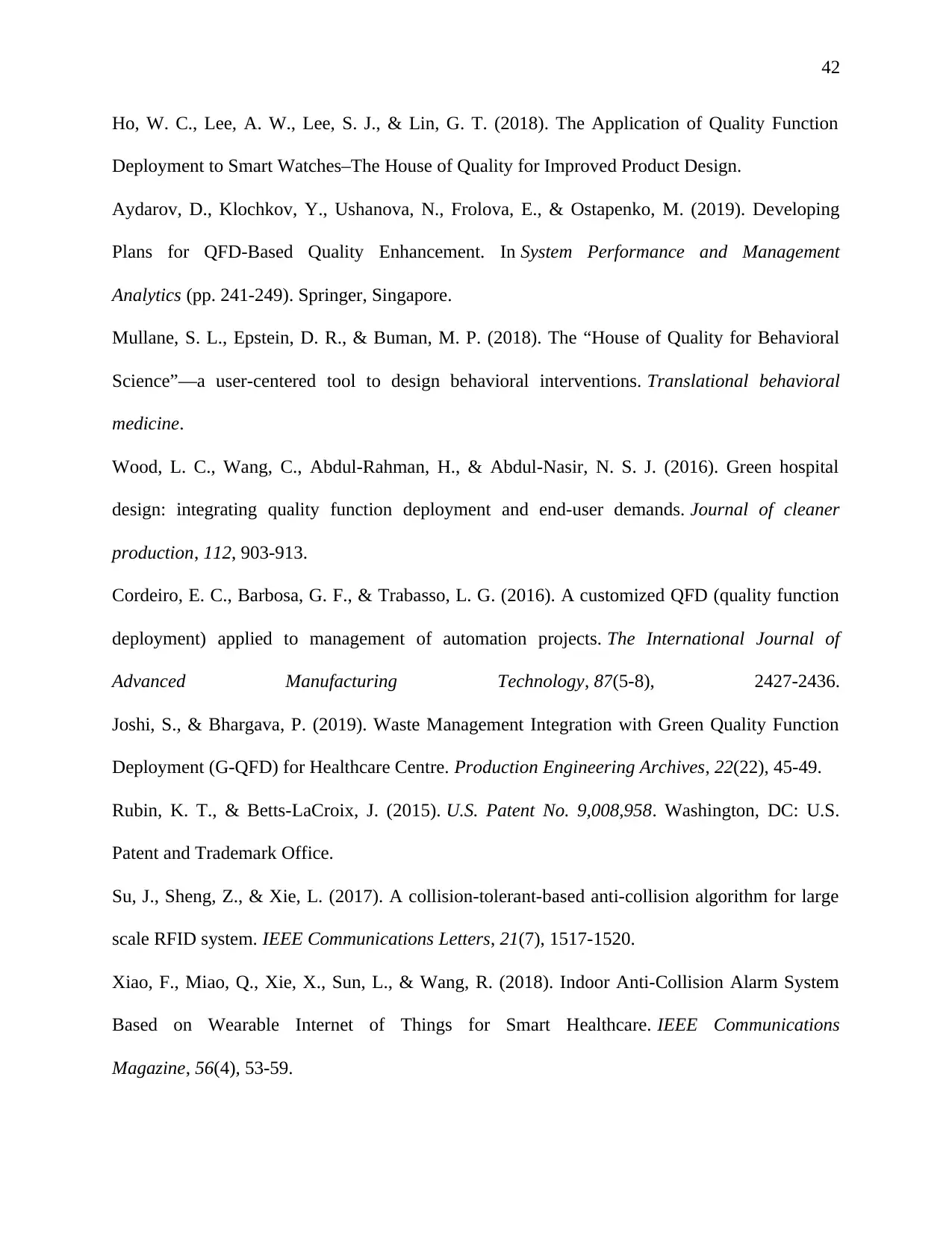
42
Ho, W. C., Lee, A. W., Lee, S. J., & Lin, G. T. (2018). The Application of Quality Function
Deployment to Smart Watches–The House of Quality for Improved Product Design.
Aydarov, D., Klochkov, Y., Ushanova, N., Frolova, E., & Ostapenko, M. (2019). Developing
Plans for QFD-Based Quality Enhancement. In System Performance and Management
Analytics (pp. 241-249). Springer, Singapore.
Mullane, S. L., Epstein, D. R., & Buman, M. P. (2018). The “House of Quality for Behavioral
Science”—a user-centered tool to design behavioral interventions. Translational behavioral
medicine.
Wood, L. C., Wang, C., Abdul-Rahman, H., & Abdul-Nasir, N. S. J. (2016). Green hospital
design: integrating quality function deployment and end-user demands. Journal of cleaner
production, 112, 903-913.
Cordeiro, E. C., Barbosa, G. F., & Trabasso, L. G. (2016). A customized QFD (quality function
deployment) applied to management of automation projects. The International Journal of
Advanced Manufacturing Technology, 87(5-8), 2427-2436.
Joshi, S., & Bhargava, P. (2019). Waste Management Integration with Green Quality Function
Deployment (G-QFD) for Healthcare Centre. Production Engineering Archives, 22(22), 45-49.
Rubin, K. T., & Betts-LaCroix, J. (2015). U.S. Patent No. 9,008,958. Washington, DC: U.S.
Patent and Trademark Office.
Su, J., Sheng, Z., & Xie, L. (2017). A collision-tolerant-based anti-collision algorithm for large
scale RFID system. IEEE Communications Letters, 21(7), 1517-1520.
Xiao, F., Miao, Q., Xie, X., Sun, L., & Wang, R. (2018). Indoor Anti-Collision Alarm System
Based on Wearable Internet of Things for Smart Healthcare. IEEE Communications
Magazine, 56(4), 53-59.
Ho, W. C., Lee, A. W., Lee, S. J., & Lin, G. T. (2018). The Application of Quality Function
Deployment to Smart Watches–The House of Quality for Improved Product Design.
Aydarov, D., Klochkov, Y., Ushanova, N., Frolova, E., & Ostapenko, M. (2019). Developing
Plans for QFD-Based Quality Enhancement. In System Performance and Management
Analytics (pp. 241-249). Springer, Singapore.
Mullane, S. L., Epstein, D. R., & Buman, M. P. (2018). The “House of Quality for Behavioral
Science”—a user-centered tool to design behavioral interventions. Translational behavioral
medicine.
Wood, L. C., Wang, C., Abdul-Rahman, H., & Abdul-Nasir, N. S. J. (2016). Green hospital
design: integrating quality function deployment and end-user demands. Journal of cleaner
production, 112, 903-913.
Cordeiro, E. C., Barbosa, G. F., & Trabasso, L. G. (2016). A customized QFD (quality function
deployment) applied to management of automation projects. The International Journal of
Advanced Manufacturing Technology, 87(5-8), 2427-2436.
Joshi, S., & Bhargava, P. (2019). Waste Management Integration with Green Quality Function
Deployment (G-QFD) for Healthcare Centre. Production Engineering Archives, 22(22), 45-49.
Rubin, K. T., & Betts-LaCroix, J. (2015). U.S. Patent No. 9,008,958. Washington, DC: U.S.
Patent and Trademark Office.
Su, J., Sheng, Z., & Xie, L. (2017). A collision-tolerant-based anti-collision algorithm for large
scale RFID system. IEEE Communications Letters, 21(7), 1517-1520.
Xiao, F., Miao, Q., Xie, X., Sun, L., & Wang, R. (2018). Indoor Anti-Collision Alarm System
Based on Wearable Internet of Things for Smart Healthcare. IEEE Communications
Magazine, 56(4), 53-59.
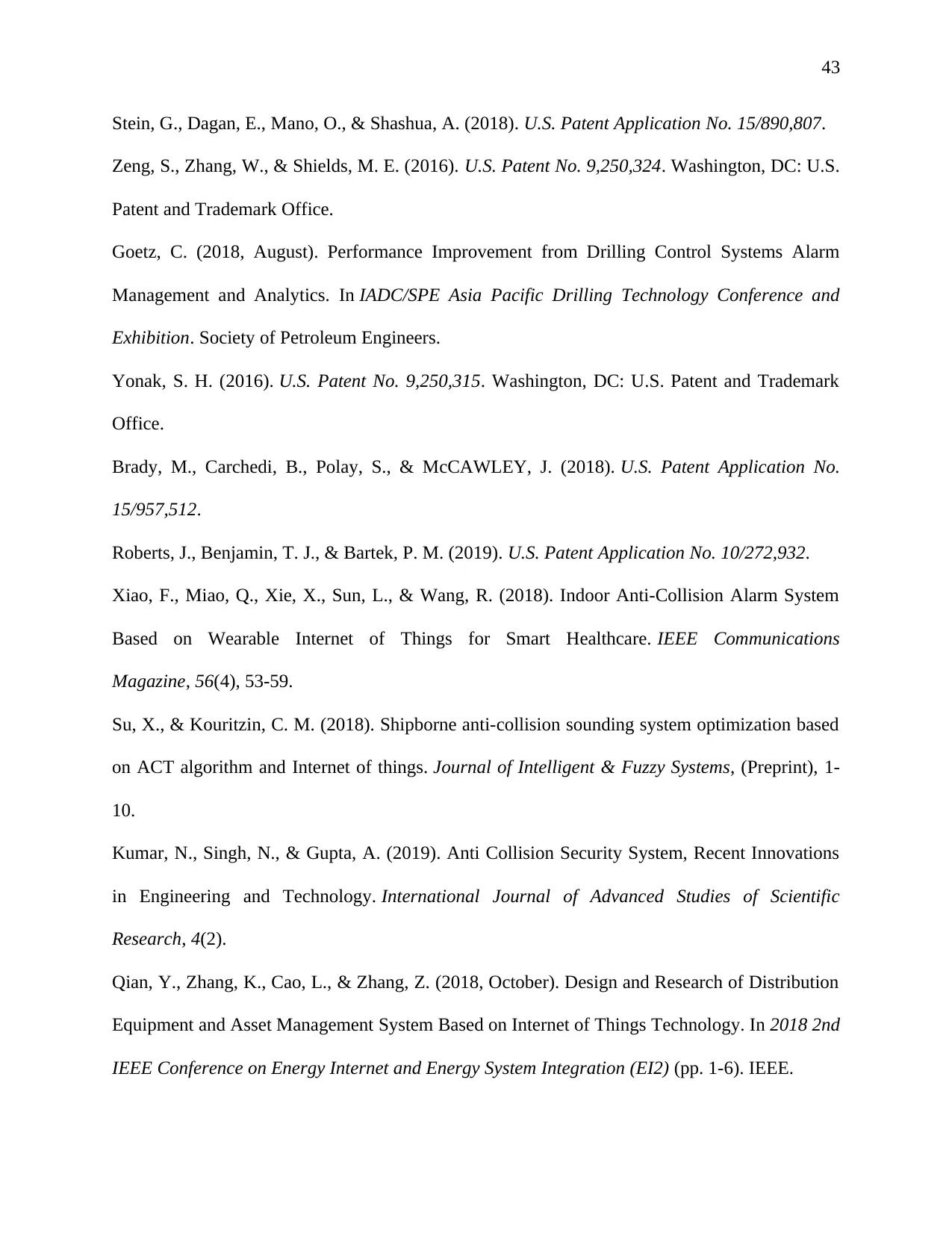
43
Stein, G., Dagan, E., Mano, O., & Shashua, A. (2018). U.S. Patent Application No. 15/890,807.
Zeng, S., Zhang, W., & Shields, M. E. (2016). U.S. Patent No. 9,250,324. Washington, DC: U.S.
Patent and Trademark Office.
Goetz, C. (2018, August). Performance Improvement from Drilling Control Systems Alarm
Management and Analytics. In IADC/SPE Asia Pacific Drilling Technology Conference and
Exhibition. Society of Petroleum Engineers.
Yonak, S. H. (2016). U.S. Patent No. 9,250,315. Washington, DC: U.S. Patent and Trademark
Office.
Brady, M., Carchedi, B., Polay, S., & McCAWLEY, J. (2018). U.S. Patent Application No.
15/957,512.
Roberts, J., Benjamin, T. J., & Bartek, P. M. (2019). U.S. Patent Application No. 10/272,932.
Xiao, F., Miao, Q., Xie, X., Sun, L., & Wang, R. (2018). Indoor Anti-Collision Alarm System
Based on Wearable Internet of Things for Smart Healthcare. IEEE Communications
Magazine, 56(4), 53-59.
Su, X., & Kouritzin, C. M. (2018). Shipborne anti-collision sounding system optimization based
on ACT algorithm and Internet of things. Journal of Intelligent & Fuzzy Systems, (Preprint), 1-
10.
Kumar, N., Singh, N., & Gupta, A. (2019). Anti Collision Security System, Recent Innovations
in Engineering and Technology. International Journal of Advanced Studies of Scientific
Research, 4(2).
Qian, Y., Zhang, K., Cao, L., & Zhang, Z. (2018, October). Design and Research of Distribution
Equipment and Asset Management System Based on Internet of Things Technology. In 2018 2nd
IEEE Conference on Energy Internet and Energy System Integration (EI2) (pp. 1-6). IEEE.
Stein, G., Dagan, E., Mano, O., & Shashua, A. (2018). U.S. Patent Application No. 15/890,807.
Zeng, S., Zhang, W., & Shields, M. E. (2016). U.S. Patent No. 9,250,324. Washington, DC: U.S.
Patent and Trademark Office.
Goetz, C. (2018, August). Performance Improvement from Drilling Control Systems Alarm
Management and Analytics. In IADC/SPE Asia Pacific Drilling Technology Conference and
Exhibition. Society of Petroleum Engineers.
Yonak, S. H. (2016). U.S. Patent No. 9,250,315. Washington, DC: U.S. Patent and Trademark
Office.
Brady, M., Carchedi, B., Polay, S., & McCAWLEY, J. (2018). U.S. Patent Application No.
15/957,512.
Roberts, J., Benjamin, T. J., & Bartek, P. M. (2019). U.S. Patent Application No. 10/272,932.
Xiao, F., Miao, Q., Xie, X., Sun, L., & Wang, R. (2018). Indoor Anti-Collision Alarm System
Based on Wearable Internet of Things for Smart Healthcare. IEEE Communications
Magazine, 56(4), 53-59.
Su, X., & Kouritzin, C. M. (2018). Shipborne anti-collision sounding system optimization based
on ACT algorithm and Internet of things. Journal of Intelligent & Fuzzy Systems, (Preprint), 1-
10.
Kumar, N., Singh, N., & Gupta, A. (2019). Anti Collision Security System, Recent Innovations
in Engineering and Technology. International Journal of Advanced Studies of Scientific
Research, 4(2).
Qian, Y., Zhang, K., Cao, L., & Zhang, Z. (2018, October). Design and Research of Distribution
Equipment and Asset Management System Based on Internet of Things Technology. In 2018 2nd
IEEE Conference on Energy Internet and Energy System Integration (EI2) (pp. 1-6). IEEE.
Paraphrase This Document
Need a fresh take? Get an instant paraphrase of this document with our AI Paraphraser
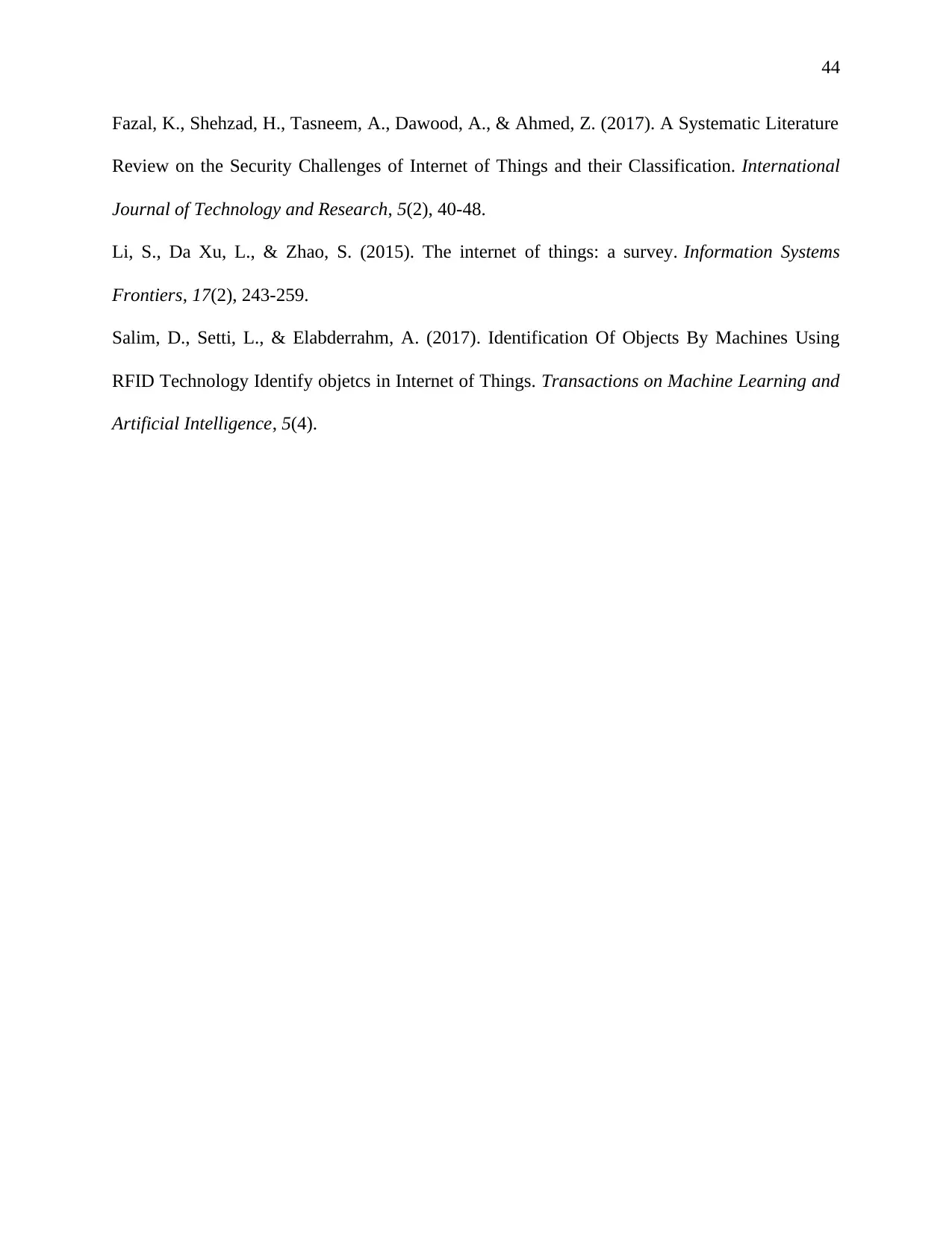
44
Fazal, K., Shehzad, H., Tasneem, A., Dawood, A., & Ahmed, Z. (2017). A Systematic Literature
Review on the Security Challenges of Internet of Things and their Classification. International
Journal of Technology and Research, 5(2), 40-48.
Li, S., Da Xu, L., & Zhao, S. (2015). The internet of things: a survey. Information Systems
Frontiers, 17(2), 243-259.
Salim, D., Setti, L., & Elabderrahm, A. (2017). Identification Of Objects By Machines Using
RFID Technology Identify objetcs in Internet of Things. Transactions on Machine Learning and
Artificial Intelligence, 5(4).
Fazal, K., Shehzad, H., Tasneem, A., Dawood, A., & Ahmed, Z. (2017). A Systematic Literature
Review on the Security Challenges of Internet of Things and their Classification. International
Journal of Technology and Research, 5(2), 40-48.
Li, S., Da Xu, L., & Zhao, S. (2015). The internet of things: a survey. Information Systems
Frontiers, 17(2), 243-259.
Salim, D., Setti, L., & Elabderrahm, A. (2017). Identification Of Objects By Machines Using
RFID Technology Identify objetcs in Internet of Things. Transactions on Machine Learning and
Artificial Intelligence, 5(4).
1 out of 44
Related Documents
Your All-in-One AI-Powered Toolkit for Academic Success.
+13062052269
info@desklib.com
Available 24*7 on WhatsApp / Email
![[object Object]](/_next/static/media/star-bottom.7253800d.svg)
Unlock your academic potential
© 2024 | Zucol Services PVT LTD | All rights reserved.





